



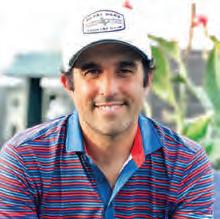

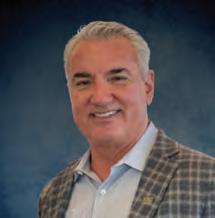


























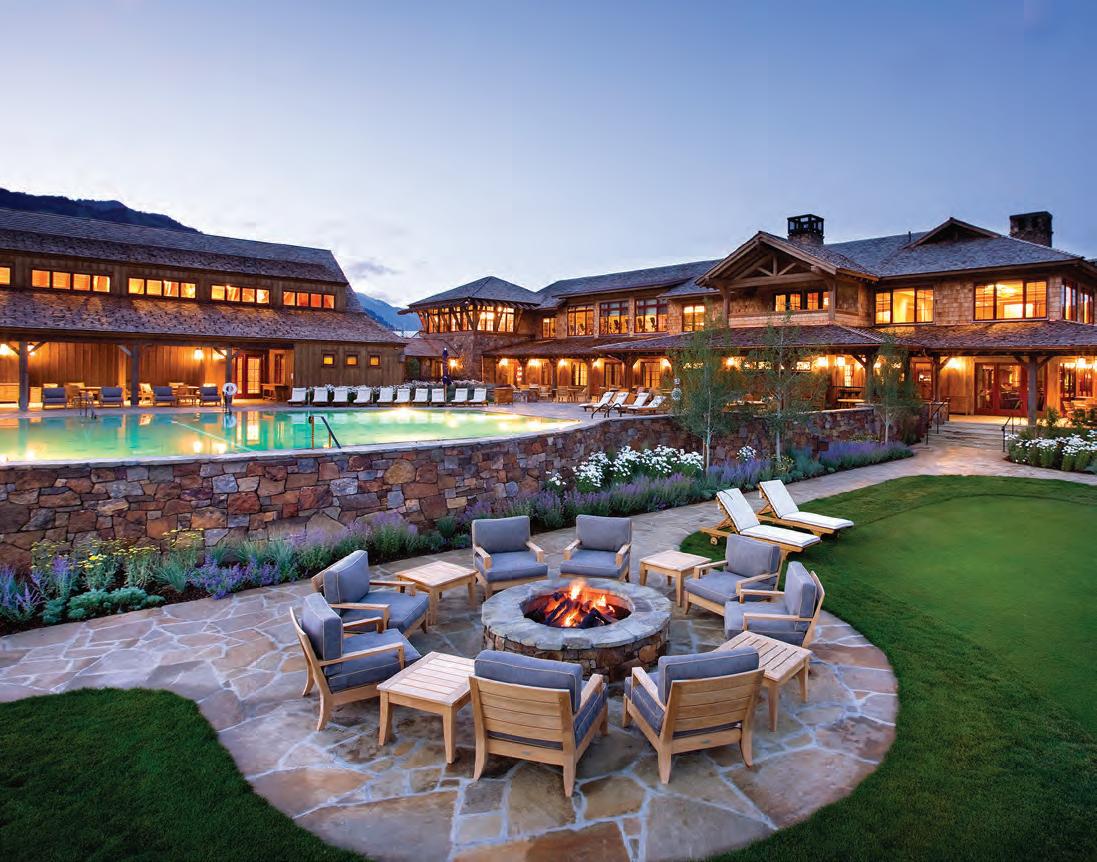













































Download the 2025 Leadership Report: Private Club Strategies to Navigate Shifting Landscapes

Today’s private clubs are evolving quickly—and the expectations of members, boards, and sta are rising along with them. Operational complexity, sta ing challenges, and the demand for seamless, connected experiences are shaping a new era of club leadership.
The 2025 Leadership Report from Clubessential o ers real-world insights into how successful clubs are meeting these challenges head-on. Drawing from discussions with club leaders and industry experts, the report outlines strategies for operational excellence, smarter technology adoption, and future-focused planning.
Inside, You’ll Learn:
•How integrated technology is strengthening member experiences across all touchpoints
•Why data-driven planning is becoming critical to operational decision-making
•How clubs are addressing sta ing strain through smarter systems and tools
•What leadership strategies are helping clubs prepare for generational shifts
The Next Era of Club Management... Building Excellence with Clubessential
Download your copy today to explore how forward-thinking clubs are adapting, thriving, and leading in today’s evolving landscape.

REPORT: How Today’s Omnichannel Model Impacts the Club Member and Sta Experience






“IF
YOU BUILD IT, THEY WILL COME.”
It’s one of the most iconic lines in film history. Kevin Costner walking through a cornfield in Field of Dreams, propelled by a voice and trusting a vision no one else could see. For private clubs, the field may be grass, clay, a hard court, or a hillside, but the message is the same: Build with purpose and people will come. Build with heart and they will stay.
That spirit is at the core of our July/August cover feature: Racquets Reimagined—a powerful, wide-lens look at the cultural shift reshaping racquet sports in private clubs. What was once tennis-only turf has evolved into a multigenerational heartbeat of connection and community. Eleven contributors, from general managers and racquet directors to associations, builders and search executives, share insights that make one thing clear: while golf remains the soul of the club for many, reimagined racquet facilities and programs are emerging as a strategic center of activity, connecting generations, driving engagement and redefining community.
At Boca West Country Club, a BoardRoom magazine Distinguished Club with ELITE status, GM/COO Matthew Linderman reveals how strategic investment in racquet facilities transformed member usage and retention.
At the Philadelphia Cricket Club, Alex Caldwell walks us through the role of racquet committees in future-proofing programming while maintaining tradition. Jarrett Chirico makes a compelling case that racquets are the most socially connective space on the property, touching more generations than any other area of the club.
From hiring strategies, certification pathways and open-play culture to padel’s meteoric rise, this package explores racquets not just as a sport— but as an identity, culture and strategy. As our industry looks to diversify offerings, attract new members and drive long-term loyalty, racquets provide an unexpected and exciting path forward. As every contributor affirms, this is no longer a trend, it’s a transformation.
Which brings us to the second half of that iconic line: If you build it, they will come. This issue is also home to one of our most-anticipated editorial packages of the year, our annual tribute to club architects and designers. These are the thought leaders behind the spaces that shape the member experience, often in ways that surpass square footage and furnishings. When you build or redesign a clubhouse or space that reflects your club’s culture, it’s not just about amenities, you’re telling members, “This place is for you.”
Those same principles apply whether you’re reimagining your outdoor spaces, crafting a modern wellness center, or blending future-forward

function with legacy architecture. In each case, form follows emotion. Build it well, and members won’t just join, they’ll belong. So, maybe the question isn’t if you should build; maybe it’s who are you building for?
And while you’re here, don’t miss our BoardRoom Briefs take on Happy Gilmore 2—a fun, smart look at what this pop culture sequel can teach us about club culture today. It’s proof that even in a tradition-rich industry, joy, authenticity and a little humor can drive engagement. Scan the QR code and take a look. BR

Heather Arias de Cordoba Editor | heather@boardroommag.com
Publisher/CEO
John G. Fornaro
Editor/Co-Publisher
Heather Arias de Cordoba
Editor Emeritus
Dave White
Copy Editor
Chryssoula Filippakopoulos
Innovative Ideas Editor
Chryssoula Filippakopoulos
APCD Executive Director
Bill Thomas
Editorial & Marketing Director
Dee Kaplan
Business Development
Joshua Nuzzi
Operations Director/Subscriptions
Krystal Seidel
Marketing Coordinator
Kaiya Arias de Cordoba
www.BoardRoomMagazine.com
www.apcd.com (949) 376-8889
Featured Columnists
Heather Arias de Cordoba
Matthew Blondell
Rick Coyne
Henry DeLozier
Contributing Writers
Skip Avery
Ronald Banaszak
Joanna Barclay
Bruce Barilla
Rita Barreto
Kris Butterfield Cance
Peter Cafaro
Alex Caldwell
Timothy N. Castor
Jarrett Chirico
Frank Cordeiro
John Corley
Colin Cowie
Michael Crandal
Brian Dillman
Adrian Karapici
Passion Graham
Angela Grande
Larry Hirsh
Dick Kopplin
Lynne LaFond DeLuca
Lori LeBard
Paul Levy
Matthew Linderman
Co-Founder/CEO
John G. Fornaro
President
Keith Jarrett
COO Distinguished Clubs and Distinguished Golf Destinations
Ron Banaszak, CCM, CCE
Chief Analyst
Frank Gore
Chief Technology Officer
Jeff Briggs
President, DGD
Paul Levy
CEO, DGD
Thomas Fitzgerald
Director, DGD
Christine Fitzgerald
Director, DGD
Gordon Welch, CCM, CHE
Executive Director
Bill Thomas
Director of Support
Joshua Nuzzi
www.DistinguishedClubs.com www.DistinguishedGolfDestinations.com


Steve Lovett
Ben Marton
Bill McMahon, Sr.
Dan Miles
Tito Moreno
Brock Orlowski
Tara Osborne
Erik B. Peterson
Zachary Platek
Clay Pryor
Kainoa Rosa
Corey Saban
Strategic Partners and Allied Associations







Patricia Sampson
Toni Shibayama
Len Simard
Craig J. Smith
Rick Snellinger
Mike Strauss
Michelle Tanzer
Milena Vidos
Richard Wade
Bryan Webb
AmirAli Zinati














PUBLISHER’S PERSPECTIVE
G.
Effective boards start with well-trained members. Proper orientation and ongoing education prepare leaders to govern strategically, avoid micromanagement and support management. This piece explores why training is essential, how to structure it and the impact it has on culture, trust and long-term club success.

Running a multimillion-dollar club without a plan is risky business. This piece outlines a process-driven approach to strategic planning, grounded in data, member engagement and accountability, to set long-term goals, align leadership and ensure the club’s future success.

The next generation of club leaders will need agility, vision, and a new skill set, blending data-driven strategy, digital fluency, sustainability, and adaptive leadership, to guide private clubs through shifting member expectations, generational change, and a rapidly evolving operational landscape.

In a fast-changing world, success belongs to those who can learn, unlearn, and relearn. This piece explores how curiosity, adaptability, and embracing new tools—like AI and data analytics—can transform club management, strengthen relationships, and keep leaders ahead in an ever-evolving industry.

MICHAEL G. SMITH
Strong onboarding traditions and clear behavioral standards are key to a respectful club culture. This piece outlines best practices for grievance and disciplinary committees, plus proactive strategies to prevent issues, ensuring fairness, consistency and harmony in today’s evolving private club environment.

Regulatory shifts under the new Trump administration—including revisions to the Waters of the United States rule, a pause on the 2024 independent contractor rule, and the halting of overtime rule changes— bring significant implications for private clubs navigating compliance, labor classification, and operational planning.

Assessments often spark groans, but what if the language changed? Inspired by Don Draper’s famous advice, this story explores how positioning them as aspirational, future-minded investments could elevate the conversation and rally members around the club’s long-term vision.

Outdoor enhancements can redefine the member experience, but they also bring construction risks that can derail budgets, timelines and satisfaction. This piece outlines how clubs can plan, contract and communicate effectively to manage those risks and deliver transformative spaces without costly surprises.

Amid tragedy and loss, The Beach Club’s celebration of beloved bartender Felicito became a powerful reminder of the emotional bonds, shared history and deep sense of community that define the true spirit of club life.




GOVERNANCE 72
Why Great Clubs Don’t Wing It By
Michael Crandal
CLUB CULTURE
Designing for Emotion, Not Just Elegance By
AmirAli Zinati
DISTINGUISHED CLUBS
Union League Club of Chicago By Ronald Banaszak
DISTINGUISHED GOLF DESTINATIONS 86 & 87
Hammock Beach Resort
Turning Stone Resort Casino By Ronald Banaszak
DISTINGUISHED GOLF DESTINATIONS 90
Distinguished Ideas from Properties in Asia
By Ronald Banaszak
ON THE FRONTLINES 94
It’s Not Just About ‘Serving’ But Becoming Part of the Club’s Legacy By Dave White, editor emeritus
CLUB UPDATE 99
Master Plan Sets Long-Term Vision for Pinehurst Country Club Special to BoardRoom
EXCELLENCE IN CLUB GOVERNANCE 100 & 101
Effective Club Governance
The Strategic Planning Committee By Henry DeLozier
DISTINGUISHED EXPERIENCE 102 From Back-of-House to Front-ofMind: The People-First Secret to Club Excellence By Colin Cowie
CLUB CULTURE 104 Who Cultivates Culture? By Kris Butterfield Cance
CULTURE AS CURRENCY 105 Labor or Leadership—Where Is the Real Shortage? By Passion Graham
CLUB CULTURE
The Heart of Hospitality By Lori LeBard
CULTURE CORNER
The Cultural Divide By Joanna Barclay
THIS MUCH I KNOW FOR SURE 126
It’s No Accident: Model Clubs Are Serious About Their Mission Statement; You Can Bet on It! By Dick Kopplin

Beyond the Ballroom: The Power of Outdoor Event Spaces in Private Clubs By
Lynne LaFond DeLuca
GREEN COMMITTEE 75


GCSAA Launches Video Training Series By Mike Strauss
GOLF COMMITTEE
Backstage Matters: Why Thoughtful Staff Spaces Are Essential to Club Success By Jacque Madison
EXECUTIVE COMMITTEE
2024 Top Private Club Presidents of the Year By Chryssoula Filippakopoulos
EXECUTIVE COMMITTEE
Workplace Culture at Private Clubs By Rita
Barreto
EXECUTIVE COMMITTEE 36 Pillars of Club Leadership: Inspiration and Trust By Skip Avery
EXECUTIVE COMMITTEE ............ 38 Interim or No Interim: Navigating Leadership Transitions in Clubs By Dan Miles and Zachary Platek
EXECUTIVE COMMITTEE ............ 40 Colonial Country Club’s $100 Million Master Plan Honors Its Past While Building Its Future By Frank Cordeiro and Henry DeLozier
INSURANCE COMMITTEE 80 If Disaster Strikes, Do You Have the Pieces in Place to Survive? By Toni Shibayama
INSURANCE COMMITTEE 81 Aftermath of the Palisades Fire Altadena Town & Country Club By Toni Shibayama
Your Golf Professional’s Office Should They Spend Time There? By Paul Levy
Importance of Grievance Committees By Michelle Tanzer and Ben Marton
From Ground to Cloud: What Hosting Shifts Mean for the Club Industry By John Corley
Sustainability –
On
Larry Hirsh
RESOURCES COMMITTEE 78 How to Nail Your Interview in the First Five Minutes By Tara Osborne
When the Mask Comes Off Real Leadership Begins By Corey Saban
Racquets Reimagined This 12-page exposé explores how visionary leaders, innovative programming and evolving member culture are transforming racquet sports into the heartbeat of private clubs— driving connection, wellness and multigenerational engagement far beyond the game itself.


John G. Fornaro is the publisher/CEO of BoardRoom, co-founder/CEO of DistinguishedClubs and Distinguished Golf Destinations, CEO of APCD and president of BoardRoom Institute. He can be reached at (949) 376-8889 or via email: johnf@apcd.com.
Effective boards are essential for a private club’s success and board member training is a key factor in achieving this success.
Board member training helps develop a pool of skilled and knowledgeable committee leaders to support the club’s governance process as well as its growth and success.
This includes ensuring that board members understand their roles and responsibilities, which helps reduce micromanagement and lets the club’s paid management focus on the club’s daily operations.
Often, potential board members, because of their work background and training, have spent time serving on corporate boards and now realize that club boards are a different breed of cat.
Private clubs organized as 501(c)(7) nonprofit organizations are governed by specific IRS regulations. These clubs must primarily serve the social and recreational needs of their members. They must also ensure that their income supports their exempt purposes, with limitations on non-member income.
“When club leaders are not thoroughly trained or knowledgeable on key issues impacting the club or have not been properly onboarded before their term begins, the results can be detrimental, not only to the day-to-day operations, but to the short- and long-term mission and vison of the club,” said Dave Schneider, GM/COO, Medinah Country Club, Medinah, IL.
“If the onboarding process is substandard and left unchecked for several years with new board members rolling on, it can truly change the direction of the club.
“Specific negative outcomes include, but are not limited to, derailment of club progress, member dissatisfaction, lack of trust in the board, decreased staff morale leading to high turnover and confusion amongst members and staff on ‘what the club aspires to be,’” he added.
“Most board members have good intentions and mean well. The ramifications of a poor board are (a) anarchic and antisocial behaviors among members, (b) inconsistent and ill-informed decision-making by the board, and (c) inconsistency in governance, which wastes club assets and demoralizes club members,” explained Henry DeLozier, principal with GGA Partners.
“Top-performing clubs develop a board training curriculum that is continuous and not one-and-done. Boards that sustain a continuous improvement approach to training focus on three principles of sound governance: (1) Board members are selected on clearly stated merits. (2) The board speaks with one voice and in writing. (3) There is a commitment to excellence in governing,” DeLozier continued.
“The impact of an uninformed, untrained and unwilling board member can be far-reaching—and often damaging. In some cases, it can even lead to the unnecessary termination of a general manager who is doing an excellent job under challenging circumstances,” claimed Gordon Welch, president of the Association of Private Club Directors (APCD), the parent association of BoardRoom Institute, BoardRoom’s education arm.
“These ‘rebel board members,’ as I call them, are the most dangerous individuals a board can have. They often arrive late to meetings, demand to be brought up to speed on information they should have reviewed beforehand and fumble through discussions while flipping through packets they haven’t read. Their inconsistent participation and lack of preparation create confusion, stall progress and erode the board’s effectiveness.
“This behavior is often where micromanagement begins. Because these individuals have not invested the time to truly understand the club, its operations and their role as board members, they fill the gaps in their knowledge by meddling in day-to-day matters that are not theirs to manage.
“In the end, it’s not just frustrating for the general manager; it’s detrimental to the health and culture of the club itself,” Welch asserted.
“As the adage explains, ‘When you don’t know where you are going, any road will take you there,’” offered Frank Cordeiro, COO/GM, the Colonial Country Club in Fort Worth, TX.
“In the absence of training, even well-intended board members will interfere with operations and good governance. Even the most talented and experienced board members must clearly understand their roles and responsibilities to contribute and reach their full potential.
“Roles, responsibilities, culture and organizational structure vary greatly from one organization to another, including forprofit companies. Clear communication and setting expectations early are essential in preparing new board members for success. Leaving them to navigate and learn on their own invites unnecessary risk and potential disappointment,” he added.
So, how do clubs initiate board member training? As partners, Dick Kopplin, Kurt Kuebler and Tom Wallace of Kopplin, Kuebler and Wallace (KK&W) say, “Board development should start at the committee level.
“The Leadership Development Committee should be selecting and developing all future board members as they enter their terms as committee members, which should be a prerequisite to joining the board.


RICK COYNE
Rick Coyne is founder and president of Club Mark Advisors and co-founder of the Professional Club Marketing Association. He can be reached via email: rcoyne@clubmark.com
On a recent P-10 Mastermind call, the members of our group were asked to share a quote, poem, book passage or song lyric that inspired them and in what way. The array of responses and the depth of discussion was, as always from this group, amazing. One, however, really resonated with me.
The quote was from Alvin Toffler in the book “Limitless Expanded Edition,” by Jim Kwik. It says, “The illiterate of the 21st century will not be those who cannot read and write, but those who cannot learn, unlearn and relearn.” Even now, as I rewrite it, so many thoughts flood my mind.
Essentially, the message was that from birth we are programmed in nearly everything we do, from eating habits to hygiene. As we grow and others begin to provide new learnings and lessons, we are again programmed based on the environment in which we reside.
data on member usage. It gets better. When your system allows demographic profiling of members by spending, clubs can drill directly into how every member demographic is using the club. How valuable is this to ensure retention?
According to Pew research, 24 percent of the U.S. population used ChatGPT in 2024; of those, 43 percent were under 30. Sixty-seven million Americans use AI on mobile devices. I’ve done a few educational programs on the subject and found a great deal of curiosity, but not a great deal of actual knowledge of facilitation. Again, looking at the traditional management processes, enormous benefits are available to those who avail themselves of the opportunity to relearn.
From complex income statement summaries to board, committee and staff meeting minutes, the level of sophistication and the options to make life easier are amazing. To
According to Pew research, 24 percent of the U.S. population used ChatGPT in 2024; of those, 43 percent were under 30. Sixty-seven million Americans use AI on mobile devices. The world is moving faster than ever. Technology is old after two years. Trying to do what you have always done without the many tools available to you will eventually wear you down. Take it from a senior member of the industry; it’s never too late to learn.
Fast forward to higher education, work environments and politics, where additional perspectives are offered sometimes requiring us to unlearn what we thought we knew and relearn based on new information. At one time our day-today environment was the key factor in how we were programmed.
In our current information age, with new and different concepts and technologies, change is at the speed of light. Internet tracking of consumer habits collects and analyzes data on how we interact with online platforms, such as websites, social media and online shopping platforms. This data can include demographics, browsing and usage history, search queries, purchase history and social media interactions. While traditional management perspectives often define these tracking opportunities as greeting members in the dining room, most point-of-sale systems can track important

reduce administration hours and convert that time to more attention to members, AI is a gift to those wishing to relearn.
I’d be remiss not to mention that unlearning and relearning isn’t just a phrase; it’s a sense of awareness. It’s an innate curiosity. It’s never accepting the status quo and a continuous quest to be the best.
The world is moving faster than ever. Technology is old after two years. Trying to do what you have always done without the many tools available to you will eventually wear you down. Take it from a senior member of the industry; it’s never too late to learn.
Oh, by the way, unlearning and learning does not need to stop with business applications. It can work wonders on our attitudes, rebuilding friendships and relationships and, by the grace of God, just might make a difference in our world.
Stay curious. BR

Elevate your club’s potential by engaging PGA of America Golf Professionals dedicated to continuous growth in essential career paths.

“IF YOU DON’T LIKE WHAT’S BEING SAID, CHANGE THE CONVERSATION.”
What leaps to mind when you hear the word assessment? Do you audibly groan? Does your stomach turn over?
My guess is that your reaction is a negative one … ugh! Why? One definition of assessment is “an official valuation of property for the purpose of levying a tax; an assigned value.” And there’s that T word—tax. Ugh again! Is there anyone who looks forward to paying taxes? I surely don’t. Because a tax represents more money coming out of my pocket.
NANCY M. LEVENBURG
Nancy M. Levenburg, PhD, professor emerita in management at Grand Valley State University’s Seidman College of Business in Grand Rapids, president of Edgewater Consulting, a university professor and a member of Spring Lake Country Club in Spring Lake, MI. She can be reached at (616) 821-5678 or levenbun@gvsu.edu
said, change the conversation.” Ninety-two episodes of “Mad Men” aired from 2007 to 2015, but Draper’s advice is not only brilliant but still relevant today.
In fact, Don Draper would undoubtedly be deliriously celebrating (with a martini in hand) one private club’s recent repositioning or “rebranding” of an assessment. They’re calling it an aspirational capital dues charge. “These funds will be separately allocated and used solely for future-focused projects and enhancements designed to elevate the club experience and ensure our country club remains vibrant and relevant for generations to come.” Don Draper himself couldn’t have phrased this any better.
Don Draper would undoubtedly be deliriously celebrating one private club’s recent “rebranding” of an assessment. They’re calling it an aspirational capital dues charge. “These funds will be separately allocated and used solely for future-focused projects and enhancements designed to elevate the club experience and ensure our country club remains vibrant and relevant for generations to come.” Don Draper himself couldn’t have phrased this any better.
Another definition of assessment is “the art of assessing; appraisal; evaluation.” Assessing involves measuring and judging the value, character, etc., of something. Assessment is a word that’s frequently used in education. In fact, it’s become somewhat of a buzzword in academe and is often tied to accountability. Educational assessment (per my AI overview) is “a systematic process of gathering and using evidence to improve student learning and educational programs.”
And how is that done? It’s accomplished by using quizzes, tests, exams, etc., to measure students’ learning. (It’s done in other ways, too.) But when students hear the word assessment, they think it means tests. Ugh. And there’s another T word— test. No student relishes taking tests, least of all pop quizzes. (In fact, that’s one instructional tool that will send students running to ratemyprofessors.com to post scathing reviews.)
So, what’s the reaction of your private club members when they hear the word assessment? Is it one of joy and excitement? Are your club members scrambling to get to their checkbooks? My guess is not.
As Don Draper (the protagonist of the AMC television series “Mad Men,” which focused on a 1960s advertising agency drama and antics) said, “If you don’t like what’s being
Just look at all the positive words and connotations in that one sentence:
• Aspirational. It is a hopeful word; it conveys positive, forward-focused plans and actions.
• Future-focused. Again, there’s a positive association with life in the future; things will be getting better … and better!
• Enhancements. An enhancement is an improvement; it’s something to look forward to.
• Elevate. Elevate = heighten, increase, raise up, lift up … all good and positive things. Onward and upward!
• Vibrant. Wow … is this a fabulous term or what? This club promises to be energetic and lively, dynamic and spirited. In other words, anything but dull.
Don Draper would also approve of calling the assessment an aspirational dues charge. Why? Dues are what we pay to be a member of a club or organization; we expect to pay them… it’s simply the price of membership. No gripes there. And as Don Draper also said, “You tell them the next thing will be better because it always is.” So what’s Don Draper’s grade on this club’s assessment rebranding? An A+. BR

Take the next step in your club’s digital journey.
Jonas Hosting gives your club secure, scalable access to your systems—anytime, anywhere—plus automatic updates and expert management.
With Jonas Hosting, you’ll enjoy:
• Lightning-fast access to club data, anywhere, anytime
• Enterprise-grade security and SOC2 compliance
• Early access to our modernized interface—designed to simplify workflows
• Mobile-ready tools like the Jonas Staff App
• Automated updates, backups, and zero maintenance headaches
Join the hundreds of clubs already transforming operations with Jonas Hosting. It’s more than infrastructure — it’s the foundation of your modernization journey.





HENRY DELOZIER
Henry DeLozier is a partner at GGA Partners. He can be reached via email: henry.delozier@ggapartners.com
“Let me get this right … we’re running a business using other people’s money and we have no plan ... who does that? Who runs a multimillion-dollar business with no plan?” The frustration crackling in the club member’s voice speaks for many members. Now is the time for strategic planning in private clubs.
Strategic planning is the process for determining longterm goals and the resources needed to achieve these goals. A proper strategic plan confirms the club’s purpose and the goals, objectives and tactics the club must execute to implement and sustain the strategic aims.
Three keys drive successful strategic planning in clubs:
1. Use a process-driven approach
2. Mobilize the club’s best thinkers
3. Data-guided research is essential.
Stephen Covey advised to “begin with the end in mind” in his business guidance book, “The 7 Habits of Highly Effective People,” published in 1989. The purpose of successful strategic planning is to provide a balanced view of the coming three-to-five-year business cycle with specific goals and objectives.
Three benefits that arise from a process-driven approach to strategy are:
Timeliness: Board terms in private clubs are commonly three years, with terms of one or two years for board presidents. As such, most club boards are in a hurry to develop and implement a strategy. Moreover, clubs evolve quickly enough that the process is essential to keep planning on a timely track.
There is an urgency to strategic planning now as members lose interest and, in some cases, forget that a strategic planning initiative is underway. The planning process must include five critical elements:
1. Market analysis: Among the components that make up the market analysis section of the plan are:
a. External market: Knowing what factors are impacting the club from the outside is essential. Every strategic plan should study demographic factors of the market, including consumer confidence, household income, educational attainment and employment, in addition to a competitive analysis of nearby and comparable clubs.
b. Internal market: The spirit of the club’s members is discerned through member-facing focus groups supported by an attitudinal survey of members. This data supports a time-relevant analysis of strengths, weaknesses, opportunities and threats (SWOT) alongside reference to the club’s aspirations and results being sought (SOAR analysis).
The internal market guides the planning for the club’s purpose and self-description. It answers the question, “Who are we?” Purposeful market analysis relies upon data over supposition. Too many clubs base strategic decisions on second- and third-hand anecdotes.
2. Financial analysis: A strategy that is not supported by financial analysis of capability, as in access to funds, and financial capacity is simply “pie in the sky” that has no place in fiduciary documents. Financial analyses should address capital needs, sources and uses of funds, and operational funding requirements that keep the club up to expected standards of care and upkeep.
3. Governance evaluation: Sound strategy and trusted governance go arm in arm. Club leaders should rely on “Private Club Governance: A Handbook of Principles and Best Practices,” the second edition of which was released in April by the National Club Association and Club Management Association of America. Among the most important principles are:
a. The board speaks with one voice and in writing
b. Clubs now rely on board and operating committees focused on the workflow required by the board and the manager
c. Boardroom confidentiality is essential to discreet governance in matters of private information, such as compensation and disciplinary matters.
4. Brand and communications analysis: Most club leaders overlook the significant value of their clubs’ brand value and reach. Brand management is a primary duty of strategy because market differentiation is a by-product of thoughtful strategy.
One of the most common complaints of club members is inadequate or poor communication from the club board. An

BOARDROOM BASICS AND BEYOND

MICHAEL G. SMITH
Michael G. Smith, CCM, CCE, ECM is a search and consulting executive with Kopplin Kuebler & Wallace and can be reached michael@kkandw.com.
As I advanced in my career during the late 1990s and early 2000s, I was fortunate to witness some of the most effective practices in new member selection and onboarding firsthand, where members were truly being welcomed into their club. A new member’s sponsor played an active role in integrating them and their family into the club community. These sponsors acted as mentors, helping new members understand the club’s traditions, rules and expectations. They were ambassadors of the club’s values, placing special emphasis on personal conduct and respect, both toward other members and club staff.
Over time, however, these onboarding traditions began to fade. Following the Great Recession and the surge in club memberships during the pandemic, many clubs moved toward a more expedited onboarding approach. This “fast-track” model often lacked the formal structure and care of the past. As a result, some clubs have experienced a noticeable increase in behavioral and disciplinary issues.
In a recent presentation I gave to a chapter, one of the most discussed topics was how to handle “bad behavior” at private clubs. Based on conversations with several leading clubs across the country, I’ve compiled a list of best practices, especially around the formation and management of grievance and disciplinary committees.
KEY CONSIDERATIONS WHEN FORMING AND MANAGING COUNTRY CLUB GRIEVANCE OR DISCIPLINARY COMMITTEES
In the exclusive environment of private clubs, where members share amenities, traditions and social privileges, maintaining a respectful and harmonious atmosphere is vital. While most clubs strive for unity, disputes can and do arise, ranging from behavioral concerns to disagreements over membership privileges. To manage such matters fairly, many clubs establish grievance or disciplinary committees.
These committees play a crucial role in maintaining standards and resolving conflicts, but their success depends on both preventative strategies and structured practices. Before establishing a committee, consider these core principles:
Impartiality: Committees must operate without bias to maintain fairness.
Transparency: Clear procedures help members understand the grievance process.
Confidentiality: Protect member privacy and reputations throughout.
Consistency: Ensure decisions are equitable and applied uniformly.
Accountability: Final decisions should be subject to board oversight or an independent review.
BEST PRACTICES FOR THE FORMATION OF GRIEVANCE AND DISCIPLINARY COMMITTEES
1. Select members thoughtfully
• Qualifications: Choose members with sound judgment, familiarity with club rules and, ideally, experience in conflict resolution.
• Diversity: A mix of age, gender and background ensures a range of perspectives.
• No conflicts of interest: Members should not have personal ties to involved parties.
2. Define roles and responsibilities
• Appoint a chairperson to guide meetings and enforce procedures.
• Assign roles such as fact finder, recordkeeper and decision-maker to ensure clarity and efficiency.
3. Set term lengths
• Stagger terms (e.g., one to three years) to allow for both continuity and fresh input.
4. Provide training
• Train members on ethics, procedural fairness, confidentiality and relevant laws. Regular refreshers help reinforce these standards.
A well-crafted charter brings structure and transparency to committee operations. It should include the following components:
1. Purpose and objectives
• Clearly define the committee’s mission and intention, whether it addresses grievances, disciplinary matters or both.
2. Scope of authority
• Outline the types of issues the committee can review and whether it has the authority to impose disciplinary actions or only make recommendations to the board.
3. Grievance filing procedures
• Specify how members may submit grievances, what documentation is required and relevant timelines or deadlines for submission.
4. Hearing procedures
• Establish the format of hearings (e.g., in person or virtual), and outline procedures for presenting evidence, questioning witnesses and maintaining order.
5. Decision-making process
• Define how decisions are made, such as by majority vote, and specify any quorum requirements.
6. Appeals process
• Include a fair and transparent process for appeals, typically handled by the board, to ensure accountability and due process.
While formal committees are necessary, prevention is even more powerful. Consider implementing these proactive measures:
1. Set clear behavioral expectations
• Establish and memorialize a code of conduct that communicates behavioral standards rooted in respect toward members and staff.




Whether you’re managing four courts or forty, Cobalt gives your team total control—and your members the seamless experience they expect.
Part of Cobalt’s all-in-one club platform, our court tools are purpose-built – not just an add-on.


Real-time booking for members and staff

Direct clinic registration from the court schedule
Effortless charges—no switching to POS
Easy setup for multi-sport courts, pros, and programs
Smart usage insights to guide decisions
Fully connected to POS, accounting, and your entire club ecosystem


















Scan Here to Schedule Your Demo Today!


Tennis.Pickleball.Paddle.Clinics. And More. No toggling between modules. No clunky workarounds. Just smarter racquet operations.



















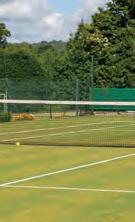








Ready to take your courts to the next level?

By Heather Arias de Cordoba, editor
There’s a quiet revolution happening in private clubs, and it’s unfolding on the racquet courts. What was once the exclusive domain of tennis has evolved into a multigenerational epicenter of movement, connection and culture. Racquets Reimagined, our July/August cover package, brings together visionaries and thought leaders who are redefining what racquet sports mean to club life, and why that matters now more than ever.
Leading off is Matthew Linderman, GM/COO of Boca West Country Club, a BoardRoom magazine Distinguished Club with ELITE status. He shares how the club’s capital improvements transformed racquet spaces into vibrant lifestyle hubs. With 49 courts and two dedicated clubhouses, Boca West has made racquet sports a pillar of growth, wellness and member retention, not just a side amenity.
Alex Caldwell, head racquets professional at Philadelphia Cricket Club, highlights another vital element: the racquets committee. These volunteer-led groups act as stewards of the member experience, ensuring programming and communication align with evolving needs. Caldwell shows how thoughtful leadership can bridge tradition and innovation, creating space for new racquet sports like pickleball and padel while preserving tennis culture.
Culture and community take center court in Jarrett Chirico’s piece on racquets as a driver of belonging. At Royal Oaks Country Club, racquets aren’t just played, they’re lived. Chirico argues that no area of the club has more daily touchpoints across generations, and that passionate professionals, not just pristine courts, make racquets the soul of the club.
For clubs hiring racquets professionals, Brian Dillman, CEO of the Racquet Sports Professionals Association (RSPA), outlines why certification matters more than ever. He envisions coaching as a lifelong, fulfilling career, not a side gig.
For clubs exploring padel (rhymes with saddle), Tito Moreno, founder of AMET International, offers a strategic lens on design, rollout and long-term growth. With more than 15 years in the sport, he breaks down how padel’s rise is reshaping how members connect, compete and socialize.
Brock Orlowski, director of racquet sports at Fort Wayne Country Club, champions racquets as a multigenerational connector. His piece calls for adaptable leadership that cultivates community and brings families together through inclusive, flexible programming.
Kainoa Rosa, director of racquets at Palm Beach Country Club, explores the evolving role of professionals in Open Play. The right balance of staff engagement and member leadership, he notes, can make or break the member experience.
Len Simard, search executive with Kopplin Kuebler & Wallace, makes a compelling case for what’s next: better compensation,
meaningful leadership development, and clear growth pathways. Backed by industry data, his message is clear, investing in racquets professionals is essential to sustaining momentum and earning longterm loyalty.
On the coaching front, Milena Vidos, vice president of the Professional Tennis Registry (PTR) and the Professional Pickleball Registry (PPR), reminds us that quality coaching is foundational to the member experience. From ADM principles to holistic development, Vidos urges clubs to invest in coaches who not only teach, but inspire.
Richard Wade, director of squash and padel at Philadelphia Cricket Club, reminds us that tradition and innovation aren’t opposites— they’re partners. His article on blending squash, padel and tennis shows how clubs can honor the past while future-proofing programs through technology, coach education and inclusive design.
The feature concludes with insights from the USTA, whose goal of 35 million tennis players by 2035 underscores the rising importance of racquet sports in American recreation and wellness.
In the end, these 11 stories share one powerful truth: racquet sports are no longer just about the game. They’re about identity, connection, and community. The clubs that treat racquets as strategy, not just space, will be the ones that thrive in the decades to come. BR

“On behalf of the Toronto Lawn Tennis Club, one of Canada’s oldest and most prestigious private clubs, we acknowledge the exceptional services provided by KOPPLIN KUEBLER & WALLACE in our search for a General Manager/Chief Operating Officer. Our Recruitment Task Force requested a broad range of candidates, from within the club industry to the hospitality sector, including experienced assistant GMs. The candidates were outstanding, reflecting KK&W’s depth of understanding of our needs and the broader market. What truly set them apart was the organized, thoughtful approach they took in managing the search. Thanks to KK&W’s wisdom, guidance, and expertise, we are confident that the future of TLTC is bright.”
Maureen Shewchuk, President Toronto Lawn Tennis Club, Toronto ON


















The Industry Since 1996






RACQUETS REIMAGINED
CLUB DESIGN & CAPITAL INVESTMENT

MATTHEW LINDERMAN
Matthew Linderman, CCM is COO/GM at Boca West Country Club in Boca Raton, FL. He can be reached at MLinderman@BocaWestCC.org
In the evolving world of private clubs, racquet sports are no longer simply about tennis matches or pickleball rallies; they’re about creating a full spectrum of experiences that combine wellness, flexible hours and an overall social community.
MEETING CURRENT AND FUTURE NEEDS THROUGH CAPITAL IMPROVEMENTS
We believe that today’s racquet sports facility improvements must deliver more than just updated courts; they need to create immersive, social and flexible environments. At Boca West, our multiphased club capital improvement program is built around this philosophy. Our vision has been clear: reimagine racquet sports in a way that integrates wellness, lifestyle appeal and long-term growth into a unified and elevated experience for our members and their families.
Our racquets sports reimagined initiative began with listening to our members as well as being in tune with trends around the globe. We analyzed usage patterns, surveyed preferences and benchmarked against National Club trends to ensure our upgrades would meet today’s needs while preparing us to welcome the next generation of racquet sport enthusiasts.
The tennis area will undergo a complete renovation, including new walkways, canopies, an updated irrigation system, resurfaced courts, new fencing and upgraded furnishings to create an atmosphere that promotes areas for members to be “social.” This much-needed transformation reflects a commitment to maintaining our world-class amenities and ensuring member satisfaction for years to come.
Once complete, the enhanced racquet complex will feature 24 tennis courts and 25 pickleball courts, including 12 covered courts for year-round play regardless of weather conditions. A new pickleball clubhouse will have modern amenities with dedicated lockers, showers, restrooms, a pickleball-exclusive retail shop, a stadium exhibition court and an event lawn designed for tournaments, events, member socials and catering.
One of the primary challenges during this ambitious project will be managing member expectations and minimizing disruption throughout the construction process. We have carefully planned the work to be completed in phases over two years, allowing for continuous play and programming.
“MUST
During the planning of this project, we have learned that the spaces surrounding the courts are just as important as the courts themselves. Our members are not only seeking a place to play, they are seeking a place to belong.
The new indoor-outdoor spaces at our new racquets center and the multipurpose event lawn are intentionally flexible, promoting spontaneous interaction and fostering a deeper sense of community.
The racquets center is not just a destination for players; it’s a hub for families, spectators and social groups. Designed for both play and social encounters, this facility elevates racquet sports as an essential part of the Boca West lifestyle.
PLANNING FOR THE FUTURE OF RACQUET SPORTS
To remain competitive, private clubs must take a progressive approach to racquet sports. At Boca West, we recognize how rapidly the racquets community is evolving. Pickleball’s explosive growth is a prime example. Our facilities have been designed with flexibility in mind, allowing courts and amenities to be reconfigured as member interests and participation levels evolve. We know padel is in the future.
By leveraging member usage data, listening to feedback and working closely with our board of governors, we gained support from our members for this club capital improvement program through clear and consistent communication as well as presenting a financially responsible, member-centric vision.
As racquet sports evolve, we have aimed to adapt our spaces in thoughtful ways, respecting tradition, supporting members’ needs and keeping an eye toward the future. BR


ALEX CALDWELL
Alex Caldwell is a certified racquet sports executive (CRSE) and head racquets professional at the Philadelphia Cricket Club. Certified in RSPA, PTR, PPTR, and PadelMBA, he blends elite-level training with multisport racquet expertise. He can be reached at (540) 385-9490 or acaldwell@philacricket.com

RACQUETS REIMAGINED GOVERNANCE & COMMITTEES
At any prestigious club with a rich tradition of tennis, pickleball, squash, platform tennis (paddle) and padel, a critical component is often working quietly behind the scenes: the racquets committee. While the various courts and members may steal the spotlight with their vibrant matches and elegant events, the racquets committee ensures that everything runs smoothly, member interests are represented and the department’s future remains strong.
At its core, the racquets committee serves as a bridge between club management and members. The committee is typically composed of passionate, experienced racquet sport players from different backgrounds and skill levels. Their job is to provide guidance, offer feedback and help shape the strategic direction of all racquet programs. This includes everything from organizing tournaments and social mixers to ensuring court maintenance meets top standards and even helping to vet new hires for the racquets staff. Think of them as stewards of the game, guardians of both tradition and innovation within the club’s racquets culture.
Let’s consider an example. At the Philadelphia Cricket Club, an iconic racquet facility nestled outside a major metropolitan city, the racquets committee faced a challenge familiar to many clubs: how to integrate pickleball without disrupting the beloved tennis culture and using the two indoor courts to the advantage of all racquet players. Some longtime tennis members were skeptical. “Are we prioritizing pickleball over tennis?” But rather than rushing to make changes, the racquets committee did something smart: it listened. The racquets committee surveyed members, held informal roundtable discussions and worked closely with the director of racquets to analyze court use.
In the end, the racquets committee implemented a balanced solution—converting, with semi-permanent lines, both indoor courts into a dual-purpose space, hosting introductory clinics and placing time restrictions to avoid conflicts.
The result? Pickleball grew in popularity, tennis thrived without disruption and member satisfaction increased across both communities. It was a win-win, and it wouldn’t have been possible without the committee’s thoughtful planning and advocacy.
While committee structures vary from club to club, the responsibilities often include:
• Programming input: Reviewing and advising on league formats, clinics, junior development and social events to ensure they meet the needs of a diverse membership.
• Capital planning and facilities oversight: Offering feedback on capital projects, such as court resurfacing, lighting upgrades and locker room improvements.
• Member communication: Serving as a communication conduit between racquets professionals and the broader membership to ensure transparency and responsiveness.
• Staff support and feedback: Working closely with the director of racquets to evaluate performance, support staffing decisions and promote a positive club culture.
• Future visioning: Looking ahead at industry trends, like the rise of padel or the shifting popularity of certain sports, and helping to position the club accordingly.
To function effectively, the racquets committee should include a mix of genders, ages and playing levels. A rotating term system, usually one to three years, helps bring fresh perspectives while maintaining continuity.
In clubs where racquet sports are central to the member experience, the health of the racquets department reflects the health of the club itself. A strong racquets committee doesn’t just help plan events or maintain courts, it actively shapes community culture. When done right, this committee cultivates inclusivity by ensuring beginner players feel welcome. It champions junior programs that foster the next generation. It safeguards tradition while embracing innovation. And perhaps most importantly, it gives members a voice, turning the club from a place they go to a place they help grow.
The racquets committee may not hold matches under bright lights or collect trophies, but its impact reverberates across every part of club life. When courts are full, events are well-attended and members feel heard and engaged, you can often trace that success back to a committee that has quietly done its job well.
So, the next time you enjoy a beautifully organized club championship, play on a freshly resurfaced court or see juniors learning to rally for the first time, tip your hat to the racquets committee. Behind every great racquet program is a team of volunteers who care deeply and work tirelessly to keep the spirit of the game alive. Because in the end, a club is more than its amenities, it’s the people who protect, nurture and lead it forward. BR
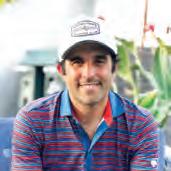
JARRETT CHIRICO
Jarrett Chirico, DCA, is director of racquets at Royal Oaks Country Club, Dallas, TX and president of The Directors Club. He can be reached at jarrettchirico@gmail.com RACQUETS
There’s something incredibly special about the way racquet sports weave their way into the heartbeat of a club. It’s not just about tennis, pickleball or paddle anymore, it’s about the way racquets are redefining what it means to belong to a club community. For many members, racquets are no longer just another amenity; they are the epicenter of connection, energy and shared joy. In fact, no other area of the club has as many meaningful touchpoints with members of all ages, backgrounds and interests.
What makes racquets unique is the inherent ability to bring everyone together. Walk into a vibrant racquets program (like Royal Oaks) any day of the week and you’ll see it in action, clinics, group lessons, tennis, pickleball, games, camps, you name it, it’s happening. Nowhere else at any club will you see such multigenerational activity happening all at once, in the same place and often at the same time. This shared energy creates something powerful: a sense of community that feels more like family.
Clubs are recognizing that members are choosing where to belong based on the vibrancy of the racquets program. A robust offering isn’t just a bonus, it’s a deciding factor. And what members are drawn to isn’t simply the quality of the courts or the availability of events. They are drawn to the atmosphere, the relationships and the stories unfolding on and around the court. Racquets are where the club comes alive.
The true value of a racquets program lies in its boundless versatility. Few amenities can offer such a wide range of engagement—competitive leagues, social events, junior development, family play, tournaments, adult clinics, private lessons and the list goes on. The possibilities are limitless, which means every member can find a way to connect. Racquets adapts to their stage of life, their mood that day and their reason for showing up, whether it’s to compete, to learn or simply to laugh.
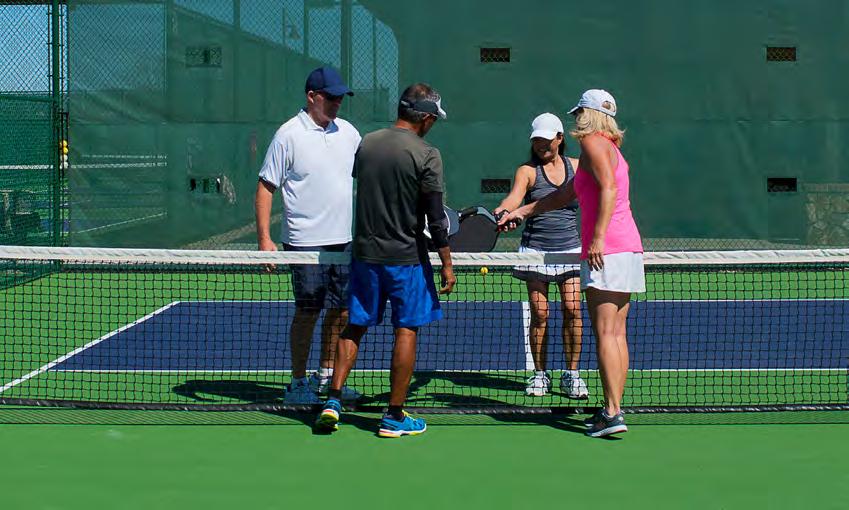
But here’s the part we must never forget: Building great racquets facilities is not enough. Courts alone don’t build culture. People do.
A successful racquets program is built through passionate, invested staff who see their roles as more than just teaching or organizing, they see themselves as leaders. A talented pro who learns every member’s name, remembers their child’s birthday and makes new players feel immediately welcome is worth more than any multimillion-dollar facility. These professionals are the heartbeat of the club. They set the tone, nurture the culture and create that intangible magic that keeps members coming back.
We must also understand that culture costs money. It is not an expense; it’s an investment.
Hiring exceptional staff, developing their talents, supporting their growth and empowering them to lead with heart is how we create a lasting impact. When we do this well, something remarkable happens: our staff’s love for the club becomes infectious. Members feel it. They mirror it. And suddenly, the club transforms into a second home, where everyone feels they belong.
The greatest gift we can offer our members is not a new building or another event on the calendar, it’s the feeling that they are seen, valued and part of something bigger. That starts with racquets. That starts with people. When racquets become the soul of the club, everything else falls into place. You don’t just retain members, you create loyal advocates. You don’t just teach skills, you change lives. And in doing so, you redefine what club life really means: not just a place to play, but a place to grow, connect and come home to. BR
TITO MORENO
Andrés “Tito” Moreno is founder of AMET International, a turnkey padel facility firm serving U.S. clubs. A former international competitor and Sports Management grad from Texas A&M, he now leads strategy, construction and coaching, including for the USA Junior National Padel Team. Learn more at ametinternational.com

RACQUETS REIMAGINED
PADEL: FACILITY BUILD AND TRENDS
Padel has experienced rapid growth in the U.S., averaging a 60 percent increase in court development annually, with a standout 152 percent growth in 2023 alone.
As the fastest-growing racquet sport in the world, padel’s momentum shows no signs of slowing, and much of that surge comes from the format itself. While singles padel does exist, it’s rare. The standard padel court size (10m x 20m) is optimized for four players, so padel = doubles by default. Doubles play fosters connection, conversation and community, one of the key reasons clubs are embracing padel as part of a more social, inclusive member experience. Its widespread popularity in Europe and Latin America has created international momentum now fueling the U.S. market. Combine that with its fast-paced, point-rich gameplay that’s as much fun to watch as it is to play, and it becomes clear why padel is becoming a cornerstone of modern club culture.
Padel continues to evolve with modern technology, making it one of the most future-proof racquet sports amenities. Smart systems now allow clubs to automate bookings, equipment rentals, ball sales and lighting, reducing overhead while enhancing member convenience. At the same time, advances in materials and engineering have made courts more durable than ever, with some warranties extending up to 25 years. As investment grows, so does the cycle of innovation, ensuring padel remains a sustainable, low-maintenance and high-value addition to any club.
At AMET International, I don’t just build padel courts—I help clubs turn their vision into reality. What started as a passion project among sport-obsessed friends has grown into a full-service operation that guides clubs across the country on how padel fits into their master plans.
A standard court ranges from $40,000 to $85,000, with a concrete foundation adding $10,000 to $25,000 and installation typically between $10,000 and $20,000.
Altogether, clubs can expect a total investment of $65,000 to $135,000 per court.
Purchasing multiple courts often yields a 5–10 percent discount per court.
Repurposing underutilized spaces is growing trend in private clubs. Padel offers an ideal solution, transforming unused tennis courts, lawns, or low-traffic areas into vibrant social hubs. Beyond driving active use, padel creates opportunities to enhance the surrounding environment with grab-and-go beverages, casual lounges and wellness spaces that elevate the club experience. Its modern aesthetic appeals across generations, making padel a powerful addition that not only complements existing amenities but strengthens the club’s overall appeal.
Building a padel court is a straightforward process with a few key variables. Primary considerations include land availability, permitting, number of courts, foundation and installation. Common permitting includes building, electrical, grading and zoning approval permits. Permitting laws vary by county and have a wide range of costs. While land and permitting costs vary by location, the court itself follows consistent pricing. A standard court ranges from $40,000 to $85,000, with a concrete foundation adding $10,000 to $25,000 and installation typically between $10,000 and $20,000. Altogether, clubs can expect a total investment of $65,000 to $135,000 per court. Purchasing multiple courts often yields a 5–10 percent discount per court.
From building the first padel courts at a Texas school to developing the largest indoor facility in Miami, I’ve learned exactly what makes a padel rollout smooth, sustainable, and successful.
As founder and CEO, and a lifelong ambassador of the sport and current coach of the USA Junior National Team, I bring experience both on and off the court. At AMET, we offer complete turnkey services, from facility design built to international standards to court selection tailored to your location and goals. We manage every step: construction, installation, and long-term operational support. Whether you’re adding one court or building a full-scale padel complex, my team and I are here to turn your ideas into thriving, lasting spaces.
THE NEXT STEP
Padel isn’t a trend, it’s a transformation. For clubs looking to attract new members, energize their amenities and plan for the future of play, now’s the time to get on court. And with the right design and strategy, your club could be the one setting the standard. At AMET International, we’ve helped clubs across the country do exactly that, bringing padel to life with precision, creativity, and a whole lot of court-side experience. BR
RACQUETS REIMAGINED
OUTLOOK & CERTIFICATION
WHY CERTIFICATION IS THE KEY TO A LIFELONG CAREER IN RACQUET SPORTS
In an industry as dynamic and fast-growing as racquet sports, one truth remains constant: certification is not just a credential, it’s a career foundation. At the Racquet Sports Professionals Association (RSPA), we believe that becoming a certified professional is about more than proving you know how to coach. It’s about setting yourself up for a lifelong, fulfilling career in a field that blends passion, purpose and opportunity. Racquet sports are growing, and players in tennis, pickleball, padel, squash and platform tennis (paddle) need professionals to guide them.
WE FOUNDED THIS INDUSTRY—AND WE STILL SET THE STANDARD
Since our founding in 1927, we’ve been the gold standard in racquet sports certification. We were created to professionalize tennis instruction, not for elite players, but for the club professionals who grow the game every day. Nearly a century later, that legacy continues across tennis, pickleball, padel, squash and platform tennis. Although becoming a certified professional in these sports is the gateway to coaching, we believe it does more than simply prepare you to teach; we cultivate leaders, mentors and ambassadors who shape racquet sports.
With a growing need for coaches in so many different sports, we saw the need to unite all racquet sports under one membership, offering trusted certification, expert coach developers and support that can turn a passion for racquets into a career coaching and managing multiple sports.
COACHING IS A CAREER—NOT A SIDE GIG
Often, coaching serves as a great part-time job or a steppingstone to more opportunities. Though certification can open that door, the reality is far more exciting. Certified racquet sports professionals are:
• Directors of racquet sports at multisport facilities
• Entrepreneurs owning academies or clubs
• Consultants, speakers and innovators in fitness, wellness and sport science
• Global ambassadors for the sports, traveling the world and growing the racquets industry through coaching, business and advocacy.
With the right support, becoming certified leads to a career with depth, diversity and direction.






We founded this industry almost a century ago, and we are advancing it again by going beyond certification and part-time support. We prepare full-time professionals with the
expertise, leadership, and commitment that the multi-sport clubs of the future demand.
If you're hiring, don’t settle for entry-level.

BROCK ORLOWSKI
Brock Orlowski, MBA, CDORS, RSPA, PPR, RPO, Padel MBA, LSA, SETS, DCA, is director of racquet sports at Fort Wayne Country Club. He can be reached at (260) 432-5836 or brockorlowski@ftwaynecc.org RACQUETS
Racquet sports, tennis, pickleball, padel, platform tennis and squash, have always brought people together. But today, they’re doing something more impactful: engaging kids, teens, adults and seniors alike in a way few other activities can.
This multigenerational appeal is reshaping how clubs think about programming, how leaders manage evolving member needs and how communities are being built not just around sports but around shared values and experiences. The beauty of the growth of racquets is that it isn’t just one or two sports anymore; there is truly something for everyone. Young or old, beginner or advanced, everyone has a place on some sort of court.
1. Racquets for all ages
• Pickleball progress: Once seen as a sport for seniors, pickleball is now attracting people in their 20s and 30s, and universities are offering scholarships to players.
• Tennis is timeless: Using a progression model, from the youngest kids (red ball) up to green dot, from senior leagues to cardio tennis, tennis continues to hit all markets as a lifetime sport.
• Padel the prodigy: Younger audiences love the social and fastpaced nature of padel, while the use of the walls allows for a lower impact for older players.
Takeaway: Racquets are hitting all the right notes for players: exercise, competitive outlet, social encounters and accessibility to many generations.
2. Rethinking programming: Flexibility, family and fun
• Stacked scheduling: Offering junior clinics alongside adult socials or couples’ tennis promotes family-wide participation. Get the whole family out together.
• Social-driven formats: Programming now often includes music, food and beverages to appeal to Gen Zers and Millennials. See members leave with a smile.
• Intergenerational play: Doubles mixers, family tournaments and parent-child events build bonds and club loyalty. Fewer silos, more cohesion.
Takeaway: Think holistically. The club is designed to provide all members with exceptional experiences, so find ways to include all members. Bring everyone from the family together for fun at your club!
3. Leadership is the key
Directors of racquets must change their style to be more adaptive. It’s more like being a CEO of racquets—seeing all aspects of the
department and working on the cutting edge to achieve club goals and give members great memories.
• Generational IQ: To reach multiple generations within the club, also reach multiple generations within the staff. A good leader needs to be able to communicate in a way that impacts and inspires each person, not just a key demographic.
• Rethink mentorship: The model of older players investing in younger players is important, but the shift needs to be thinking about pouring into someone while simultaneously being poured into by someone. The sharing of wisdom and experience is a two-way street.
Takeaway: The most effective racquet sports leaders today are part coach, part connector and part community architect. With many racquet sports come many racquets responsibilities.
4. Community-building through play
• Cross-generational culture: Racquet sports offer one of the few environments where a 14-year-old and a 70-year-old might both be on the court.
• Starting points: From casual drop-ins to competitive ladders, having multiple ways to get involved makes the community more inclusive.
• Bigger than racquets: Clubs supporting charitable clinics, youth programs or accessible play help members of all ages find deeper purpose.
Takeaway: Sports like tennis and pickleball are becoming vehicles for belonging. Community is no longer a byproduct of play—it’s the point.
THE FUTURE IS OURS
Sport has always been the great unifier. What unites us is greater than what divides us. Racquet sports are uniquely equipped to be the great connector across generations. They provide a level playing field for everyone to come together and engage in likeminded activities.
The clubs that will reach the greatest heights in the next decade are the ones that embrace this mentality: “How can we help each other and grow together?” When one racquet sport succeeds, they all succeed.
If we lean into that mentality, the game, and the community around it, will only grow stronger. Will you join us in the future? BR
KAINOA ROSA
Kainoa Rosa, DORS, MBA, is the Director of Racquets at the Palm Beach Country Club in Palm Beach, FL. RACQUETS

As racquet sports continue to evolve, grow in popularity, and exert greater influence within the private club sector, Member Open Play has become an essential component of a successful program. With the rapid expansion of pickleball and padel, a well-structured Open Play program can elevate an already thriving operation, enhancing member engagement and optimizing court utilization, a key focus for committees, general managers, and boards across the country.
A frequently debated question is whether a professional staff member should oversee Open Play and, if so, to what extent they should be involved. To address this, two primary factors must be considered when determining the appropriate level of professional staff engagement.
At highly prestigious and exclusive clubs, the presence of professional staff is paramount. These world-class institutions employ industry-leading professionals who are deeply engaged in every aspect of the program. For Open Play to succeed in this environment, where members expect exceptional service at the highest level, professional staff must not only be present but also proactively address potential issues before they arise.
For instance, professionals should ensure balanced competitive play by strategically grouping players and preemptively mitigating potential conflicts. In elite clubs, where members are often high achievers accustomed to success, differing opinions on court etiquette and format can lead to friction. A strong professional presence helps maintain harmony by managing expectations, creating a structured playing environment, and ensuring a seamless experience for all participants.
Larger clubs, with memberships comparable to small towns, face logistical challenges that make it impractical for staff to be directly involved in every match. In these settings, strong member leadership is crucial. Rather than having professionals oversee every interaction, the success of Open Play relies on designated captains, daily leaders, and an engaged racquets committee.
While professionals may not be present at every court, they play a critical role in the overall management of the program. Their responsibilities include establishing Open Play policies, such as implementing a paddle rack system for pickleball or a ladder system for padel, ensuring smooth operations without constant direct involvement. Even in large clubs, professional staff remain integral, shifting their focus from hands-on court management to strategic oversight and policy development.
Professional staff involvement is essential in all private clubs, but the level and type of engagement should be dictated by the club’s prestige and size.
At elite clubs, a highly visible professional presence is necessary to meet elevated member expectations and maintain seamless play.
At larger clubs, professionals serve more as strategic managers, ensuring structure and organization while empowering member leaders to facilitate daily play.
Understanding these dynamics allows clubs to implement Open Play programs that maximize both member satisfaction and operational efficiency. BR
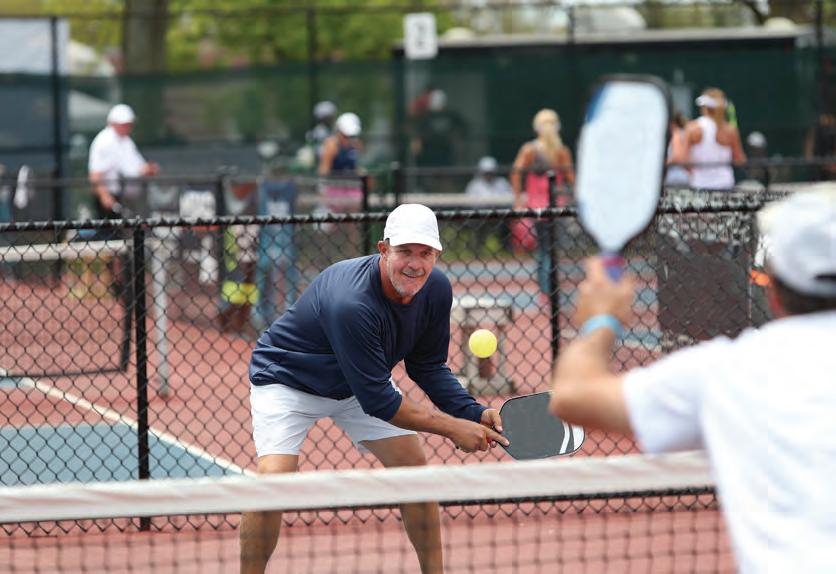
RACQUETS REIMAGINED PROFESSIONAL DEVELOPMENT & COMPENSATION
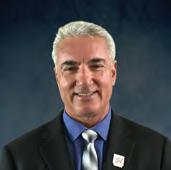
LEN SIMARD
Len Simard, PTR/PPR/RSPA Master Professional, is a search and consulting executive at Kopplin Kuebler & Wallace. He can be reached at (407) 463-8923 or len@kkandw.com
Private clubs are amid a racquets revolution. Once considered a supplementary amenity, racquet sports are now a driving force in membership engagement, value and cultural transformation. Courts are full, programming is exploding and demand for lessons, clinics and events has never been higher. But behind the buzz lies a more urgent question: Are we doing enough to develop and retain the professionals powering this growth?
Facilities have evolved, but if racquet sports are to remain at the heart of a thriving club, professional development and compensation must evolve too.
REDEFINING THE ROLE: WHAT TODAY’S CLUBS SHOULD LOOK FOR IN RACQUETS PROFESSIONALS
Gone are the days when a strong serve and smooth backhand were enough to lead a racquets program. Today’s director of racquets is part business leader, part cultural connector and part visionary. They are responsible not only for teaching but also for team leadership, programming strategy, cross-sport integration, member relations and department-level financial oversight.
At Kopplin Kuebler & Wallace, we see from our club culture surveys that clubs look beyond technical coaching credentials when hiring a racquets director. The most common traits that clubs look for are:
1. Leadership and talent development: Can they hire, train and motivate a multigenerational team across multiple racquet sports?
2. Strategic programming insight: Do they have a vision for driving usage and creating diverse, inclusive programming?
3. Communication and visibility: Are they accessible to members and staff alike, and do they foster an open, connected environment?
4. Operational acumen: Can they manage a department budget, understand utilization trends and scale programming sustainably?
Interestingly, teaching and playing ability now ranks much lower on the priority list than it did 10–15 years ago. That shift reflects the modern club’s need for leadership over repetition, strategy over stroke mechanics.
MORE
To lead a modern racquets department, professionals need more than tennis-specific credentials. Pickleball, platform tennis (paddle), padel, POP tennis and, in some clubs, squash are now expected components of the skill set for the director of racquets.
That’s where advanced certification programs are playing a critical role. The director of racquet sports certification, originally developed by the United States Tennis Association and now offered by the University of Florida, is endorsed by all teaching associations in this country. It is emerging as the industry gold standard that focuses on:
• Bridging the gap between coaching and department leadership
• Equipping professionals for a multisport future
• Building financial, operational and team management skills
• Delivering immediately applicable strategies backed by realworld experts.
We have even seen at some clubs that completion of the program carries a financial weight, a $10,000 to $20,000 salary premium in recognition of the leadership value it provides.
The racquets industry is still shaking off an outdated compensation model that rewarded court hours more than impact. The traditional approach of low base salary and high teaching commission might have made sense when professionals were hired to teach, not lead. But in today’s club world, that structure is holding the department back.
The most forward-thinking clubs are building compensation models that reflect the true value of the director of racquets. These models typically include:
• A higher base salary tied to leadership and off-court responsibility
• Reduced personal teaching load, especially during peak hours
• Bonuses tied to departmental growth, such as increases in participation, member satisfaction and team revenue
• A small percentage of program lesson revenue, promoting program growth and team development
• Financial incentives for completing certifications and launching new initiatives.
This model empowers the director of racquets to build a department, not just a lesson book. It creates space for innovation, collaboration and long-term program planning. And perhaps most importantly, it prevents burnout by rewarding balance and big-picture thinking.
See Racquets Reimagined - Simard | 112

This is an exciting—and important—time for tennis. On the heels of five consecutive years of participation growth, the sport is enjoying a boom in popularity that it hasn’t experienced in decades. One in every 12 Americans played tennis in 2024—the highest proportion on record. With some 26 million participants in the US, there are more people on more courts in more places, which is not only great for the sport but equally advantageous for those who play it.
Importantly, as the sport continues to grow, tennis is also becoming more diverse, with a 26 percent increase in participation among Black/African American players and a 15.4 percent jump in Hispanic players. Tennis is also getting younger, with players under 35 representing nearly two-thirds of all growth. And people aren’t just playing, they’re staying, with 79 percent of players from 2023 playing again in 2024. That’s a five-year high for player retention. Widely considered the world’s healthiest sport, tennis is unmatched in its bounty of physical, mental and social benefits. Studies have shown that those who played regularly lived an average of 9.7 years longer than their sedentary counterparts. Court time gets you more time. That’s an equation that’s tough to ignore. It’s that lifeenhancing lineup of benefits, along with tennis’ unmatched ability
to connect individuals and strengthen communities, that prompted the United States Tennis Association (USTA) to set the ambitious goal of creating 35 million players by 2035. That big number presents an equally large challenge—one that the USTA is attacking with a purposeful game plan that focuses on player retention, facility enhancement and a reimagining of an approach to coaching.
To get more people of all ages into the sport, the USTA is amping up its efforts with Red Ball Tennis, which uses shorter courts and modified equipment to make tennis easier to learn and play. In 2024, the USTA conducted more than 470 RBT pilot programs for some 23,000 players. Seventy-five percent indicated that they would like to play more.
“We need to ensure that every player’s first experience inspires them to come back,” said Brian Vahaly, president of USTA. “Red Ball makes the game immediately fun and gives new players the confidence to stick with it. If we get this right, we’re not just improving their introduction to tennis—we’re laying the groundwork for the sport’s long-term growth.”
And to ensure that those who want to play have a place to play, the USTA is increasing its funding for building and maintaining
See Racquets Reimagined - USTA | 112

RACQUETS REIMAGINED COACHING & MEMBER EXPERIENCE

MILENA VIDOS
Milena Vidos is PTR vice president. She can be reached at (843) 785-7244 or milena@ptrtennis.org
WHY COACHING QUALITY MATTERS
How do we keep players in the game? What can we do to grow racquet sports and ensure that players stay motivated, engaged and wanting more?
The answer is simple: the more trained and certified coaches we have, the better the player experience will be. This leads to better retention, more enjoyment and a lifelong connection to the sport.
As I travel across the country, I observe lessons and clinics led by coaches with different styles, philosophies and levels of preparation. While many do an excellent job, there is one phrase I hear often: “I have always done it this way.” That mindset is one of my biggest concerns. Great coaches are lifelong learners, always looking for professional development, improving their methods and staying up to date with the latest trends.
To grow racquet sports, we need coaches with a strong foundation who are certified, educated and Safe Play approved. These coaches don’t just teach tactics and technique; they foster connection, boost confidence and create environments where players feel supported and safe.
COACHING FOCUS AREAS THAT MAKE A DIFFERENCE
At the Professional Tennis Registry and the Professional Pickleball Registry, we are focused on helping coaches grow in ways that elevate the player experience. Here are a few focus areas that go beyond just hitting balls and truly shape lifelong players:
1. What to coach skills: Tactics and technique
Let’s get this one out of the way. Many coaches believe this is the most important area to focus on, but it’s only one piece of the puzzle. Yes, players

need solid fundamentals to enjoy success. And yes, our Level 1 workshops ensure every coach understands the essentials. But tactical and technical skills alone don’t help keep people in the game.
2. How to coach skills: Communication and connection
This is where the magic happens. How you speak, demonstrate, listen, and engage with your players is extremely important. Players must feel heard, valued and connected in a safe learning environment. When they do, they are more likely to connect with the sport and stick with it.
3. Holistic development through the American Development Model
ADM teaches us to look beyond technique. It focuses on developing the whole athlete by building competence, confidence, creativity, character and connection. These skills are not just essential for athletic development, but also for personal growth. When we focus on these values, we are not just developing better players; we are helping shape better people who take these life skills with them beyond the court.
4. Competition as a tool for retention
Competition, like team events, match play and flexible league formats, creates purpose, motivation and belonging. We train coaches to incorporate fun, levelappropriate and inclusive competition, ensuring players feel engaged and are excited to come back.
5. Athlete-centered environment
We may know all the coaching skills in the world, but if we don’t create a welcoming, supportive and positive environment, players won’t stay. Athletes who learn in an athlete-centered setting are far more likely to become lifelong participants.
If we want racquet sports to thrive, we need to put coaching quality at the center of our strategy. Great facilities, marketing campaigns and new programming are important, but without trained and motivated coaches delivering excellent experiences, players will drift away. Let’s shift our mentality from “the way we have always done it” to “how can we get better?” Let’s commit to a culture of learning, growth and excellence on and off the court. BR
RICHARD WADE
Richard Wade, director of squash & padel at the Philadelphia Cricket Club. He can be reached at (215) 754-0059 or rwade@philacricket.com

RACQUETS
The racquets industry is experiencing a rapid resurgence marked by renewed enthusiasm and growing popularity across both commercial and private club sectors.
The emergence of padel and pickleball, referred to as the “gateway sports” of the racquets world, has significantly raised their profiles on the global stage. In doing so, they have also reignited interest in more traditional racquet sports, largely because of the involvement of teaching professionals with backgrounds in tennis and squash, bringing the racquets industry to a new inflexion point.
As these newer disciplines establish a firm foothold within racquet sport communities, they prompt an important reflection: What insights have we gained to help ensure collective success within the industry in the years ahead?
Tradition, developed over generations and cultures, is generally viewed as a valuable and positive force. Many private clubs, such as The Philadelphia Cricket Club, uphold traditions that date back to their founding, in this case, since 1854. While certain customs may become outdated or lose relevance over time, one enduring principle at the club remains clear: innovation is essential to both the present and future success of the institution. This commitment to innovation is viewed as integral to ensuring member satisfaction and the club’s continued evolution.
To succeed within a multi-sport environment, sports clubs and racquet sport leaders must embrace a strategic, inclusive and customer-focused approach. Key pillars in the development of a comprehensive racquets program include member-centric programming, ongoing coach education and collaboration as well as the effective integration of technology and data-driven decision-making.
Clubs should provide a diverse and complementary range of sporting activities that accommodate various age groups, skill levels and individual interests. Depending on the size of the membership or client base, it is possible to implement a multi-layered program in which different groups can operate concurrently while creating a sense of unity and inclusion rather than separation. Members who interact with your program should always know what opportunities are available to them, how they get involved and what their journey looks like – even if the goal is as simple as staying active and socializing with friends.
Successful clubs invest in multi-disciplinary staff training and encourage collaboration across departments. Coaches and leaders should be knowledgeable in multiple sports and work together to provide integrated programming. Not only does cross-training your coaching staff increase their earning potential and give them greater work-life balance, increasing their morale and loyalty to the program, but it also offers additional opportunities to connect with your membership and deepens the positive impact you can have on the programming.
There are intricacies between each of the racquet sports that can have a positive impact on one another, ranging from event formats, coaching terminology and industry norms that we can all learn from. Upskilling yourself and your team will give you a better opportunity to provide the best experience for your members and customers.
By integrating technology and data into a racquets program, clubs and coaches can deliver more personalized, efficient and engaging experiences. It empowers better decision-making, improves player development and helps clubs remain competitive and innovative in a fast-evolving sports landscape.
Whether you’re identifying the most appropriate court management system for your club, using their reporting mechanisms to help guide your programming or tapping into ways technology can help with a player’s skill development, resisting technology may ultimately cost you, given how quickly the tech world is moving within the racquets industry. Our industry is global, yet technology is such that you can find a match on another continent before you’ve even arrived. Surely, we can do that for our members who belong to the same club.
The introduction of padel and pickleball initially sparked concern among some racquet professionals who perceived these sports as a potential disruption. Encouragingly, this outlook appears to be shifting toward a more collaborative perspective that embraces the philosophy that we are “better together.” If we can make innovation a part of our foundation (a tradition), then we will be constantly evolving. We will always be at the forefront of technology and facility development, and most importantly, we will attract the best professionals to bring our programs to life. BR

In today’s labor market, workplace culture is no longer a “nice to have”—it’s a strategic necessity, especially for private clubs. These exclusive environments pride themselves on delivering exceptional, personalized service to members and guests.
But behind the scenes, leaders are wrestling with a serious challenge: how to foster a positive workplace culture when clubs are open nearly every day of the year and must maintain high-touch standards that require staff presence. Trust me, I hear about this all the time.
At the heart of this challenge is a generational shift in expectations. Emerging workers value flexibility and personal time. For them, work-life integration is not a perk; it’s a baseline expectation. They are less motivated by titles and long-term loyalty and more driven by how their job fits into the life they want to live.
If private clubs want to attract and retain top talent, they need to evolve and find ways to honor those needs, without sacrificing the service standards their members expect. This is an imperative as labor shortages are very real, especially in the hospitality industry.
For years, many private clubs have relied on a traditional staffing model: fixed schedules, long shifts, minimal time off during holidays and a heavy emphasis on hierarchy. It’s common to require employees in critical roles to show up to work and rarely take a day off during the season, and that day may be a Tuesday. So much for any family time.
Employees who feel overworked and undervalued are more likely to disengage, show up with poor attitudes and eventually leave. In high-service environments, like private clubs, that disengagement doesn’t just affect internal morale—it impacts the overall experience and your brand.
Employees today have options. When they choose to work in hospitality, they do so with an expectation that they will be treated as people, not just producers of service. They want to know and feel that their employer values, appreciates and celebrates work-life integration.
So, how can clubs balance the need for availability with the desire for flexibility?
1. Shift the mindset from “scheduling” to “designing work”
Instead of seeing schedules as a static grid to fill, leaders can treat them as a design challenge. What would it look like
Rita Barreto is a national motivational speaker and awardwinning HR executive with over 30 years at a Fortune 500 company. She offers customized consulting to navigate change and build agile company cultures. Visit toptierleadership.com to schedule a free 20-minute consultation.
to build schedules that prioritize member needs and employee well-being?
2. Empower departmental autonomy
Give department heads the authority to work with their teams on creative scheduling solutions. Include employees in the decision-making process.
3. Leverage cross-training and contingent workers
By investing in cross-training, a club can share employees across departments during peak periods. Part-time or seasonal staff can also relieve the pressure on full-timers and reduce burnout.
4. Celebrate and communicate time off
Normalize and honor taking time off. Encourage leaders to role model healthy boundaries. This is so important. Witnessing the boss take time off and use all of their vacation time demonstrates the importance of a “refresh.” It’s also nice to have board members and owners communicate the importance of that recharge.
When clubs make this cultural shift, the payoff is powerful. Teams that feel seen, heard and respected show up with better attitudes. That positive energy directly translates to better service, and it can give you that competitive edge when it comes to finding and keeping talent.
Additionally, clubs with reputations for caring about their people become magnets for talent. Word travels fast in hospitality circles. Employees talk about where they feel appreciated, where they have flexibility and where leadership actually lives the values it preaches.
Workplace culture isn’t just about employee perks or casual Fridays—it’s about how people are treated, respected and empowered at work. For private clubs to thrive in today’s labor market, they must confront the tension between high service expectations and modern employee values. It’s not easy, but it’s possible. And when done well, it builds loyalty, attracts top talent and elevates the entire member experience. The clubs that get this right will not only survive—they’ll lead. BR RITA




SKIP AVERY
Lawrence J. “Skip” Avery CCM, CCE, CMAA Fellow, is director of club development at Stone Group Architects. He can be reached at (608) 335-0342 or SkipA@stonegrouparch.com
After four decades as a private club consultant specializing in operations and team development, I’ve observed that what separates extraordinary clubs from merely adequate ones isn’t their amenities or traditions. Instead, it is their leadership, built upon two fundamental pillars: the ability to inspire and the capacity to build trust.
In today’s competitive landscape, where members have increasing options for their leisure time and discretionary spending, these leadership qualities have never been more critical. The stakes are particularly high in private clubs, where relationships are long-term, expectations are elevated and the margin for leadership failure is razor-thin.
Inspirational leaders transform clubs by articulating a compelling vision that resonates with staff and members. This vision serves as a North Star, guiding decisions from board meetings to daily service interactions.
When employees understand how their contributions enhance the member experience, their engagement increases dramatically. The ripple effect of inspired teams creates measurable outcomes: improved member satisfaction and retention, reduced staff turnover, enhanced innovation in programming and greater resilience during challenging periods. When club employees feel inspired rather than merely instructed, they become ambassadors of the club’s values, transforming the service culture from transactional to transformational.
Trust in private clubs operates on multiple levels: members must trust management to steward their club responsibly; staff must trust leadership for direction and support; board members must trust the management team to execute their vision. Trust develops when club leaders demonstrate consistency between their words and actions, transparency in communication, fair treatment of all stakeholders, a commitment to club values even when it is difficult and a willingness to acknowledge mistakes and course-correct.
Without trust, even the most well-conceived strategic plans fail in execution. I’ve witnessed clubs invest millions in facility improvements yet continue to lose members because leadership has lost the trust of both members and staff. No physical enhancement can compensate for broken relationships at an organization’s core.
The most powerful club leadership occurs when inspiration and trust reinforce each other. A leader who inspires without building trust creates initial excitement that quickly fades. Conversely, a trustworthy leader who cannot inspire may maintain operations but struggle to elevate the club experience or implement meaningful changes.
Emotional intelligence serves as the critical connector between these pillars. Leaders with high emotional intelligence demonstrate self-awareness about their impact, empathy for member and employee perspectives, relationship management skills and adaptability in responding to diverse needs. These capabilities
allow club leaders to inspire authentically and build trust organically rather than mechanically.
Based on my experience, specific practices enhance inspirational leadership. These include developing and regularly communicating a compelling narrative about the organization’s purpose and future, connecting daily operations to a larger meaning and tradition, celebrating successes that exemplify core values, sharing stories that reinforce the unique identity, and modeling the passion and commitment you wish to see in others.
Similarly, to build and maintain trust, ensure transparent and consistent decision-making processes, address problems directly rather than allowing issues to fester, follow through on commitments, especially small ones, create a psychologically safe environment for staff to voice concerns and demonstrate vulnerability by acknowledging limitations.
After 40 years in the private club industry, I’m convinced that no leadership qualities matter more than inspiration and trust. These twin pillars support everything from operational excellence to financial sustainability and member satisfaction.
We must remember that we are in the experiential business; it’s all about return on experience (ROE). The clubs that thrive in challenging times invariably have leadership teams that have mastered both the art of inspiration and the discipline of trustworthiness. When these qualities become embedded in organizational culture, they create resilient institutions capable of evolving while honoring tradition.
The urgency to develop these leadership capabilities has intensified in our post-pandemic world. Member expectations have fundamentally shifted, staff dynamics have transformed and the definition of value in private clubs has been rewritten.
Leaders who cannot inspire meaningful connection or build authentic trust find themselves presiding over declining memberships and fractured cultures. The most compelling evidence I’ve witnessed is how different clubs with inspirational, trustworthy leadership emerged from recent crises compared to those with traditional, purely operational management approaches. The former accelerated growth while the latter struggled to regain footing.
I challenge you to evaluate your leadership approach today: Assess how effectively you’re inspiring your team and building trust throughout your organization. Identify one specific action you can take this week to strengthen each pillar. What story will you share to inspire others? What promise will you keep to build trust?
The journey toward exceptional leadership begins with these intentional steps. Remember, in environments where relationships and reputation are paramount, inspiration and trust aren’t just leadership virtues but essential requirements for lasting success. Your deliberate focus on developing these capabilities will yield the highest return on your leadership investment, not just for your club but for your legacy as a leader. BR
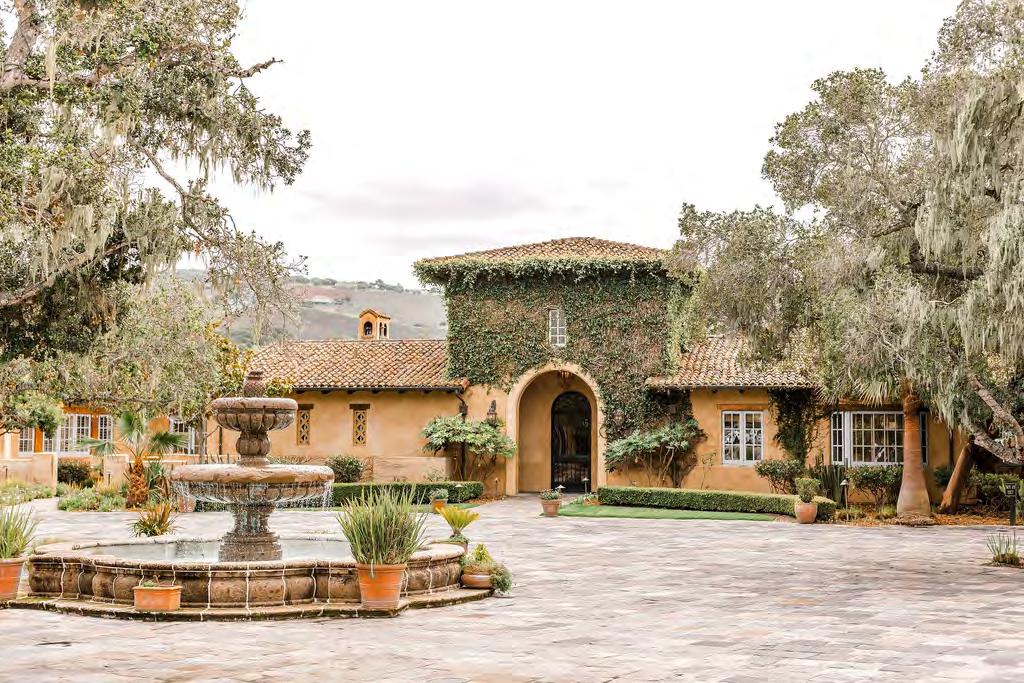



Our investor group of local residents and club members lovingly cared for this Nicklaus gem, but then ran into disagreements and capital calls.
We knew we needed an upscale, private club hospitality firm that invested for the long-term. We’ve found that partner - Concert Golf Partners is a breath of fresh air!
- CHRIS LAVER
Many esteemed clubs, such as TPC Monterey at Pasadera choose to partner with Concert Golf Partners as the best approach to preserve and enhance their clubs.

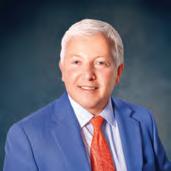
During a leadership transition, clubs often consider asking an internal leader, such as the chief financial officer, assistant general manager, director of golf or superintendent, to serve as interim general manager/chief operating officer. At first glance, this approach seems efficient: it leverages existing talent, rewards high performers and avoids additional costs. However, appointing someone from within can create unintended challenges that complicate the transition for the incoming GM/COO.
When internal leaders step into interim roles, their temporary authority may leave lasting impressions. Staff may continue to rely on the interim long after the official leadership change, and board members may struggle to shift their trust and communication to the newly appointed leader. These
helps identify inefficiencies and introduce best practices. Since they are not concerned about long-term political consequences, they can make necessary changes swiftly and decisively. This objectivity is especially valuable during times of uncertainty.
However, not all interims are equally equipped. Clubs should seek professionals who have successfully served as full-time GMs/COOs in the past. Proven leadership experience is essential; an interim should be vetted as rigorously as any permanent candidate. The ability to lead a club effectively requires a deep understanding of the role and the dynamics of private club management.
An effective interim leader supports more than day-to-day operations. They help keep departments aligned, address
Interim chief financial officers, executive chefs and directors of golf with proven track records can provide stability and maintain standards during transitions. These positions are too critical to be left in limbo. Ultimately, hiring an interim isn’t about standing still it’s about setting the club up to move forward.
dynamics can blur lines of authority, lead to conflicting loyalties and hinder the new leader’s ability to establish their role effectively. Comments like “Things worked better when you were in charge” or “They should have hired you permanently” are not uncommon and can undermine the fresh start the club hopes to achieve.
A more complicated scenario arises when a board member, particularly the club president, assumes operational control during the interim period. This creates direct reporting relationships between department heads and the board, which are often difficult to undo. The result can be fragmented operations, reduced accountability and weakened collaboration.
To avoid such pitfalls, many clubs choose to bring in an experienced, external interim manager. A professional interim can offer objective leadership, maintain continuity and exit cleanly when the permanent GM/COO arrives. Free from internal politics and long-term relationships, they can focus on stabilizing the club and setting the stage for a successful handoff.
Beyond simply maintaining operations, a qualified interim can also improve them. Their external perspective often
unresolved issues and create a smoother on-ramp for the incoming manager. By setting expectations and resolving lingering challenges, they allow the new leader to begin with authority, focus and momentum.
The same logic applies across other key roles. Interim chief financial officers, executive chefs and directors of golf with proven track records can provide stability and maintain standards during transitions. These positions are too critical to be left in limbo.
Ultimately, hiring an interim isn’t about standing still—it’s about setting the club up to move forward. When done thoughtfully, it can serve as a strategic reset, giving the new leader the best possible chance to succeed from day one. BR
Dan Miles, CCM, CCE is Interim Management Director with Kopplin Kuebler & Wallace and can be reached at dan@kkandw.com
Zachary Platek, CCM, CCE is Interim Management Director with Kopplin Kuebler & Wallace and can be reached at zach@kkandw.com


Forbes Travel Guide is the authority on hospitality excellence. We work with the best luxury hotel brands globally. Let us help you elevate your service to improve member satisfaction and retention.



Forbes Travel Guide worked with our leadership team to create custom standards and tailored training which have been implemented throughout the club. We value our partnership with Forbes Travel Guide.
Jeffrey P. McFadden Chief Executive Officer/General Manager The


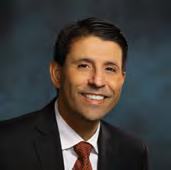

Private clubs have enjoyed a boon since the pandemic. Unprecedented demand, waitlists to join and sold-out events are the norm. Now, more than ever, clubs must evolve, innovate and anticipate the next major change and cycle. Our clubs must remain competitive and relevant as trends and demands change. Having a forward-looking strategy and investing in best-in-class amenities and programming will position clubs for sustainable success.
Marvin Leonard, Colonial Country Club founder, iconic Fort Worth businessman and philanthropist, was ahead of his time in this regard. His enduring challenge to leaders of his various business enterprises, including Colonial Country Club, was as follows: “It’s not good enough to be better than the competition, you must be better and different.”
Leonard developed Colonial Country Club to inspire a generation of golfers and to bring the eyes of the world to the city he loved— Fort Worth. Before Leonard, professional championships had not traversed this side of the Mason-Dixon Line.
In 1941, Leonard’s dream was realized with the successful bid for the 1941 U.S. Open at Colonial Country Club. From this time on, The Colonial, as it is affectionately known to Fort Worthians, would forever remain a celebrated chapter of the greater Fort Worth story and earn a permanent and revered place in the annals of golf history, now and for years to come. Indeed, what Leonard envisioned and delivered was better and different Texas is now home to a host of professional tournaments and some of the game’s greatest players across generations. From the current number one player in the world, Scottie Scheffler, to legends of the game such as the incomparable Ben Hogan, who played and practiced at Colonial daily while rewriting the record books of his era. Leonard’s leadership sustained Colonial, Fort Worth and Texas as more than relevant ... consequential. Leonard was a visionary, a dreamer. He made the unimaginable possible for the city, the state and the game he loved. He brought the sporting world to Fort Worth, Texas and Colonial Country Club with— in addition to the 1941 U.S. Open—the 1971 Players Championship, 1991 Women’s U.S. Open and 79 years of The Colonial Invitational PGA Tour event, now known as the Charles Schwab Challenge. His legacy is unmatched, and it is that legacy of visionary leadership, innovation and commitment to excellence that has inspired a $100 million master plan and transformation of the golf course and campus. As Leonard often conveyed, “Excellence and innovation know no completion.”
Our members and professional team partnered with Henry DeLozier and GGA Partners on strategic and multiphase campus plans designed to redefine the club experience for the Colonial Country Club membership. GGA implemented a process-driven approach to create a strategic plan focused on the wants and needs of Co-
lonial’s members. A robust market analysis emphasized member opinions collected through face-to-face and virtual focus groups, a comprehensive survey of members’ attitudes, wants, needs, expectations and apprehensions. A thoughtful analysis of membership rights, privileges, benefits and obligations followed to ensure that Colonial members are the focus of the club’s strategy.
A financial analysis of the club’s capital needs was undertaken to maintain the club’s assets while imagining capital improvements to be added to the club’s balance sheet to make it different
GGA undertook a comprehensive evaluation of Colonial’s governing documents and practices to align with the standards of best practice for superior clubs like Colonial. Working shoulder to shoulder, GGA and Colonial leaders made the club’s governance a solid foundation on which the next generations of Colonial members can rely.
The resulting strategic plan on which Colonial is now acting has empowered Colonial leaders to lead and Colonial managers to manage. The result is an ideal blend that engages members through relevant programs and activities for the multigenerational club for years to come.
The master plan project started with a 12-month closure of the golf course, making way for a Gil Hanse restoration of the John Bredemus and Perry Maxwell original design. Every square inch of the course was disturbed, including course features and infrastructure. An example of innovation includes the installation of a heating and cooling system for the greens to adjust the soil profile temperature, much like one would heat and cool a building.
Recognizing the importance of the member experience, we added comfort stations throughout the course, offering a wide range of beverages and homemade treats from our kitchen and bakery. The project plan also includes a collaboration with Texas Christian University to build a 6,000-square-foot, state-of-theart golf training and performance center with three indoor-outdoor hitting bays. Finally, a comprehensive redesign and remodel of the golf course maintenance facility is underway.
The second phase of the master plan is a multiphased and comprehensive campus project, including the addition of a new 36,000-square-foot three-story building. Our team was challenged with reimagining and redefining our beverage and culinary programming in this new facility. What followed is an inspired and innovative set of concepts and programming that would make Leonard proud.
The third story of the new building, Hawks Landing, pays homage to Hogan. The restaurant (bearing one of Hogan’s be-
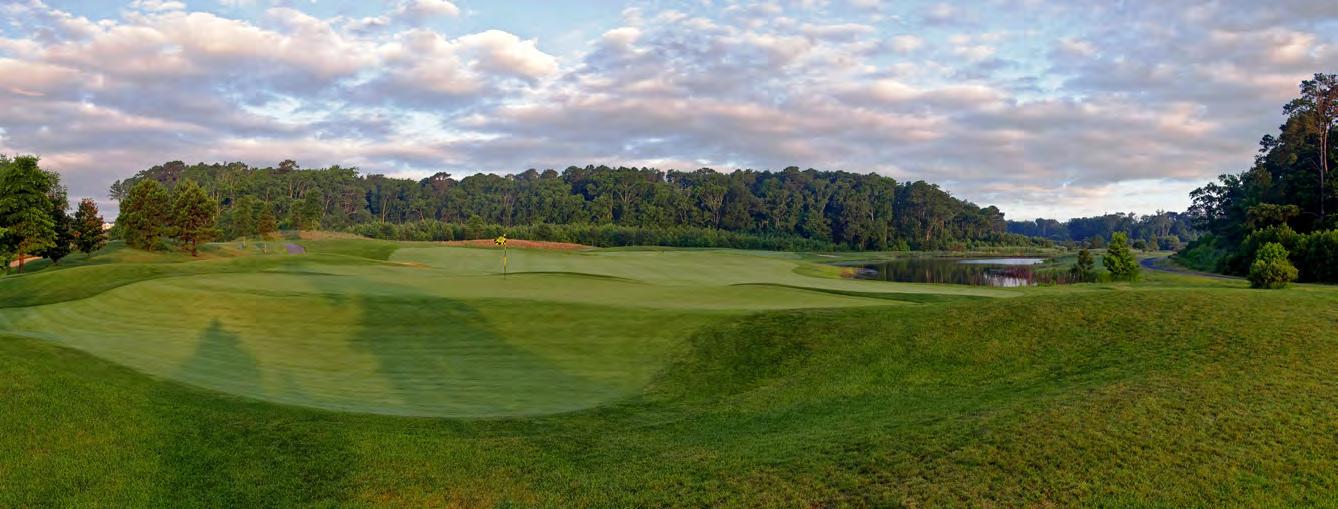


YOUR CLUB. YOUR CULTURE. OUR RESOURCES.
Every private club has its own unique identity and we want to help your club maintain yours. Of course, that requires a different approach than the status quo of self-management, which is why Troon Privé® continues to grow. As Troon’s dedicated private club division, we are a proven professional services organization that provides best-in-class systems, processes and resources to the private clubs we serve. Visit TheTroonApproach.com to learn more about who we are and why our clients partner with us.


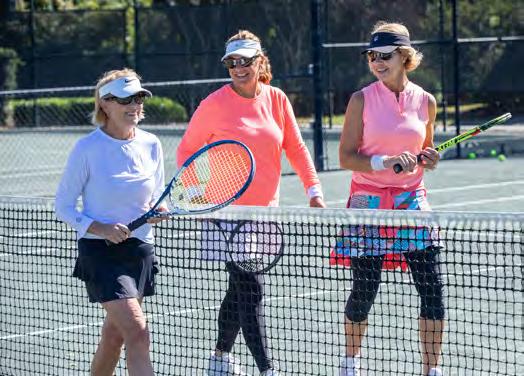



LYNNE LAFOND DELUCA
Lynne LaFond DeLuca is executive director of ACCP and a private club industry consultant. She received BoardRoom’s GaryPlayerEducatoroftheYearAwardin 2016 and 2019 and the JohnFornaroImpactAwardin 2024. She can be reached at Lynne@TheACCP.com or by visiting www.TheACCP.com.
As the private club landscape evolves, so too does the demand for fresh, imaginative experiences, especially when it comes to events. More and more, members are craving something beyond the traditional ballroom or dining room. They want magic. They want surprise. They want to step into a space and say, “I never thought we could do this here.”
ENTER THE RISE OF UNEXPECTED OUTDOOR EVENT SPACES.
From tucked-away garden courtyards to fairways transformed into candlelit dining rooms to surprise rooftop garden dinners, clubs across the country are reimagining their grounds as stages for unforgettable member moments. And the results? Elevated member satisfaction, increased engagement and new revenue opportunities—all without needing to build a single new structure.
THE EMOTIONAL IMPACT OF THE UNEXPECTED
There’s something inherently memorable about walking into a familiar space and seeing it completely reimagined. When a tennis court becomes a concert venue or a cart path is lined with glowing lanterns leading to a secret speakeasy, members experience their club with fresh eyes—and a renewed sense of excitement and belonging.
Outdoor events also tap into a deeper emotional connection: nature. Studies show that being outside improves mood and reduces stress. When members are immersed in a beautifully designed outdoor experience, surrounded by the sights, sounds and smells of nature, the moment becomes more than just an event … it becomes a sensory escape.
DESIGN TRENDS THAT DELIVER WOW
The magic, of course, lies in the details, and that is where your trained director of catering and events comes in. Their expertise can deliver the magic. Here are some of the leading design trends that are helping clubs create outdoor experiences with serious wow factor:
• Lighting as art: Think beyond string lights. Creative lighting—like projection mapping on trees, floating lanterns in pools or chandeliers hanging from branches— can completely transform a space after dark.
• Bold, immersive themes: Lean into your surroundings. A “starlight supper” under the fairway sky, a vineyard-inspired tasting on the driving range or a tropical luau
beside the lap pool can turn a standard gathering into a story-worthy evening.
• Lounge vignettes and layered textures: Outdoor spaces feel more inviting when designed with comfort and intention. Use rugs, plush seating, floral installations and layered textiles to create cozy, luxurious nooks that encourage conversation and lingering.
• Pop-up culinary stations: Move the food experience into the spotlight. Interactive chef stations, mobile oyster bars, wood-fired pizza ovens or champagne carts on wheels give members a sense of discovery and delight.
• Sustainable and seasonal touches: Today’s members appreciate thoughtful design. Use local, in-season florals and herbs, eco-friendly materials and décor that reflects the natural beauty of your location.
Ultimately, these outdoor events aren’t just about aesthetics; they’re about creating moments that reinforce the value of membership. When members attend a sunset dinner on the 9th hole or celebrate a milestone in a candlelit garden tent, they form a memory rooted in joy and gratitude—and associate that feeling with their club.
More than ever, members want to feel seen, celebrated and part of something special. Hosting events in unexpected outdoor spaces delivers on all three.
You don’t need to overhaul your grounds to make an impact. With creativity, collaboration and a bit of courage, any outdoor corner of your club can become a canvas for extraordinary experiences.
In a world where experiential design is king and personalization is paramount, embracing outdoor spaces is more than a trend—it’s a strategy. One that can spark member loyalty, generate buzz and keep your club at the forefront of innovation. Because sometimes, the best events happen where no one expects them. And that’s exactly what makes them unforgettable. BR

Enabling club leaders to efficiently discover exceptional talent while helping the next generation of professionals and those transitioning career paths find top-tier opportunities. Learn more at nextlevelkkw.com.



Empowering industry professionals to transform great ideas into thriving businesses through tailored guidance, expert mentorship, a supportive community, and a network of potential investors. Learn more at clubinnovationhub.com.
Workingtogetherforthecommongoodoftheindustry, servingclubsinallaspectsofstrategicplanning,operations, finances,humancapital,andfacilities.Corevaluesserving asaframeworkfortheirprovenbestpracticesinclude:
InformedLeadership StrategicStewardship EmpoweredManagementandTeam CompellingMemberExperience
Learnmoreatclubleadershipalliance.comand boardroominstitute.com





CRAIG J. SMITH
Craig J. Smith is founding partner and co-creative director at C2 Limited Design Associates, an award-winning design firm servicing the private club industry nationwide. He can be reached at (203) 259 2555 ext. 102 or csmith@c2limited.com or
From covered outdoor bars overlooking the 18th tee and enhanced alfresco dining areas with chef-led grill stations, to open-air lounges with TVs, fireplaces, and communal fire pits, clubs are increasingly reimagining their indoor-outdoor dining and social spaces. Now more than ever, we’re partnering with clubs to transform these environments into vibrant extensions of the member experience. Here are six design strategies clubs are using to transform their outdoor spaces into dynamic, multifunctional social zones, each with built-in opportunities for connection.
1) Weatherproof Member Spaces
At the Stanwich Club in Connecticut, we created fully covered outdoor bars and dining areas with radiant heat and retractable panels. This allows members to comfortably enjoy the outdoors through all four seasons, expanding usable square footage and driving year-round engagement.

3) Repurposing Spaces with Views

The Beach Point Club in New York transformed an underused rooftop area into a coveted member destination. By adding cozy seating, shade structures and soft lighting, a once-forgotten corner now delivers panoramic views and premium social experiences.
5) Reimagining Covered Walkways
Greenbrier Sporting Club in West Virginia transformed formerly utilitarian walkways into elegant, all-season dining promenades. Outfitted with ceiling fans, heaters, and ambient lighting, these onceoverlooked pass-throughs now serve as stylish and functional extensions of the clubhouse’s culinary and social experience.

2) Landscape-driven Social Divide

At Turks and Caicos Sporting Club, the natural landscape was leveraged to create organic buffers between seating zones. Thoughtfully placed hedges, planters and changes in elevation define spaces without feeling restrictive, encouraging interaction while respecting personal space.
4) Reclaiming Out-of-the-Way Areas
The Country Club of New Canaan converted previously overlooked pathways and lawn space into vibrant gathering spots. With intentional lighting, lounge furniture and audio integration, these once-passive areas now pulse with life during social hours and events.

6) Designing Around Daily Rhythms
Also at the Country Club of New Canaan, we developed a multi-use courtyard that shifts seamlessly from morning coffee hangout to evening cocktail lounge. Integrated lighting, shade and comfortable furnishings ensure it feels inviting at any time of day.

To truly redefine your exterior spaces, it takes more than just setting out furniture. You have to “set the stage” so to speak, based upon your strategic programming, envisioned offerings and finally how the space is set in context with the adjacent landscape, views and clubhouse architecture. BR
“creating your club’s road map to best in class facilities”

“We engaged C2 Limited Design to develop Baltimore Country Club’s master plan. Their first iteration was well designed, thoughtful and took to heart the needs we shared with them, particularly with our challenge of being a two campus facility. From their first presentation, to nearing completion, it is apparent C2’s strengths lie in their ability to listen and understand their clients.”
M. Kent Johnson, CCM
General Manager/COO
Baltimore Country Club
Kansas City Country Club

“transformative change to your member experience & operations”

To say we were pleased with C2’s design, process, involvement, and “hand-holding” might be the understatement of the year. They were amazing every step of the way. I cannot speak highly enough about working with C2. Craig, Christina, and the team were a treat to work with and they exceeded our loftiest expectations. I know I am not the only one at Westchester who is taking a good look around the club to see what other spaces can be vastly improved by C2’s incredible designs.”
Mark J. McCooey
Chairman, WCC House Committee
Westchster Country Club
Kansas City Country Club

“award winners of 19 awards for 12 consecutive years!”
Master Planning -
Mission Hills Country Club

Clubhouse Bowling Center RenovationOak Hill Country Club



TIMOTHY N. CASTOR
Timothy N. Castor is president of Castor Design Associates, a nationally recognized interior design and planning firm specializing in private clubs. With over 40 years of experience and more than 375 clubs designed, CDA offers full-service clubhouse interior design from master planning to installation. Contact: (760) 610-1938 or visit cdainterior.com.
When we meet with a new club to review a future project, it seems we always come upon a poorly executed finished product from a prior renovation. Some of the trades that fall into this category are drapery, upholstery, millwork and carpet installations. It is important to bring the right trades to develop the intricate design and details that members are expecting.
We suggest the following remedies that attribute to a beautiful result. It starts with a solid team of subcontractors, who are experts in their fields.

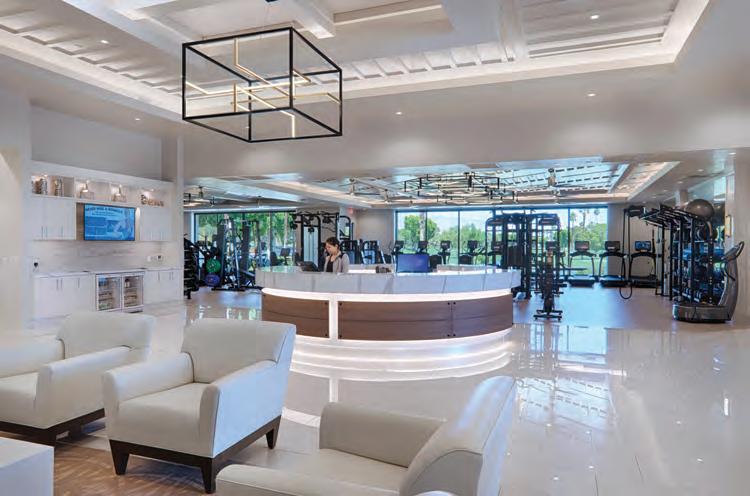
Carpet: We typically use all wool carpets with a double stick pad. This is a special installation which requires a qualified installer who is certified in the installation of commercial wool carpet. Not all installers have this knowledge. You should shy away from carpet installers that concentrate on residential and/or office spaces.
Millwork: This critical element of any clubhouse project must be executed by a quality millworker. First, they should be Architectural Woodwork Institute (AWI) certified. They adhere to the highest woodworking standards in order to obtain the highest quality joinery and finishes.
Upholstery: With dining banquettes and locker room benches being a huge element of clubhouse renovations, this trade needs to be detailed in custom upholstery techniques that are used on our various upholstery designs. Commercial grade foams and welts are required to withstand membership usage throughout the years.
Drapery: What is important about this particular trade is the need for a large workroom which can accommodate the oversized drapery treatments. The need to layout fabric repeats and seam ballroom-scale side panels requires a larger workspace. We would veer away from small residential and pillow fabricators who are not accustomed to this scale of work.
These are experienced trades who should be assembled by your clubhouse designer. Your club will benefit from receiving accurate pricing that maintains a project budget without costly overruns. As always, the club should check references and review previous club projects they may have developed in the past. BR



Clay Pryor is creative director/principal at Clay Pryor Interiors. For more information, please call (720) 252-0990, email claypryor@ymail.com or visit claypryorinteriors.com
OUR PHILOSOPHY
Our team is a creative cell that captures the spirit of collaboration, dedicated to creating spaces that embody a true sense of place.
Natural colorations and sculptural forms inspired through nature’s organic displays strongly control our approach to interior design—anything authentic, unexpected, collected and rediscovered, is on the table.
We like to take risks. The introduction of bold, vivid hues mixed with classic neutrals can enhance the element of surprise.
EACH PROJECT IS LIKE A STORY—EVERYTHING HAS A PURPOSE AND PERSPECTIVE
The art of storytelling drives our team to capture a strong point of view for each project. Whether we are focused on historic renovations, modernizing existing properties or developing a fresh program for new construction, we are inspired to tell a story through livable environments that function for today’s lifestyles.
Clay Pryor Interiors offers a full range of interior design services employing standards in every phase of every project. The CPI team takes historical, geographical, and cultural influences into account, as well as regional art and artisans, natural resources, local building materials, and construction capabilities. Our design philosophy is simple: We design for your market. We seek to incorporate a unique flavor into each project, involving ourselves with the custom design of interior architectural details, interior finishes and materials, furniture, lighting, textiles, artwork, and accessories. A project’s interior vision should be an investment toward creating spaces that showcase our clients’ personalities. BR
OUR PASSION IS TO CREATE SPACES THAT...EXCITE, INSPIRE AND RENEW OUR LIVES.
The Project: Private Golf Club
Interior Design: Clay Pryor Interiors
Trends for design in today’s resort golf club market embark on creating upscale environments through combinations of style that have a sophisticated beauty with an urban attitude. Our goal for this private golf club is to develop interiors that will be seductive yet timeless. Playful, yet powerful. The approach is to create interiors that provide a highly personalized customer experience that stands out in the marketplace. Here, you experience mixing and matching new contemporary expressions with more traditional classic inspirations to build spaces with a true sense of soul!
INTERIOR VISION - A UNIQUE SENSE OF PLACE
Natural craftsmanship is the goal. Whether it’s nature’s work or humankind, our desire to incorporate a sense of craftsmanship is present within the club’s interiors. There is a strong call for the use of organic materials and an abundance of texture. Colors, patterns and textures drawn from the outdoor environments have an effective impression on the patrons. The lines are blurred between the indoor and outdoor transitions. The combined experience for the interior program focuses on strong relationships between the indoor and outdoor living spaces. The interior design captures and utilizes natural qualities of light and shade.
THE COLOR STORY
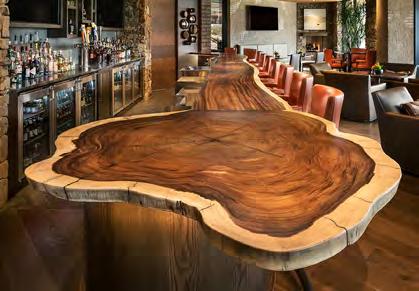

Modern rustication through expressions of color is achieved. We are inspired by colors that do not mimic the hues of nature as much as recreate their effect. Therefore, we chose a color palette that creates interior fields of color-blocking in which almost any combination of people, furnishings, art and unique objects settle together in harmony. The club displays a specific palette of textures, materials and hues that provide a memorable experience for the Patrons. The introduction of pops-of-color pays homage to natural displays found in the desert itself. BR





STEVE LOVETT
Steve Lovett, ASIA, PLA, LEED AP, is principal at Ervin Lovett Miller (ELM), a multidisciplinary design firm offering planning, architecture, landscape architecture, urban design, and visual communications. With a collaborative approach, ELM creates thoughtful, enduring environments for private clubs and more. Visit elmplan.com.
The private club experience is undergoing a dramatic transformation—one that mimics changes in culture and society. As our workplaces, restaurants, and cultural establishments have transitioned to more casual settings, so have private clubs.
Once defined by formality and tradition, today’s private clubs are evolving into vibrant environments that are more casual and fun and where members of all ages come together to connect, relax, and play. Successful clubs have embraced this reality, recognizing that even the most elite clubs can be less formal and include amenities critical to attracting new, young members who will build on the legacy of past generations.
At ELM, we’ve assisted numerous private club clients, successfully helping them plan and design dynamic new facilities and transform existing ones for future generations of members. We see firsthand how shifting member expectations are reshaping the landscape. Families seek places to spend time together outside of home and work, while younger generations appreciate high quality and tradition but prefer more casual settings to engage and connect.
Gone are the days when a club visit meant Dad golfing while the rest of the family stayed home. Clubs with outdated facilities struggle to compete in today’s environment. Successful clubs are evolving, with new ones offering amenities past generations never imagined.
Clubhouses now feature vibrant, casual dining venues with indoor-outdoor seating designed for poolside lunches, impromptu family dinners, and socializing across generations. Resort-style pools incorporate dynamic water elements, shallow play areas, lap lanes for swim teams and aquatic fitness and adult social areas.
Wellness and fitness centers are expanding to accommodate new trends in fitness, focused on targeted performance training, innovative movement studios, dedicated cardio rooms and state-of-the-art fitness equipment. Other amenities such as pickleball, padel, youth and teen game rooms, and even whiffle ball fields are emerging and creating unique social and recreational opportunities.
These strategic investments are designed to create member value and ensure clubs successfully attract and retain members for today and future generations.
ELM’s recent work with Florida Yacht Club in Jacksonville, Florida, is a compelling example of this movement in action. In preparation for its 150th anniversary, the club’s leadership engaged ELM to update its comprehensive master plan and oversee the renovation of its historic clubhouse building, built in 1926, and the club’s seven-acre property on the banks of the St Johns River.
The design effort focused on preserving the club’s 1926 architectural heritage, transforming dated facilities and introducing new high-quality amenities to meet the expectations of today’s multigenerational membership. We transformed tired, underutilized interior spaces into attractive casual dining areas, reopened enclosed porches to reintroduce outdoor gatherings and added an outdoor bar overlooking the river for year-round enjoyment.
The pool complex was reimagined as a social hub for all ages, featuring interactive water elements, a two-tiered fountain and spaces tailored to both adults and children. The wellness and fitness center was expanded and modernized, and a new arrival experience connected these amenities seamlessly.
The result is a club environment that celebrates its legacy while creating tremendous value for current and future generations of members.
Recognizing each club’s unique value proposition and designing for multigenerational use is intentional—and is a key strategy for private club success. Clubs that embrace this evolution futureproof their existence by creating spaces that foster deeper member engagement, increase retention, and adapt over time.
ELM’s philosophy is to approach each club project holistically, understanding that every club is unique to its location, environment, legacy, culture and social characteristics. As planners, architects, and landscape architects, our mission is to help private clubs amplify their value to the membership they serve in any way value is measured. Our work is based on listening and research, understanding our client’s goals and creating innovative, thoughtful solutions to achieve and surpass them.
Because, in the end, the most enduring clubs aren’t the ones that stand still. They’re the ones that grow—with their members, with their communities, and with time. BR
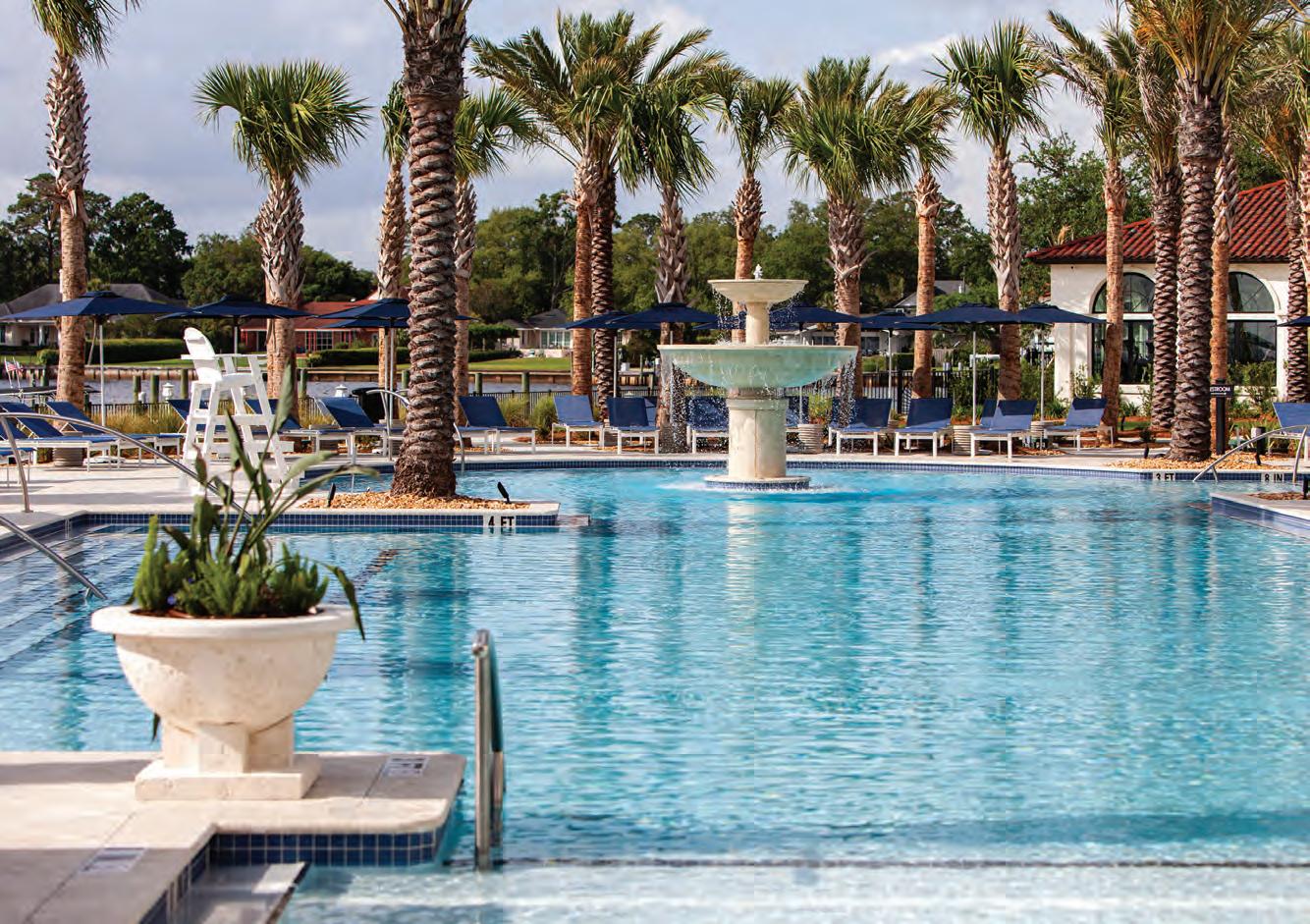










“Trends” is a ubiquitous topic for club professionals, appearing in nearly every conference program and industry magazine. We’re all well-versed in discussions about familyfriendly amenities, exceptional bars and dining experiences (both ultra-casual and casual), state-of-the-art aquatics, resort-style facilities, and the ever-growing popularity of pickleball, padel, simulators, and practice centers. These offerings are undoubtedly what members desire, and clubs must meet these expectations to retain current members and attract new ones.
However, a crucial consideration is often overlooked in capital trends discussions: STAFFING
I’ve encountered this omission repeatedly during visits to some of the top clubs in the U.S. While seminars on recruiting, facilitating foreign personnel, and proper training are critically important, what about creating a physical environment that truly supports staff and fosters their health and social well-being?
In today’s competitive landscape, attracting quality staff can be as challenging, if not more so, than attracting new


Peter Cafaro is senior vice president, JBD JGA Design and Architecture, a ClubWorks Company, in Pawtucket, RI. He can be reached via email at PCafaro@JBD-JGA.com
members. If your recruitment strategy is solely based on an hourly wage, whether it’s $20 or $40, you might be missing a critical component. Most neighboring clubs offer comparable compensation. Furthermore, with recent changes to taxable tips, the challenge of recruitment will only intensify.
Despite the fact that most members express genuine care for their club’s staff—often referring to them as “family”—a stark contrast emerges when one observes employee changing rooms, restrooms, and other staff accommodations. We often find conditions that no one would subject a family member to. How frequently do kitchen staff and servers resort to sitting on milk crates to eat their meals in a corner of the kitchen, or even out on the loading dock?
Fortunately, clubs are beginning to recognize this disparity. Even members are advocating for change. In past master planning focus groups, “staff accommodations”—a term I use to encompass staff housing and other staff amenities—were consistently mentioned as something to be addressed “eventually.” Recently, however, members appear far more sensitive to staff needs, very likely influenced by committed professional managers who champion better conditions for their teams. This isn’t just the right thing to do; it’s a necessity in today’s competitive market. As mentioned, if all neighboring clubs offer similar compensation, what truly sets your club apart?
We know that referrals from current employees are often the most effective recruiting tool available to clubs. We also understand that retaining staff is far more efficient than constantly training new team members. While we frequently discuss culture, leadership, and communication, let’s also consider the simpler, yet equally vital, elements: clean and comfortable bathrooms, a well-stocked cafeteria, healthy meal options, modern indoor and outdoor break areas, and reasonable living quarters. These are the details that distinguish great clubs from good ones, keeping their staff happy, healthy, and focused on members.
During recent club visits, I’ve been incredibly impressed by the efforts made to genuinely treat staff as family. I’ve seen beautiful new staff dining rooms with dedicated chefs (typically in larger clubs), outdoor gathering spaces for breaks, and new and renovated staff housing facilities to accommodate both single and coupled staff members. I’m also pleased to report that as we determine capital priorities within club master plans, staff accommodations, once relegated to uncertain future phases, are now being included in early planning stages and considered of high importance to the club.
As clubs continue to develop long-range master plans and undertake capital improvements, staff areas should be seriously considered and included as a high priority in the planning process. Your staff is fundamental to your members’ satisfaction and the club’s overall success. Just as clubs strive to illustrate their distinctiveness when recruiting new members, you must also differentiate yourself as an exceptional place to work by providing a superior experience for your current and prospective employees. Treat them like the family they are. BR






When your facilities become outdated, membership has outgrown the space, or if the industry is passing you by, it may be time to renovate or rebuild. Determining what to do and how to approach it is not always clear. Here are a few things to consider early in the process and when preparing for a master Plan.
From a planning perspective, the member survey is a useful tool for Identifying the needs of the club, the desires of the membership and the level of support from various groups and demographics within the club.
The information gathered from a survey can help guide the scope of the project and is the first step toward engaging the membership. This needs to be communicated to the members that their feedback will be an imperative guide for developing the master plan.
The board should appoint a long-range planning committee and task them with developing a list of programming needs and wants. Starting by referencing the existing club spaces, sizes, and capacities and then applying the member feedback, historical use data, and future needs and wants will help to generate an initial program for the future.
Preliminary project budgets should also be established to help keep the project goals realistic. This initial metric should be aligned with the club’s projections and goals and the member survey financial tolerance level. The design can weigh the wants and desires against the budget to establish a supported plan moving forward.
Whether you are tearing down and starting over or renovating your existing facilities, having drawings and property information available will provide valuable parameters for the design team.
Bryan Webb is the principal and director of design at Marsh & Associates, inc. (MAI), an award-winning clubhouse architecture and interior design firm. Webb has over 25 years of experience in helping to shape the future of the club industry. He can be reached at bwebb@mai-architects.com or (720) 266 2582 x 512.
Engage professionals to conduct a facility assessment to identify the current condition of the building infrastructure. Sewer systems, HVAC and roofing are among the most common systems that need to be replaced and often will affect the overall budget. Aging facilities may also face code compliance requirements. Seismic design, accessibility, changing flood data and energy efficiency requirements are a few examples of modern upgrades that may be required.
Tear-down projects also need to gather data like utility locations and sizes, setbacks, easements and other specific site constraints to minimize unnecessary conflicts and expenditures.
Equipped with fundamental information, it is time to partner with an architect familiar with the club industry and the master plan process. The steps taken above will prove to be invaluable when garnering members’ support and will supply the design team with the knowledge to create a design solution that meets the club’s needs, the member’s aspirations and aligns with the club’s financial models. BR




BILL MCMAHON, SR.
Bill McMahon, Sr., AIA, OAA is the founder of McMahon Group and a leading strategic, financial and architectural consultant to private clubs across North America. Since 1983, his firm has served over 2,000 clubs worldwide. He can be reached at wpm@mcmahongroup.com or by visiting mcmahongroup.com
From the past when tennis and swimming pools were added to country clubs, this was the way to make country clubs more family-friendly. Then we added fitness as members demanded it. Then, not that many years ago the racquet part of country clubs was reawakened with other racquet sports like paddle tennis, and then pickleball exploded the country club scene with the tennis/pickleball competition.
You might say that pickleball changed everything in the racquet world. Why did pickleball become so popular? Well, it was more fun for members, more social, easier to play and you could build three pickleball courts on every tennis court, if land was scarce. And then tennis, in its evolution, became a game of 95 MPH serves, super players and very rigorous play (i.e., not much fun for the average member). And thus, all racquet sports have had a rebirth in country clubs.
But the real rebirth in racquet sports is to come for the non-golf, social, recreation clubs across North America. If we look to Canada, we in the U.S. can learn something from our northern neighbor on how their non-golf club world has evolved.
The Canadian private club marketplace has always had a different private club composition. In Canada, there are golf clubs primarily for adults and specialty recreation clubs for families and non-golfers. Just in Toronto alone they have many large specialty clubs focused on non-golf activities like The Toronto Cricket Skating and Curling Club, The Toronto Lawn Tennis Club, the Granite Club, The Badminton and Racquet Club, etc. that have focused on strong racquet offerings of squash, tennis, badminton, paddle tennis, racquetball, etc. in lieu of golf offerings.
United States non-golf clubs are achieving/expanding success with racquet programs. Like Canada, the family recreation, multi-sports club is growing in the United States following the lead from for-profit clubs like Lifetime Fitness which is adding racquet sports to their primary wellness/fitness programs to attract a greater swath of new members.
In St. Louis alone, Lifetime Fitness has a two-year waitlist for new members joining as it has acquired the largest indoor/outdoor racquet club in the city. Throughout the United States, every major city has its family urban recreation club like the two St. Louis clubs (The Racquet Club and the Missouri Athletic Club West),

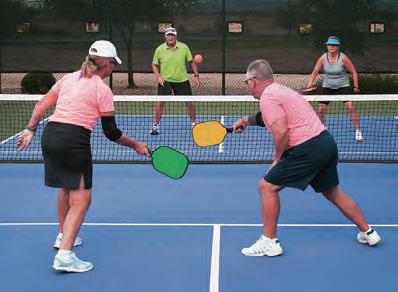
the Carriage Club in Kansas City, The Denver Athletic Club, the three such clubs in Chicago of Saddle & Cycle Club, East Bank Club and the University Club, the Johnathan Club in Los Angeles, The Briar Club in Houston, etc.
Many sports-focused, urban clubs of yesteryear have been transformed into broad appeal clubs with strong racquet programs serving thousands of members who join for the social and recreational camaraderie which only private clubs provide, and they do it for 75 percent less cost than golf-focused country clubs in their marketplaces. And in almost all instances, it is the diversity offered with racquet facilities and dining/social programs that provide a plethora of fun introduced.
Racquet sports growth in private clubs is the new opportunity to attract more members and usage for all age groups with the best value for cost offering leading the way. There is a racquet sport for all members as there is now even wheelchair tennis for the physically handicapped. The downtown city club of yesteryear is expanding to serve the residential growth in downtown areas. The same clubs are opening suburban branches and the Lifetime Fitness clubs have joined the expansion too. And thanks to the growing popularity of racquet sports available on a year-round basis, all clubs can experience a rebirth primarily based on expanding racquet sports enjoyment. BR
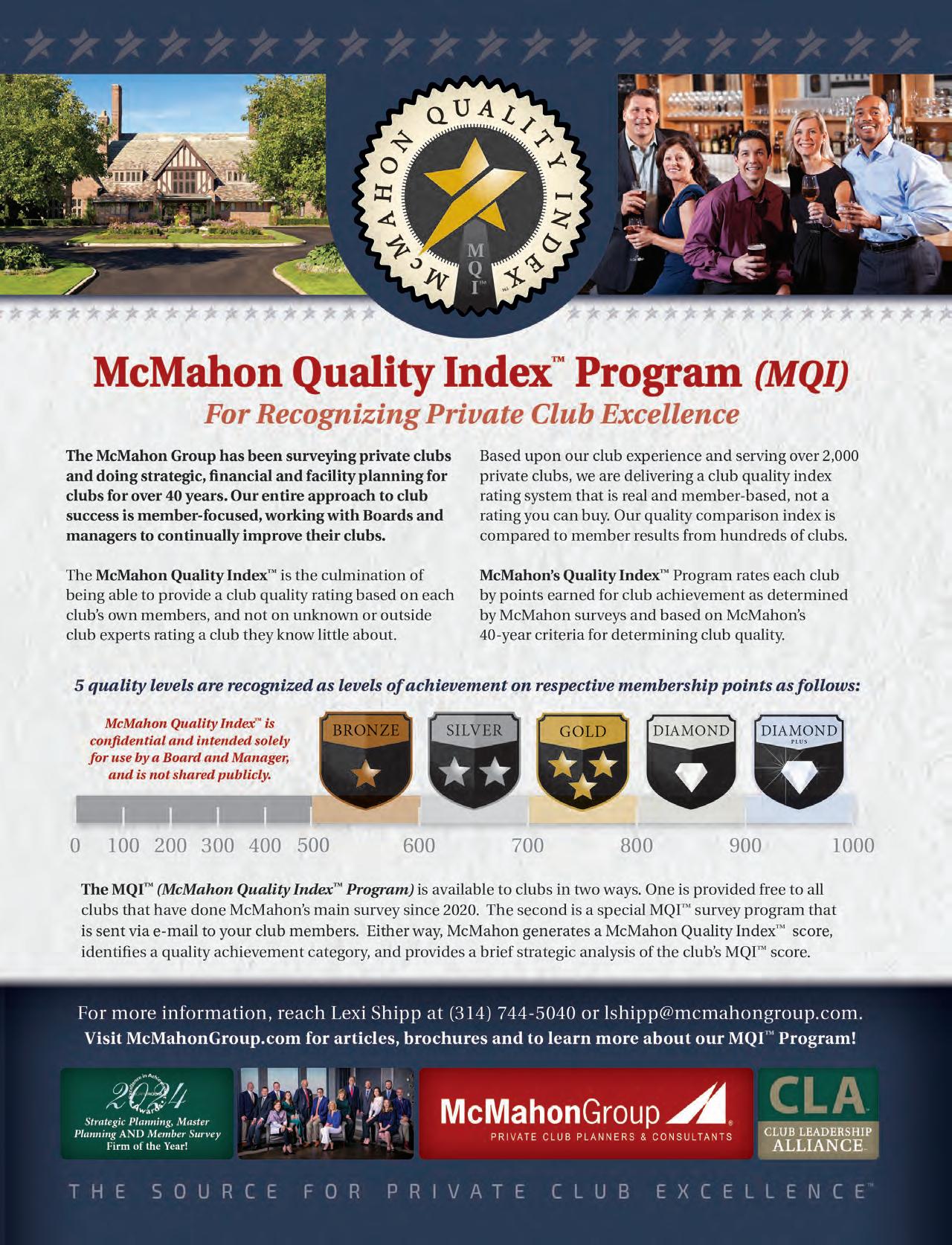


PATRICIA SAMPSON
Patricia Sampson, ASID, NCIDQ, is director of business development at Peacock + Lewis. With over 30 years of experience in luxury residential, resort and club amenity design, she has fostered client relationships, driven business growth and mentored the interior design team since joining the firm in 2021. She can be reached a (239) 631-2332 or psampson@PeacockandLewis.com
The racquets industry has been getting more attention in recent years as members are looking to enjoy the breadth and variety of sports within it. The development, enjoyment and expectation of paddle tennis, racquetball, squash, pickleball, padel, as well as tennis has changed the way a club delivers the amenities and hires the right staff.
Racquets Directors are now the norm and oversee a team of racquet pros who carry credentials for each and/or all of the various racquet sports. Peacock + Lewis is engaged at all phases of the design and development of these facilities from early site planning for space allocation to architecture and interior design thereof. As an example, pickleball court space allocation has evolved and enlarged in a short time as younger and more athletic players look for a suitable professional layout. Sizing the area appropriately early allows for full amenity design with shade structures, lounge seating, viewing, comfort and hospitality stations.
Looking forward, padel is the hot new sport even though it has been around for many decades. Newer to the US, clubs are making room for the amenity, often in addition to the other offerings rather than in replacement. In Palm Beach, Florida, Padel is already in place at private estates and is planned at The Breakers as well as the historic Bath & Tennis Club. While some opt for a temporary facility, most are building for padel permanently.
Two years ago, The Directors Club of America launched to provide a network for the leaders in club racquets. Peacock + Lewis is proud to be a sponsoring partner as we engage in conversation with racquets directors, rising leaders, and the manufacturers supporting this industry across the nation and beyond. Many of the professionals in the clubs originate from outside the US. BR




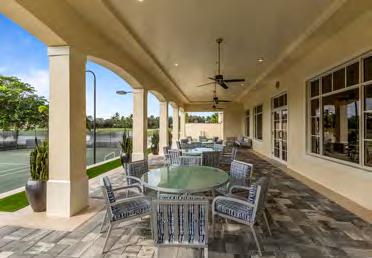


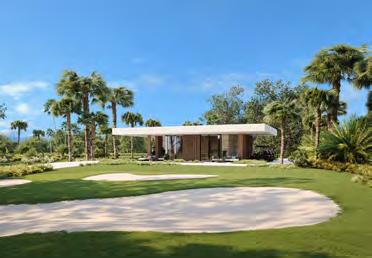
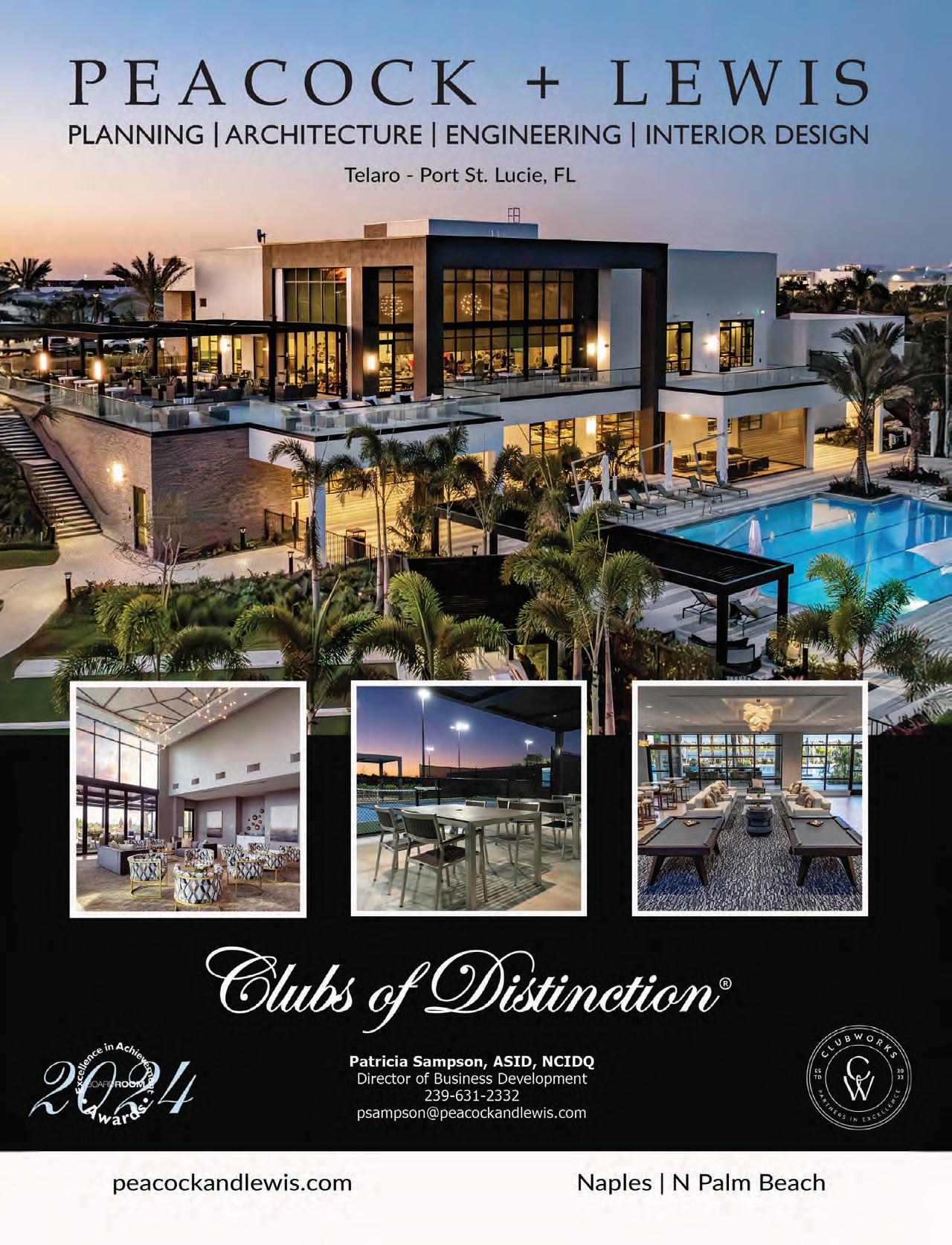


ERIK B. PETERSON
Erik B. Peterson is president of PHX ARCHITECTURE. He can be reached at (888) 217.1117. For more information, please visit www.phxarch.com
Warbird National is a groundbreaking 501(c)(3) nonprofit project that seamlessly integrates a world-class golf destination with a living aviation museum and an immersive educational campus. Located adjacent to Davis-Monthan Air Force Base in Tucson, Arizona, the development is the first of its kind to transform a military setting into a dynamic public-facing tribute to American airpower and innovation.
Designed by legendary golf course architect Rees Jones, the 54-hole destination sets a new precedent in experiential design. But what truly distinguishes Warbird National is its unique integration of over 30 full-size combat aircraft, mounted in “flight” above the fairways. These jets—sourced from the neighboring aircraft boneyard—have been rescued from retirement to become soaring tributes to American service and sacrifice. Far from being static museum pieces, the aircraft animate the landscape, forming one of the most ambitious military memorials in the country.


THE CLAW: A HUB FOR EDUCATION AND HONOR
At the core of the campus is the Center for Learning and Winning (CLAW)—a 40,000-square-foot architectural statement of purpose. Designed by PHX ARCHITECTURE, the CLAW is composed of two hangar-style wings connected by a central pavilion, which showcases a full-scale P-51 Mustang in Red Tail livery, honoring the Tuskegee Airmen. Above, four F/A-18 Hornets are suspended in a “missing man” formation—a solemn tribute to fallen heroes. The campus is crowned by a striking glass control tower, symbolizing progress, leadership and forward vision.
Sustainability is fundamental to the project’s mission. Warbird National is fully powered by tracked solar arrays, with battery storage designed to keep the campus operational for up to three days off-grid. The campus incorporates native desert landscaping and cutting-edge water conservation systems, with plans to achieve LEED Platinum certification.
Warbird National is more than just a destination—it is a mission-driven legacy project that brings together education, tribute, recreation, and sustainability. As Chairman Jay Hedley puts it, “We’re not just building a campus—we’re creating a platform to educate, inspire, and serve future generations.” From design to purpose, Warbird National represents a new era of civic architecture where meaning, beauty, and mission align. BR
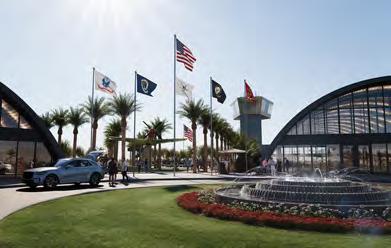
PHX ARCHITECTURE has been working on private and public clubhouse design for over 25 years, establishing themselves as the premier clubhouse architect nation-wide.





As the expectations of private club members continue to evolve, so does Shadow Wood Country Club. With a bold new capital investment coming to life in 2026, the club is introducing a transformative lifestyle center that blends elevated leisure, modern amenities, and community-first design for the next generation of members.
Private clubs across the country are evolving, influenced by a new generation of members who prioritize meaningful experiences over long-standing traditions. Today’s members span multiple generations and are drawn to clubs that support wellness, social connection, and a balanced lifestyle. Shadow Wood’s forward-thinking response to these changing demographics is clear: invest in amenities that match a broader, more lifestyle-driven definition of luxury. The result? A new lifestyle center that delivers on every front—athletics, relaxation, dining, and connection.
At the heart of the expansion is a resort style pool complex featuring zero depth entry, a kids’ zone, lap lanes, and tranquil water features. Private cabanas, plush seating, and full towel service elevate the experience, while the Pool Bistro and Grab & Go café offer seamless poolside dining and convenience.
Adrian Karapici, AIA, NCARB, is the principal architect at AM Design Group, a full-service architectural and interior design firm. To learn more, visit www.amdesign-group.com.
Pickleball continues to surge in popularity, and Shadow Wood is making history with the area’s first private indoor pickleball facility. With six climate-controlled courts, year-round play is guaranteed, paired with a robust program of lessons, clinics, and events. The adjacent racquets pro shop makes gearing up effortless. Tennis also sees a major refresh with eight relocated, upgraded courts and stadium-style seating that enhances both play and spectator experience.
Inside the lifestyle center, members will enjoy locker areas, a cozy lounge and bar and a convenient mini market. It is a space designed to serve everyday needs and special moments alike, blending utility with a resort-like ambiance.
This expansion is not just about amenities. It is about staying ahead. As club culture becomes more global, social, and experiential, Shadow Wood is investing in spaces that support wellness, connection, and modern luxury.
By anticipating what tomorrow’s members want today, Shadow Wood is doing more than evolving. It is leading. BR


ANGELA GRANDE
Angela Grande is founder and CEO of Angela Grande Design, an award-winning full-service interior design firm specializing in clubhouse and high-end residential interiors.
Angela can be reached at (917) 873-2425 or via email at agrande@agrandedesign.com

At Angela Grande Design, we specialize in full-service interior design with a deep expertise in clubhouse interiors. Over the years, we’ve been honored to receive industry recognition, including Golf Inc.’s Clubhouse of the Year and BoardRoom magazine’s Excellence in Achievement Awards.
While clubhouse interiors remain at the heart of our work, we also design guest rooms and cottages that are part of a club’s broader campus, such as our work at Sebonack Golf Club in Southampton, N.Y.
We provide master planning collaboration with clubhouse architects, as well as schematic design, design development, millwork design, and construction documents.
Our procurement services begin with project budgeting and extend through global sourcing, product value engineering, on-site

installation, and financial closeout documentation. I personally lead the design of every project, alongside a talented team with longstanding history at the firm.
Over the years, we’ve cultivated strong partnerships with clubhouse architects, enabling us to deliver seamless, successful projects time and again. We understand that honoring a club’s history, while elevating design to meet today’s member expectations, is essential.
One of our current projects is the American Yacht Club, a property rich in heritage. Every design detail, from bespoke millwork to thoughtfully curated furnishings, is developed in close collaboration with club leadership and members to ensure their history is preserved and celebrated.
The decorative nautical pieces collected over the years will remain, but they’ll now be complemented by a refreshed, cohesive interior that reflects both the past and the future of the club.
We look forward to sharing this project with you soon. If your club is ready to elevate its interiors while honoring its history, I’d love to explore how we can work together. BR




RICK SNELLINGER
Rick Snellinger is president and CEO of Chambers, a leading design firm with over 75 years of experience in the private club industry. Founded in 1899, Chambers brings historic expertise and forward-thinking solutions to every project. For more information call (410) 727-4535 or visit www.chambersusa.com
Bonnie Briar Country Club has long been known for its warm, family-friendly culture and storied golf history just 30 minutes from Manhattan. Today, the club is embracing a bold new vision that balances preservation with progress and is anchored in the surging popularity of racquet sports and a demand for dynamic member experiences.
In partnership with Chambers, a national leader in private club planning and design, Bonnie Briar embarked on a comprehensive, multi-phased master plan aimed at reinvigorating the entire campus. The plan addresses all recreational facilities—from racquet sports and golf to aquatics and social amenities—while also tackling years of deferred maintenance to ensure long-term operational sustainability.
At the heart of the initiative is a commitment to active, all-season engagement. A new paddle and pickleball hut is designed to support the explosive growth in racquet sports. The thoughtfully scaled facility includes an indoor/outdoor fireplace, flexible lounge space for events and social gatherings, dedicated restrooms, and a pro
office, creating a true four-season destination for camps, clinics, and league play.
These enhancements are complemented by a new golf and tennis performance center—a multipurpose facility nestled between the existing driving range and tennis courts—featuring indoor/outdoor simulator bays, an indoor putting zone, a casual bar/lounge, and a new tennis pro shop.
The design of both new buildings prioritizes lifestyle and playability, giving members of all ages two vibrant hubs for year-round activity. Other elements of the master plan include a revitalized pool complex with expanded family amenities, as well as enhancements to the clubhouse and updated finishes throughout, demonstrating a complete and thoughtful approach to club reinvestment.
With Chambers as its strategic partner, Bonnie Briar is positioning itself for a strong, sustainable future—one that honors its heritage while creating more opportunities for connection, recreation and community for generations to come. BR











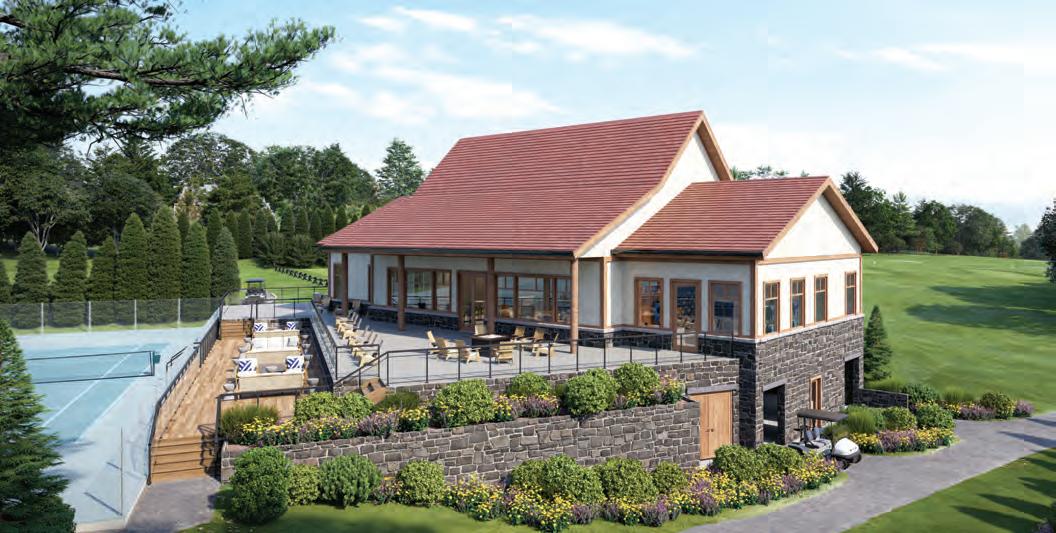




Lawrence J. “Skip” Avery CCM, CCE, CMAA Fellow, is director of club development at Stone Group Architects. He can be reached at (608) 335-0342 or SkipA@stonegrouparch.com

Racquet sports are experiencing a remarkable period of expansion, with participation across multiple disciplines growing at a pace that few private clubs are fully prepared to meet. Pickleball alone reached 19.8 million players in 2024, a 46 percent increase over the previous year, while tennis continues its resurgence, driven largely by younger and more diverse player demographics. Padel, although still in early stages of U.S. adoption, is gaining momentum, with projections nearing 10 million domestic players by 2030.
As member interest intensifies, club leaders are often compelled to respond quickly. However, retrofitting courts or expanding facilities without a clearly defined programming strategy is one of the most common—and costly—missteps in capital planning. The most successful projects begin not with design, but with data: understanding how members want to play, what services they expect, and how each racquet sport fits into the broader membership experience.
Programming requirements vary significantly between sports. Tennis typically demands professional instruction, high-performance surfaces, and league-ready infrastructure. Pickleball emphasizes flexibility, social activation, and shorter play durations, making court

turnover and scheduling efficiency critical. Padel courts require specialized materials and enclosed construction, representing a more substantial investment with a narrower, though growing, audience.
Clubs that lead with programming insights are better equipped to make smart allocation decisions. A single tennis court can accommodate four pickleball courts, increasing utilization if supported by member demand and appropriate amenities. When facilities are planned to serve specific programming goals, rather than adapted retroactively, they deliver stronger returns both financially and experientially.
A disciplined planning process also helps mitigate resistance to change. Transparent communication, member involvement through surveys or pilot programming, and phased implementation strategies promote buy-in and ensure alignment across stakeholder groups.
The return on investment (ROI) for racquet sports facilities must consider both revenue and efficiency, while the return on experience (ROE) reflects member satisfaction, retention, and engagement. Clubs that prioritize both from the outset are best positioned to modernize responsibly and sustain long-term value. BR


MATTHEW BLONDELL
Matthew Blondell is director of risk consulting with RSM US LLP.
A CPA and construction specialist with more than 15 years of experience, he advises clients on contract compliance, internal controls and capital project oversight. He is a frequent speaker on construction auditing and facilities management. He can be reached at matthew.blondell@rsmus.com
In today’s evolving private club environment, outdoor spaces have emerged as a defining feature of modern club design. From alfresco dining and fitness pavilions to resort-style pools and multiuse patios, these enhancements align with shifting member expectations and long-term capital strategies. However, behind every picturesque terrace or fire-lit lounge lies a critical element that boards and general managers must navigate with precision— construction risk.
Construction projects, particularly those tied to outdoor spaces, present a unique set of challenges that can derail budgets, timelines and member satisfaction. Understanding how to mitigate these risks is essential to successful capital improvement planning.
Unlike indoor renovations, outdoor projects are vulnerable to variables beyond a club’s control. Weather delays, permit delays and site access challenges can all add time and cost to a build.
For example, a club in Florida plans to open its new pool in the fall, but a midsummer hurricane delays the contractor’s progress and the county’s building inspectors are inundated with rebuilding efforts, which further adds to the project timeline. Including contingency in the overall project schedule helps reduce the risk of timeline disruptions and gives the club flexibility to open the project as planned.
Boards should be prepared for the unpredictability of working outdoors, and probable seasonal impacts should be built into the initial design and budget phases, not addressed as problems arise.
Risk management begins well before the first shovel hits the ground. The preconstruction phase must be thorough and deliberate. Involving experienced professionals—architects, designers, engineers, construction managers and consultants—early in the planning process helps identify potential issues before they escalate.
Clubs often overlook the opportunity to connect the design and construction teams early in the planning process. This early collaboration allows the designer and contractor to evaluate the design for constructability and address issues before work begins. For example, identifying drawings that are inadequately detailed or pinpointing conflicting locations of utility and structural components during the design phase can save time, money and member frustration.
Renovation projects frequently run into issues when the designer does not incorporate as-built drawings—details of the existing structure—or uses outdated or inaccurate as-builts when planning for the new project. Without accurate reference drawings
or investing in a forensic evaluation of the existing building, the club risks discovering issues mid-project. Determining existing conditions reduces the risk of budget or schedule overruns once the project is underway.
The way a construction project is contracted plays a major role in risk allocation. Boards should work closely with legal counsel and construction consultants to review contract types such as lump sum, guaranteed maximum price (GMP) or design-build, and understand which is most suitable based on the project’s complexity.
A GMP contract, for example, may offer more cost predictability and transparency into the true cost of the project. Clubs must carefully assess how change orders, contingency funds and responsibility for delays are addressed in the contract.
Clear and continuous communication is essential to manage expectations and minimize disputes. This includes documenting every stage of the project, from board approvals to change orders and site meeting notes. An authority matrix detailing who is allowed to approve changes and their approval limits helps reduce the risk of cost or schedule overruns stemming from multiple decision-makers.
General managers serve as a vital link between the construction team and the membership. Weekly updates delivered through email newsletters, website portals or member town halls keep members informed and reduce anxiety about progress and access disruptions.
Clubs should also establish a point person or project manager who is responsible for daily oversight and coordination. This individual ensures that the project stays on track and that conflicts are quickly addressed.
Outdoor enhancements can transform the member experience and elevate a club’s appeal. Yet, the path to those transformations is rarely risk-free. Construction risk, whether in budget overruns, design conflicts or unforeseen site conditions, is not a matter of “if” but “when.”
Boards that approach capital improvement planning with rigor and align themselves with experienced professionals are best positioned for success. Managing construction risk is not just a technical necessity; it’s a leadership imperative. BR



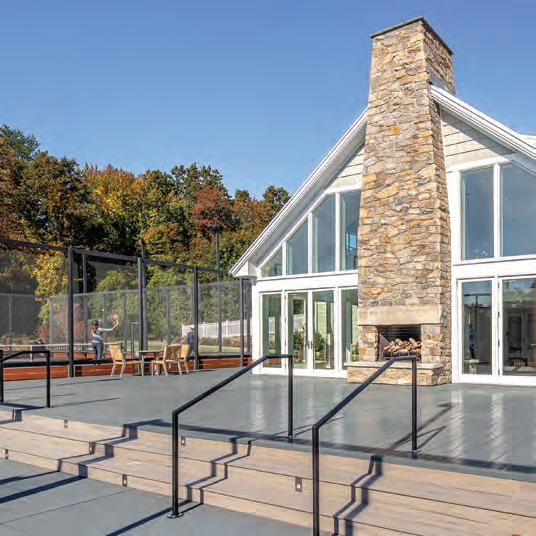

Have you ever walked into a clubhouse that looks like a strange mix of Early American, Mediterranean, Southwestern, 18th-century French, high-tech and Spanish traditional styles?
When styles clash like that, it’s a clear sign that there’s no professional master plan in place. Without a board-approved professional interior design strategy, clubhouses gradually become a patchwork of mismatched ideas—often shaped by whoever had the latest, loudest opinion. The result? Visual confusion and a lack of continuity. (The same thing can happen to golf courses— but we’ll get there.) Think about your own home. What if every family member decorated a room?
• Your college-aged son does the living room
• Great Aunt Meltha takes the dining room
• Cousin Bobby tackles the front entry
• Your mother-in-law handles the master bedroom. The result would be chaos—no matter how well-intentioned everyone was. Clubs that approach décor with scattered, piecemeal updates over time ultimately hit a wall, declaring there’s “no need to spend more for a few years.” Translation: deferred maintenance. In this case, looks are not deceiving.
Plutonium Clubs don’t allow members—however passionate— to dictate décor or design decisions. Ideally written into bylaws, clubs should adopt policies that prohibit meddling and instead rely on a board-approved professional master plan reviewed annually. There are top-tier national firms that specialize in private club design. Invite a few to visit and produce a “first impressions” report. The right firm will develop a phased, long-term master plan tailored to your club’s culture and identity. A good firm goes beyond color swatches. It will provide exact furniture layouts, artwork placement (down to the inch), lighting plans and detailed selections for finishes and treatments. No more busboys deciding where couches should go after every event. Once you find the right cultural fit, retain that firm for at least three to five years to ensure continuity and alignment with your evolving needs.
Consistency comes from structure. Schedule two annual walkthroughs with your board-approved professional design firm and management team. This ensures clubs stay ahead of routine wear and tear—and avoid costly surprises in years to follow.
1. Seasonal Pre-Closing Walk-Through
Scheduled before annual club closures for maintenance or staff breaks, this walk-through identifies:
• Furniture needing repair or replacement
• Paint touch-up areas and appropriate colors
• Lighting adjustments and fixture upgrades
• Carpet, tile and window treatment needs
MICHAEL CRANDAL
Michael Crandal, CNG, is a national award-winning leader in building exemplary management teams. He co-authored TheABC’sof PlutoniumPrivateClubLeadershipand offers a complimentary preview at plutonium.club. He can be reachd at mjcatexmor@aol.com, (760) 464-6103 or linkedin.com/in/michaelcrandal.
• Wall coverings and surface wear.
Make it a policy to shut down major areas of the clubhouse for at least two to three weeks each year. Maintenance needs time and space to be effective.
2. Midyear Walk-Through
Scheduled about seven to eight months into your fiscal year, this inspection:
• Reviews current conditions and priorities
• Collects bids for needed projects
• Generates a written report for budget planning. This structure ensures you always know:
• What needs attention
• When it’s scheduled
• How much it will cost
• Who will do it
• And why it’s being done at all.
1. A dedicated housekeeping staff
2. A systematic preventative maintenance program
3. A professional design firm with a long-term plan. Even the best design won’t hold up if the club skips regular daily cleaning or maintenance. And that elegant new ceiling? Worthless if a leaky pipe above ruins it six months later.
Just as clubhouses can lose identity through amateur meddling, so can golf courses. Every member-owned club has a few low-handicappers who think they’re gifted golf course architects. Without a guiding plan, you end up with:
• Random bunker placements
• Inconsistent green shapes
• Unplanned tree removals or additions
• Confusing tee box and cart path layouts.
And as committees and boards evolve, decisions shift—further unwittingly muddying the course’s identity. That’s why Plutonium Club leaders follow the same process as with the clubhouse. They interview professional golf course architects, gather proposals and select one to develop a board-approved master plan. With phased implementation and alignment with member expectations, the result is a memorable course with flow, continuity and character—not a Frankenstein layout of patchworked ideas.
Whether in the clubhouse or on the course, great clubs don’t become great by accident. They’re guided by vision, professionalism and structure so that the experiences they offer are indeed memorable—but for all the right reasons. BR
BoardRoom is more than a magazine, it’s your club’s 24/7 governance library
On September 1, we’re launching a bold new digital platform built exclusively for club leaders, board members, presidents, general managers, committee chairs and department heads.
Your $295 annual subscription includes the awardwinning print edition plus full digital access to:
• 10 years of searchable back issues with 4,000+ expert articles
• A private club job board for boards, GMs and department heads
• Podcasts with industry experts
• Innovative ideas, governance spotlights, vendor guides and flipbook editions
• Unlimited access for the whole club
For 30 years, BoardRoom has replaced emotion with fact, equipping private clubs with insight, strategy and shared solutions. Now, we’ve put it all in one place.
Subscribe now and get everything you need to lead with clarity and govern collaboratively. Already a subscriber?
You’ll still receive the print edition, but to unlock full digital access, contact Krystal at (949) 376-8889 or krystal@apcd.com.


If you think the pickleball-powered racquet renaissance is going to peter out, think again.
The Sports & Fitness Industry Association says pickleball was America’s fastestgrowing sport for the third straight year in 2023 with 8.9 million participants aged six years or older playing at 11,000-plus locations.
One place where people are rabid about racquet pursuits, pickleball and tennis, is Country Club of Spartanburg. The centennial club has long been recognized by the U.S. Tennis Association as one of the top 100 programs.
But the club took racquets to even greater levels this spring when it opened a newly built $10 million-plus facility with eight pickleball courts, nine tennis courts (seven clay and two hardcourt surfaces), stadium seating, pro shop and office pavilion.
The KDC Architects-designed project was so important, the club rerouted and rebuilt three golf holes to free up high-profile racquet real estate right up to the clubhouse so tennis players no longer have to traverse golf holes to enjoy the rest of the club. BR



BRUCE BARILLA
Bruce Barilla has consulted at over 60 clubs. As a courtesy, he provides many complimentary teaching tools for a better locker room at: www.lrcgolf.com
I have always liked serving members and guests when working at golf and country clubs. Doing so made me feel good and gave me a sense of satisfaction. Truthfully, I feel more comfortable sometimes waiting on others rather than being waited on. For example, I would rather be the caddie, which I did as a teenager and also in my 30s, than have a caddie.
My combined years of golf locker room experience include eight years at Butler National Golf Club and 12 years at The Greenbrier. This pales in comparison, though, to those employees with many decades of service at clubs and hotels throughout the country. These individuals deserve recognition in a very special way.
WHY RECOGNIZE SUCH EMPLOYEES?
In a time when it is difficult to find and keep good employees, those with 20, 30, 40 and 50 or more years of service are a breed of their own. They know all the members, their personal preferences and their children’s names, and they maintain close friendships with many without crossing the line between the employer-employee relationship. They make the membership feel extra special and are a reason why members like to go to the club. A few have a national reputation. Their upbringing has a lot to do with their work ethic and character. They set an example for other employees to emulate and are mentors.
It is a show of appreciation when a club takes the time and makes the effort to recognize such employees. It is the right thing to do. Doing so boosts staff morale and provides an incentive for other employees to remain loyal and dedicated. By bestowing honor, the club is honored, too. The club shows a touch of class, and, truthfully, class also includes compensation and sometimes reconciliation.
WAYS TO RECOGNIZE
I do not recall which club I visited down South, but while touring the clubhouse, I noticed that the club named one of the dining rooms after an employee with many decades of service. This impressed me, left a lasting memory and motivated me to encourage departments at other clubs to do the same.
For employees with 50 or more years of service, I know of clubs hosting and sponsoring a banquet in their honor. This can include a chauffeured limousine to and from the special occasion. Gifts from the members and the club are the norm and customarily include cash or checks in thank-you cards. An all-expenses-paid luxury vacation and a new Cadillac are other worthwhile considerations. Upon retirement, such employees can be elevated to emeritus status and greet members and guests at outings and events. They will be a welcome sight.
This true story does not include gifts received, dinners held nor was it a news story on the local TV station. Only five of us were present. Not many people know about it either, and it was quite unexpected on my part. Every time I tell it to others, I almost get teary-eyed.
As a young boy, Gaston Caperton came with his family to The Greenbrier. Don Crump, who worked in the golf club locker room, saw young Gaston during these times. Don worked at the hotel for 52 years before retiring and knew many people. In fact, after his retirement, a day almost did not go by without a guest inquiring about Don’s whereabouts.
One day, Don, Carl, James and I were working together at the same time because it was a busy day during the golf season. Young Gaston, who is now a grown man, comes into the locker room and says “hi” to Carl, James and me, calling each of us by our first name. However, to my surprise, when he saw Don, he said, “Hello, Mr. Crump.” Don respectfully replied, “Hello, Governor.” BR
TIP OF THE WEEK #87
Service: recognition of

Mike Strauss is GCSAA’s media relations manager.


Labor challenges can affect many golf clubs. Finding a workforce amid competition from options outside of golf can be difficult. Golf course superintendents continue to list finding and retaining employees as one of their biggest challenges. Without a highly trained golf course maintenance team, the quality and playability of the golf course can easily be jeopardized.
In response to the ongoing labor challenges faced by the golf industry, the Golf Course Superintendents Association of America has developed a video training series for golf course maintenance crew members.
These videos aim to enhance the skills and knowledge of maintenance teams, ultimately benefiting golf clubs. They were developed based on requests from GCSAA members as part of the association’s workforce development programs to help superintendents attract, train and retain employees.
Free and available exclusively to GCSAA members, the GCSAA Video Training Series offers 11 crew-based videos on topics such as cup cutting, greens mowing and a general introduction to a golf course. Video topics include:
• This is a golf course
• Tee service
• Greens mowing
• Walk behind greens mowing
• Safety basics
• Handheld equipment
• Bunker maintenance
• Hand watering
• Ride-on equipment.
The videos will also be available in Spanish and French later in 2025. Additional series are planned for future release to provide superintendents with a robust catalogue of content helpful to developing skilled employees.
By using the training series, golf clubs can improve staff retention and performance, leading to enhanced course conditions and member satisfaction.
“There is a high demand for crew training information as finding and keeping qualified labor continues to be a challenge


LARRY HIRSH
Larry Hirsh, CRE, MAI, SGA, FRICS, is president of Golf Property Analysts, a leading golf and club property consulting firm in Philadelphia. He blogs on club and appraisal issues at blog.golfprop.com and authored TheCultureofGolf–Isn’tIt JustaGame?available at golfprop.com/the-culture-of-golf.
During the past five-plus years, golf has enjoyed a surprising and welcome surge in popularity. Rounds have increased. Private clubs reported surging membership, and it is widely believed that more than half the nation’s private clubs have waiting lists for membership. Is that all about to change?
We’ve experienced the Federal Reserve raising interest rates, sometimes by as much as three-fourths of a percent—the largest increases in more than 30 years. We know about the current inflationary environment and rising (and then rapidly falling) gas and food prices. Is the traditionally affluent golfer population immune to this? While we recently explored golf’s sustainability relative to water, how much do we know about the economic sustainability of golf’s growth from the past five years?
It wasn’t so long ago that clubs were begging for members, golf courses were closing at alarming rates and golf retailers were closing their stores. It’s been said that COVID-19 did for golf what Tiger Woods couldn’t do. The National Golf Foundation reported a “slower start to the season,” which was blamed, at least partly, on weather conditions. With May through August typically responsible for approximately 45 percent of annual golf rounds, it won’t be long before we begin to see a picture of how sustainable the COVID-19 surge is.
You might think this spells doom and gloom for the golf industry. However, despite the persistent inflation, mitigating factors could work to golf’s advantage. As expected, although many workers are returning to the office, many are also embracing and pursuing working remotely or, at the very least, visiting the office less frequently. Eliminating the commute leaves more time for golf—or at least to visit the practice range.
Combined with historically low unemployment, although impacted by higher prices from inflation, consumers are still more likely to participate in recreational activities like golf, even if less frequently, than if they were unemployed or their business required more hours.
Existing economic conditions are somewhat unique. Low unemployment, high corporate profits, increasing interest rates and high inflation send mixed signals. The stock market (DJIA), as of May 14, is at 42,074—more than double its COVID-19 low point on March 20, 2020. Of course, who gets credit or blame for these and other economic indicators is likely to depend on one’s political allegiances; the fact is that COVID-19 was an unprecedented shock to the economy, and corrections and measures to stabilize were and are inevitable. So, where does this leave the golf industry in 2025?
Golf’s fundamentals are unchanged. It is an activity that can be pursued late into life with both friends and family. It’s out-
doors and a vehicle for socialization. While perceived by some as expensive, it’s cheaper (in some segments) than many other leisure activities—but it is a very inefficient use of land assets, allowing a limited number of participants at any one time on a large piece of ground.
How sustainable is the surge? Most observers have opined that some of the growth will endure. Nobody knows how much. To sustain growth, IMHO, the golf culture needs to progress, not only embracing but also actively capturing a broader cross-section of the population. Like many industries, diversity, equity and inclusion (DEI) has become a popular buzzword in golf but needs to be successful. In an article I wrote in 2017 (“Is Golf’s Culture Its Own Worst Enemy?”), I discuss some of the (self-imposed) obstacles to the growth of the game. I discuss them at further length in my book, “The Culture of Golf – Isn’t it Just a Game?”
Negative economic pressures will impact golf. Rising interest rates could reduce the number of potential buyers in the market and restrict clubs from making enhancements and improvements to facilities. More “second thoughts” about establishing or continuing membership could lead to a reduction in rapidly escalating entrance fees, dues or other costs of membership, making golf more attractive in a more competitive environment (both with other clubs and other activities). Daily fee and destination golf would also be impacted should there be an economic slowdown.
It stands to reason that if you’ve read this far, you’re wondering what I think will happen. While I can’t confidently predict our economic future, I’ll offer some comments:
• Golf can sustain at least some of its gains, especially if it broadens its appeal and reach more assertively than just talk.
• History tells us that golf property (clubs/courses) will not fluctuate that much in value on the basis of capitalization rates and revenue multipliers.
• Buyers will continue to seek acquisitions of golf properties.
• There is likely to be a higher percentage of golf properties (especially lower revenue) sold with some type of seller financing, depending on the lending environment.
• If the economy is perceived to be declining, club membership will be impacted. Any number of elements could fluctuate. Membership and rounds at daily fee courses could decline. Entrance fees could be impacted. “Deals” on dues and green fees might be offered as in the past. If government measures are perceived as successful, each of these factors could increase.
• The fact that there are fewer golf courses than 15–20 years ago will cushion any impact as supplies are not likely to increase dramatically.
• The nationwide housing shortage could encourage more closures as golf courses could be redeveloped.
Nobody saw the golf surge of 2020–2025 coming; in fact, many expected COVID-19 to hurt golf. Now that we are perceived as recovering from COVID-19—even though it’s still there and we have to be vigilant—I think golf can capitalize on the surge by broadening its base and sustaining an environment of growth. Course closures have been down of late, and most are of the lower-end daily-fee and 9-hole variety, some of which have become at least marginally profitable during the COVID-19 period. Time will tell if those remaining will survive long term.
With the mixed economic news, one question lingers: “Are we headed for a recession?” One answer is that if we’re not in a recession now, we’re headed for one. The NGF acknowledges that while golf caters to a relatively affluent customer base, with 47 percent maintaining incomes of at least $100,000, 53 percent are making less than $100,000 and are more sensitive to a potential recession, possibly even before it gets here. As of year-end 2024, Golf Datatech reported US rounds up by 2.2 percent year over year.
Unfortunately, in today’s politically charged environment, economists often take a politicized position, and we’re all left to sort it out on our own. That said, our society in general and the game and industry of golf in particular have survived lots of “ups and downs.” Golf will survive any potential decline as well. The key, IMHO, is to anticipate and avoid or minimize that decline by broadening golf’s appeal. BR
• Ensure new members understand the club’s rules, values and expectations from day one.
• Recognize examples of positive behavior.
• Encourage members to uphold standards within their peer group.
2. Encourage open communication and a safe environment for reporting
• Create safe, accessible channels (confidential email address) for members to voice concerns.
• Identify mediators or club leaders to resolve issues informally before they escalate.
• Consider whether the club will allow anonymous reporting.
3. Implement a progressive and consistent disciplinary system
• Begin with verbal or written warnings and escalate as necessary.
• Document all incidents and actions for consistency and legal protection.
• Apply standards uniformly across all membership levels to maintain trust.
• Consider a “three-strikes” system for recurring violations.
Some of the most respected clubs today have transitioned back to structured onboarding and formal grievance processes. A well-trained, impartial disciplinary committee backed by a clear charter strengthens a club’s integrity and cohesion. When combined with proactive behavioral initiatives, this structure fosters a respectful and engaged community. In today’s evolving club landscape, consistency, communication and accountability are the keys to long-term harmony. BR


TARA OSBORNE
Tara Osborne is a principal and search consultant at GSI Executive Search. She can be reached at (512) 965-5643 or via email tara@gsiexecutivesearch.com
After spending 20 years in club operations and managing everything from large-scale events to delicate board dynamics, I now sit on the other side of the table as an executive recruiter. I’ve interviewed hundreds of candidates and helped place countless professionals in roles where they thrive.
In doing so, I have watched as interviews were won or lost in the first few minutes.
Here’s the truth: The first five minutes of your interview matter more than anything else. That opening moment sets the tone, defines your presence and gives your interviewer their first insight into how you carry yourself as a leader. I’ve seen brilliant candidates stumble right out of the gate not because they weren’t qualified but because they didn’t prepare to tell their story.
So, let’s talk about how to open strong and sell your value right from the start.
Step One: Mindset Over Mechanics. Before you walk into the room or log onto Zoom, take a breath and shift your mindset. This isn’t just an interview—it’s a conversation between professionals. You’re not begging for a job. You’re evaluating whether this is the right next step for both sides. Confidence doesn’t mean arrogance. It means being grounded in what you bring to the table. After two decades in this industry, I can spot someone who knows their worth without overselling it. They sit a little taller. They speak with intention. They look the part. And they know that the way they start the conversation matters.
Step Two: Prepare Your Opening Pitch. You will always be asked some version of “Tell me about yourself” or “Walk me through your background.” This is not the time to list your résumé line by line. This is your elevator pitch—a concise, polished summary that connects your experience to what they’re looking for. Let’s put it into action:
1. Start where you are today: “Currently, I’m the assistant general manager at XYZ Club, where I oversee all day-to-day operations, including F&B, member engagement and staff leadership …”
2. Take a step back: “Before that, I spent nearly a decade leading food and beverage teams at several high-end clubs across Texas. I’ve worked through major renovations, launched new service models and built teams that were known for culture and consistency.”
3. Tie it to their opportunity. “What drew me to this role is the chance to take that operational depth and apply it at a club that’s investing in its future, from amenities to member experience.”
Practice, practice, practice. Practice it out loud. This should sound like you’re telling a story, not reading from a script.
Step Three: Lead with Outcomes, Not Duties. One of the most common mistakes candidates make is reciting their job descriptions. Here’s the thing: Every candidate has managed staff, created budgets and overseen events. What makes you stand out is how well you did those things and what results you achieved.
Instead of saying: “I was responsible for overseeing the food and beverage department,” try: “When I took over the F&B operation, we were running at a 12 percent loss. Within 18 months, we turned that into an eight percent margin by revamping scheduling, retraining staff and aligning our pricing with member expectations.”
Be specific. Be results-oriented. This shows that you’re not just a doer, but a leader who drives performance.
Step Four: Connect with Their Mission or Pain Point. Great candidates don’t just show off their skills—they show that they understand the club they’re applying to. Do your research. Know their amenities, read about recent projects and, if possible, talk to people who know the culture. Then, in your opening, connect your background to their journey: “I saw that the club recently completed a clubhouse renovation and is focusing on growing younger member engagement. At my last club, we faced a similar challenge, and I led a team that created new programming and dining options that increased usage by members under 40 by 30 percent over two years.”
This signals that you’ve done your homework—and that you’re already thinking like part of their team.
Step Five: Let Your Personality Show. In club management, technical skills are essential, but your personality wins trust. Your authenticity matters—especially in private clubs, where cultural fit is everything. The best openings I’ve seen weren’t just polished—they were human. They brought energy, humor and heart. Whether it’s a brief story about your leadership journey, a shared connection to the community or your passion for creating “wow” moments for members, don’t be afraid to show the person behind the résumé.
The perfect opening isn’t about memorization—it’s about preparation, clarity and confidence. It’s your moment to say, “Here’s who I am, what I’ve done and why it matters to you.”
As someone who has sat on both sides of the hiring table, I can tell you: Interviews are not about perfection. They’re about connection. And that starts with how you open. So, when you step into that room, own your story, highlight your impact and show them you’re not just there to get the job—you’re there to make the club better. Remember, you got this! BR
AMIRALI ZINATI
AmirAli Zinati is a brand strategist and the former marketing & communications manager at the Royal Vancouver Yacht Club in Vancouver, Canada.

I began my career sketching buildings. Today, I design narratives, experiences and community touchpoints. But in truth, I’ve never left architecture behind—because the best communications strategy starts with the same principle as timeless design: form follows feeling. At private clubs, especially those with long-standing heritage like the Royal Vancouver Yacht Club, how space feels is inseparable from how it performs. Every hallway, window and terrace holds the potential to shape interaction, memory and culture.
For years, private clubs leaned into grandeur: vaulted ceilings, heavy wood, formality. But today’s members want presence over prestige. They seek connection over ceremony. I’ve seen how a wellplaced bench in a sunlit corridor becomes a spontaneous meeting place. How removing walls—literal or cultural—can invite conversation. Belonging is not built through ornate decor; it’s felt in the ease of flow, in the comfort of being seen.
THE OCEAN AS OUR CO-ARCHITECT
At RVYC, the ocean isn’t just a backdrop—it’s a design collaborator. Salt air, shifting tides, the call of gulls—they’re sensory threads that knit together the experience of place. The outstations, docks and patios don’t just offer views—they offer perspective. Design here must be porous: letting in light, breeze and the quiet rhythm of water that slows the mind and opens the heart.
I often say: architecture is silent storytelling. The layout of a lounge, the height of a ceiling, the material of a stair rail—each element communicates values. At RVYC, maritime signal flags tell more than direction—they signify identity. Trophy cases aren’t about ego—they’re continuity, history, pride. When we designed communications campaigns, we didn’t just “talk about” the club— we let the spaces speak, too.

The general manager of every club in Southern California likely watched in horror as wildfires ravaged through Altadena, leaving in their fiery wake rubble that once was the Altadena Town & Country Club. The fire displaced 120 employees, but the collateral damage was even worse; many of those same employees lost not only their jobs but also their homes.
Every general manager’s heart went out to this horrific tragedy. But what if it was your club? How vulnerable would your club be if this happened to you?
Club management is always prepared for the eventuality of a fire breaking out, electricity going haywire, an errant match, a mishap in the kitchen, etc. But are you prepared for Mother Nature’s fickleness? Will this be the last wildfire (earthquake, flood) we see? It is doubtful.
Therefore, your club must have the necessary protection in place to handle the monumental task of rebuilding as soon as possible, to mitigate the financial strain on members and employees. Here is what you need to know.
Action to take now:
• Is your broker keeping you updated? Has your broker reached out to the underwriter? What is their position today? Has it changed?
• It’s important to have the right dollar amount per square foot. Being underinsured could cripple your club if you needed to rebuild. The estimate should be around $500-$700, depending on your location.
• When the calendar hits 90-120 days before renewal, get a renewal commitment. Remember, premium is secondary to finding coverage, and rate increases are inevitable (as high as 20-30 percent). “Shopping around” could result in significant savings. What are you trying to accomplish with your renewals? Did you consider that your insurance company may not want to renew with you (especially if you filed a claim last year)? Are you prepared if that happens?
• Do they cover all significant risks your company faces at adequate levels? Do they cover what you think they cover? Carefully review coverage provisions, endorsements and exclusions. Has your coverage grown with your business? Don’t rely on just carrying your coverage over from one year to the next. When your business changes and expands, your coverage must change and expand with it.
• Take inventory of all of your coverage. Do you have all the insurance you need to cover your significant risks? Are your coverage limits adequate to protect the business? Are your officers, directors and employees adequately insured?
• Know what the notice requirements are in each of your policies and have systems in place for providing notice. Know what constitutes a claim that must be reported under the terms of your policies. Know what your policies require regarding submitting proofs of loss and the timing of such submissions.
• Keep everyone informed, especially board members. Do you have systems in place so that those responsible for providing notice to insurers are aware of claims or potential claims that must be reported?
What underwriters will look for, should there be a disaster:
• Wildfire exposure—how close are you?
• Aggregation of risks—how many clubs does the underwriter insure by zone? This can further restrict the ability to write new business.
• How much property value is at risk (typically, 80 percent of total values are at the clubhouse)? How much does the underwriter want to retain?
• Capacity restrictions—cutting back limits offered. You could be looking at 100 percent probable maximum loss scenarios.
• Is there a need for a layered program using multiple carriers? This adds cost to the program.
How to mitigate the loss:
• Use of fire-resistant building materials (roof, glass, concert tile, etc.)
• Moving-up replacement schedules
• Brush clearing
• Sprinkler system – grounds, on the roof
• On-site hydrants and hoses.
Do you have an emergency plan or a disaster recovery plan (or both) in place to get your business up and running again and to minimize the business income loss? Always consider the worst-case scenario and be prepared to deal with it. BR

TONI SHIBAYAMA
Toni Shibayama is a broker/risk consultant for S&K Insurance in Southern California. She has more than 15 years experience in risk management, job safety, workers’ compensation, wellness and HR consulting. She can be reached at toni@sk-insurance.com and by phone at (213) 627-5304.
“The club is on fire.”
As the general manager of a country club, that is the last call you want to receive. But that’s what showed up on the phone of Craig Sloane (pictured right), general manager of the Altadena Town & Country Club, at 6:38 a.m. on Jan. 8. Along with the club, the wildfires wiped out over 60 percent of the homes in Altadena, many of them belonging to club employees and members. It was the worst possible scenario.
“When I arrived,” Sloane recalled, “there seemed to be smoke coming out of the back of the clubhouse, where we get our deliveries and store our linens. Then we saw the smoke start to come out of the attic. Once we saw it come out of the vents from the attic, we knew it was pretty much a done deal.”
One of the problems was that the local water municipality was damaged, so there was no water pressure at the club, and Sloane and his crew couldn’t do anything to try and fight the wind-swept fires.
“Everything was working against us,” Sloan said.
Along with dealing with the heartache of members and employees now homeless, the club—originally built in 1911—had to be rebuilt. Fortunately, the tennis courts and the pool were relatively unaffected by the fire, though they will require some remediation. The club’s goal is to open those areas for the Labor Day weekend.
“We’re trying to keep our membership engaged,” Sloane noted.
THIS IS WHERE THE STRENGTH OF THE CLUB COMMUNITY SHINES.
“A lot of the other local country clubs in the area have really stepped up to help us, allowing us to use their courts or their facilities for different events, including the Jonathan Club, Annandale Country Club, University Club, San Gabriel Country Club, Valley Hunt Club, Oakmont Country Club and the Athenaeum at Caltech,” Sloane explained. “Our members say they made them feel like it was their club.”
Sloane emphasized that the level of support from the club’s membership and board has been fantastic, and the club is in the process of hiring an architectural firm. But any happiness must be tempered.
“We still need to realize there were over 6,000 homes destroyed,” he pointed out. “Most of the business community is gone. The Army Corps of Engineers has done a great job of doing the demolition and debris clearance, but it’s going to be a lengthy rebuilding process for our club, perhaps three years or more.”
When asked what advice he would give a general manager who has the misfortune of suffering such a cataclysmic loss as what befell the Altadena Town & Country Club, Sloane said: “You find support within your own city and within your club community. You look to your members and your staff and your board. If you do that, you’ll find that people will support you if you ask. And at that moment, you will realize you’re not alone.” BR










Jacque Madison, PGA of America Career Consultant for the Midwest and Gateway Sections, specializes in executive placements through the PGA’s ExecuSearch Services. A Kansas State Academic All-American and past PGA LEAD Cohort IV participant, she has served the industry since 1992, aligning top talent with premier clubs nationwide. She is also President of the Women’s Golf Alliance and a champion for future leaders in golf. She can be reached at (432) 584-9633 or at jmadison@pgahq.com
In the world of golf, where the focus is often on providing impeccable service and unforgettable experiences for members and guests, one aspect that can be easily overlooked is the workspace environment provided for the staff. As leaders in the industry, it is essential to prioritize our teams’ working conditions, ensuring that they feel valued and supported.
Inspired by insights from the Disney philosophy of “backstage areas” detailed in “Be Our Guest,” it’s time to reflect on the design of our club’s employee-only spaces. If you haven’t considered where your team goes to take a break, eat lunch or regroup, it might be the right moment to do so.
Disney is lauded for its client-centric approach and unmatched service quality. A lesser-known secret to Disney’s success is the thoughtful design of its “backstage” or employee areas. These meticulously crafted spaces provide comfort, cleanliness and a bit of escape from the hustle of the bustling theme parks. It’s not just for show; it underscores a deeper respect and value Disney places on its employees.
For many golf clubs, the scenery is quite different. Picture this: golf professionals finding themselves eating meals over the counter, while outside service personnel have no choice but to take a break on a cluttered club repair bench. This isn’t the message we want to send about valuing our staff, is it?
Investing in dedicated spaces where employees can recharge doesn’t just benefit them—it also enhances member experiences. These areas provide employees with a necessary respite after challenging interactions with members or during peak-season heat waves. By offering your staff a space to rejuvenate, you’re investing in their well-being and, by extension, their ability to provide the high-quality service your members expect.
A few thousand dollars invested in a well-equipped room goes a long way. Start by contemplating an area that can be transformed into a haven. Essential elements include:
• Comfortable seating: Think plush chairs where staff can truly relax.
• Clean dining areas: Tables are free of solvents and adhesives and are meant solely for meals during wellearned breaks.
• Ample lighting and decor: Create an atmosphere that’s uplifting and engaging.
• Storage solutions: Lockers or storage spaces allow staff to keep their belongings safe and organized during shifts.
By focusing on these core elements, clubs can create personalized areas that cater to staff needs, enhancing the overall work environment and productivity.
Instituting such changes can lead to tangible benefits— staff exhibiting increased pride in their workplace, a lower turnover rate and improved morale. These enhancements ripple outward, eventually elevating the level of service delivered to club members. Remember, happy employees often lead to happy members.
Our role as leaders in the golf industry extends beyond curating experiences for members; it’s also about nurturing the team that makes these experiences possible. As a starting point, club managers should take an objective look at current staff accommodations. Visit these areas, talk to your employees and ask for their insights. Every team member deserves a designated space demonstrating that they are a valued part of the club family.
By adopting Disney’s philosophy of valuing both frontstage members and backstage heroes, we can cultivate a culture of excellence, where every staff member feels supported, respected and recharged, ready to give their best to every guest.
In conclusion, let’s prioritize our teams’ workspaces and witness the transformation in our clubs’ culture, service quality and overall member satisfaction. It’s an opportunity to lead by example, offering employee-friendly environments that truly reflect our commitment to all who enter our doors. BR
PAUL K. LEVY
Paul K. Levy, PGA, 40th president and honorary president of the PGA of America, is a PGA Hall of Fame inductee and 2018 BoardRoomAwardofDedicationrecipient. A search executive with Kopplin Kuebler & Wallace, he brings decades of leadership as a golf professional, general manager and CEO.

Every professional at your club—from the executive chef to the tennis pro, clubhouse manager and chief financial officer—has a designated office. Yet, too often, golf and country clubs fall short when it comes to providing functional, well-designed office spaces.
Offices are often small and tucked in a corner, especially in clubs built 100 years ago. I had one office where, if two people wanted to sit down and talk to me, I had to shut the door to squeeze in a second chair.
In the world of recruiting and executive search, one of the questions for candidates for any position is this: “How do you spend your day?” How much time do you spend in the office? If someone spends too much time in their office, it is a concern—they do not get out to meet the members, greet them and their guests, or see what members of their management team are doing. The old management-by-walking-around theory.
But when it comes to your golf professional, you want them to be in their office as much as possible. A great professional uses their office well. You might ask: Do you mean the computer room, the bag storage area or the pro shop corner where holiday gift wrapping happens, or could you possibly be talking about “the great outdoors”?
That is exactly what I am referring to—the office with green grass and white sand in the bunkers, which is the space members pay thousands in initiation fees and hundreds in dues each month to access. We’re talking about the practice facilities and the golf course.
Often, a club will ask me how much time the professional it is considering recruiting spends coaching and teaching. The concern is that if they are spending too much time coaching and teaching, they’re not doing their job. In our specialized world, many clubs have a director of instruction whose job is to coach and teach. But I say the culture of coaching and teaching starts with the head of the golf operation—the director of golf, or the head golf professional at some clubs that do not have the title of director.
I often share with clients that you want a professional who is an expert in coaching and teaching the game and passion-

ate about their operation being one that focuses on lowering members’ handicaps and creating enjoyment.
What better way to make sure members continue to pay their dues every month than to help them want to play more golf? Golf is a game where, if someone doesn’t improve, they will often get discouraged. This is not good for the club’s attrition rate.
Great leaders of golf operations get that. They create a culture in which the entire golf staff engages members to help them improve their game. What better way to ensure someone stays a member of a club than to see their use of the club go up?
I have, on rare occasions, even seen clubs that can bonus the golf professional based on the overall handicap average of the club going down in, say, a given year.
Teaching and coaching programs and cultures today include many things. In the previous article, I discussed the importance of your club having a modern-day practice building with hitting bays, state-of-the-art equipment that uses technology to the highest degree and club-fitting equipment to get you that right set. It may be a great junior program—one of my passions in my earlier club professional days—where you ensure that you have a strong next generation of golfers and club members. It could be a strong women’s beginner instructional program that makes it fun for new golfers to take up the game and meet other women at the club with whom to grow in their golf experience.
The message here...you want your golf professional to spend a lot of time in their office. This also includes playing with members. Your professional’s ability to coach, teach and play the game at a high level is something members respect and enjoy when they spend time with a member of the professional staff.
So next time someone thinks the golf professional is spending too much time in their office on the green grass, think again about the value they’re creating for your membership. When it’s all done, that’s why you hire them. BR


RONALD BANASZAK
Ronald Banaszak, CCM, CCE, is COO of BoardRoom magazineDistinguishedClubs. He can be contacted at (415) 420-5183 or ron@boardroommag.com.
Private clubs thrive on creating extraordinary experiences for their members. For the Union League Club of Chicago, a BoardRoom magazine Distinguished Club with ICONIC status, this commitment has translated into a legacy of culinary innovation, dynamic programming, customized catering and principles of exceptional service. In this article, we’ll explore the club’s distinguished ideas, signature events and innovative hiring practices that keep it at the forefront of the private club industry.
At ULCC, food is an art form. Under the leadership of Executive Chef Nu Morakotjantachote, the club’s culinary team doesn’t just prepare meals—they create unforgettable dining experiences. Members rave about Chef Nu’s inventive dishes, like the salt-crusted salmon on a cedar plank served at the annual Feast of the Seven Fishes. Another standout is the edible cheese candle, which melts throughout the evening, doubling as a dip and an engaging conversation starter. Interactive dining has become a hallmark of ULCC’s culinary approach, transforming meals into memorable events. Whether crafting themed menus for special occasions or elevating everyday dining, the chefs are given the freedom to innovate. This empowerment fuels their creativity and leads to experiences that members cherish and share.
The Union League Club offers more than 40 events each month. The diversity of programming ensures there’s always something for everyone—whether it’s Bourbon, Bags, BBQ and Bluegrass, which pairs live music with a bags tournament and bourbon tastings, or immersive experiences like murder mystery dinners. By prioritizing interactivity, ULCC ensures its events are more than passive experiences. Members are not just spectators but participants. This philosophy has driven the success of unique gatherings, including themed pickleball tournaments held in the Lincoln Ballroom.
ULCC sets itself apart with its tailored catering services. Beyond accommodating dietary restrictions, the club’s team often gathers detailed attendee preferences ahead of time, such as favorite cocktails. For select programs, members are greeted with personalized welcome tables featuring their preferred drinks, turning ordinary events into bespoke experiences. This level of attention to detail reinforces the club’s reputation for excellence and demonstrates how thoughtful gestures can elevate an experience from good to outstanding.
At the heart of ULCC’s success is its team, and the club’s approach to hiring and retention reflects its dedication to fostering a positive culture. The philosophy is simple: hire for personality and fit, not just skill set. While technical skills can be taught, the right attitude and alignment with the club’s culture are invaluable. Retention hinges on adaptability and listening to staff needs. ULCC avoids the trap of rigidly adhering to outdated processes, opting instead to embrace change

and meet evolving expectations. Regular employee appreciation events, such as monthly raffles and the annual Winterfest celebration, show staff that their contributions are valued and cultivate a loyal and motivated workforce.
Members often describe ULCC as “a neighborhood in a building,” highlighting its sense of community and unparalleled service. From the moment guests arrive to their departure, every interaction is marked by warmth and professionalism. The club’s architecture, art collection and historic charm enhance the experience, but it’s the staff’s dedication to exceeding expectations that keeps members coming back.
ULCC’s innovative ideas have the potential to inspire the broader private club industry. From interactive dining experiences to tailored event programming and personalized catering, the club exemplifies what it means to go beyond the expected. By sharing these practices, private clubs can elevate their member experiences and cultivate enduring communities.
For the Union League Club of Chicago, being a Distinguished Club is about more than prestige—it’s about continuously raising the bar and sharing the journey with like-minded institutions. Whether through culinary ingenuity, memorable events or a commitment to service, ULCC is redefining what it means to be a private club in the 21st century.
GM Mark Tunney sums up his thoughts on being a BoardRoom magazine Distinguished Club with ICONIC status by stating, “It further enhances the prestige of the Union League Club of Chicago and keeps us motivated to consistently look for ways to raise the bar and our standards.” BR




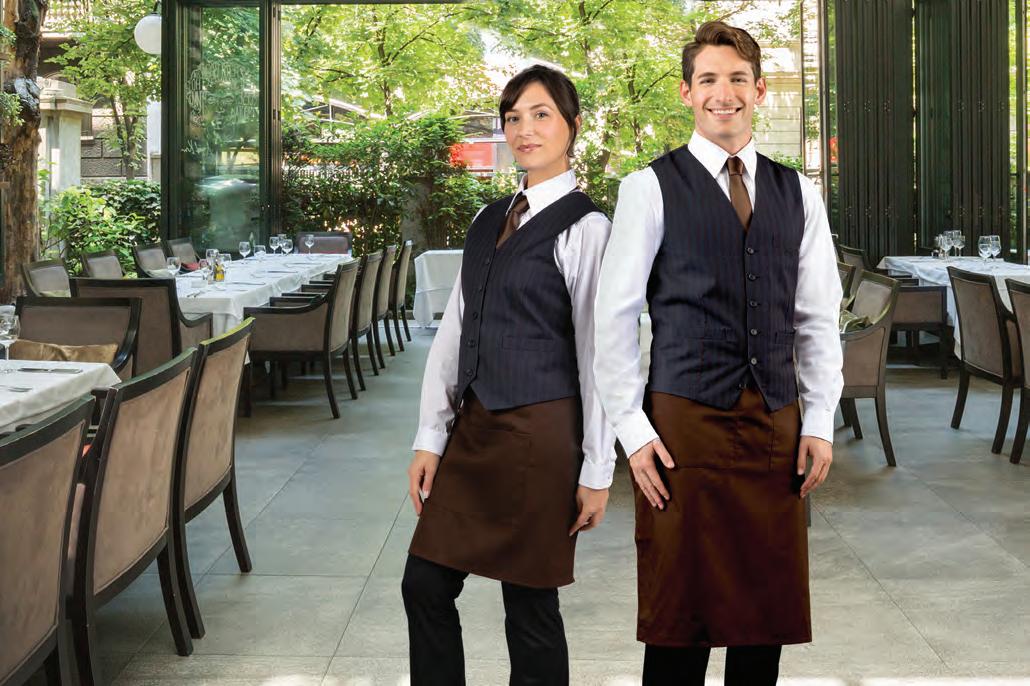

Nestled along the Atlantic coastline of Palm Coast, Florida, Hammock Beach Resort, a BoardRoom magazine Distinguished Golf Destination with ELITE status, is more than just a luxury destination—it’s a masterclass in what outstanding management looks like. For general managers and board members looking to elevate their own operations, Hammock Beach offers a compelling example of how vision, service and commitment to excellence can shape an unforgettable experience.
What sets Hammock Beach apart is immediately evident: its stunning oceanfront location. With the rhythmic waves of the Atlantic as a backdrop, the resort boasts two championship golf courses that are among the most admired in the Southeast. The Jack Nicklaus-designed Ocean Course, known for its six seaside holes, offers breathtaking vistas and a uniquely challenging round that guests call “unforgettable.” Complementing this is the Tom Watson-designed Conservatory Course, a traditional links-style layout that expands the resort’s appeal to a broader range of players.
Location alone doesn’t define Hammock Beach’s success. The resort’s reputation has been built through a relentless focus on service and personalization. From the moment a guest arrives, every touchpoint is orchestrated to deliver excellence—whether it’s a fine-dining experience at Delfinos, a relaxing treatment at the full-service spa or the sim-
“Being recognized as a Distinguished Golf Destination validates the hard work and dedication of our entire team. It’s a proud acknowledgment of our commitment to providing a world-class golf experience and exceptional hospitality.”
Brad Hauer, GM, Hammock Beach Resort”

ple pleasure of walking along a pristine stretch of private beach.
“Every visit feels like a personalized escape,” one guest remarked. “The staff goes above and beyond, and the atmosphere is second to none.”
Testimonials like this are not mere accolades—they are the outcome of a leadership style that blends data-driven decision making with an authentic, mission-focused culture. The resort’s general manager, Brad Hauer, a veteran with over 30 years of industry experience, underscores the importance of transparency, collaboration and empowerment. Weekly team meetings focus on guest feedback and continuous improvement, ensuring the resort stays aligned with evolving expectations.
Hauer also attributes success to maintaining strong ties with the advisory board of governors. “We share a unified vision and communicate openly,” he said. “This ensures the club component remains integral to our identity, even as we embrace innovation.”
Hammock Beach’s resilience has also been tested—and proven—through adversity. In the aftermath of Hurricane Matthew in 2016, the Ocean Course was left devastated. Yet the team responded with determination, restoring and even improving the course over a year of tireless work. It’s an accomplishment the general manager names as one of his proudest.
For club executives seeking lessons in operational excellence, staff retention or guest satisfaction, Hammock Beach is a shining example. “Hire for heart, not just skills,” Hauer advised. “Then, invest in those people—give them purpose, recognition and room to grow.”
At Hammock Beach Resort, every sunrise over the Atlantic reflects more than just natural beauty—it reflects a philosophy of leadership, service and vision that others in the industry would do well to emulate. BR
Golf Pros and Directors of Golf. Scan the QR code to see Hammock Beach Resort’s exclusive offer featured in BoardRoom’s Distinguished Golf Destinations Guidebook.


RONALD BANASZAK
Ronald Banaszak, CCM, CCE, BoardRoom’sDistinguished Golf Destinations president. He can be contacted at (415) 420-5183 or ron@boardroommag.com.
Nestled in the rolling landscape of Upstate New York, Turning Stone Resort Casino, a BoardRoom magazine Distinguished Golf Destination with EXCEPTIONAL status, offers more than just a memorable round of golf—it delivers a complete luxury experience fueled by innovation, cultural heritage and a relentless commitment to excellence. For private club general managers and board members seeking a blueprint for success, Turning Stone is a model of operational excellence and long-term vision, particularly in how it merges premier golf with world-class service and strategic leadership from the Oneida Indian Nation.
At the heart of Turning Stone’s reputation are its three championship-caliber golf courses: Atunyote, Kaluhyat and Shenendoah. Each offers a unique test of skill, thoughtfully designed to challenge and inspire players of every level. Atunyote, a Tom Fazio creation, is the crown jewel—a parkland course with wide fairways, dramatic water features and strategic bunkering that was recently enhanced to improve playability and reduce maintenance. Kaluhyat, by contrast, rewards precision and planning. Its dramatic elevation changes and six lakes present a mental and physical challenge that sets it apart even among elite courses. Shenendoah, designed by Rick Smith, carries the dual distinction of PGA TOUR conditions and Audubon International certification, reflecting the Oneida Indian Nation’s steadfast commitment to environmental stewardship.
Turning Stone’s golf offerings are consistently ranked among the best in the nation, having received accolades from Golf Digest, Golfweek and Golf Pass. But what elevates the experience beyond rankings is the service culture—every team member, from golf staff to hospitality professionals, is trained to anticipate needs and personalize the guest experience. This dedication is evident in guest testimonials that routinely praise the seamless integration of luxury, hospitality and authenticity.

That authenticity begins with the Oneida Indian Nation, whose leadership has transformed Turning Stone into a powerful driver of economic and social impact. Under the guidance of Nation Representative Ray Halbritter—a PGA Professional himself—Turning Stone has grown not only in amenities but also in purpose. The resort serves as both a special destination and a cultural touchstone, supporting programs in education, health and public safety for the Oneida people.
Innovation remains a constant theme. The recently renovated Sportsplex is a prime example, featuring 36 indoor bays equipped with Trackman technology, custom club fittings and a retail center offering top-tier brands. This forward-thinking approach ensures that the player experience evolves year after year, drawing repeat visits from both seasoned golfers and newcomers.
Turning Stone’s commitment to social responsibility is equally noteworthy. Its partnership with PGA HOPE exemplifies how golf can be a conduit for healing and camaraderie. Since 2017, the program has served over 300 veterans annually, aligning with the Oneida’s historic role as America’s First Allies.
With award-winning accommodations, fine dining, gaming and proximity to regional attractions like Oneida Lake and the Adirondacks, Turning Stone offers an all-encompassing destination. But what truly brings guests back is the people—the passionate team empowered by a culture of collaboration, professional growth and pride.
For club leaders and boards seeking inspiration, Turning Stone is a case study in holistic excellence—where golf is more than a game and service is more than a standard. It’s a place where vision, values and the guest experience converge to create something truly extraordinary. BR
Golf Pros and Directors of Golf. Scan the QR code to see Turning Stone Resort Casino’s exclusive offer featured in BoardRoom’s Distinguished Golf Destinations Guidebook.

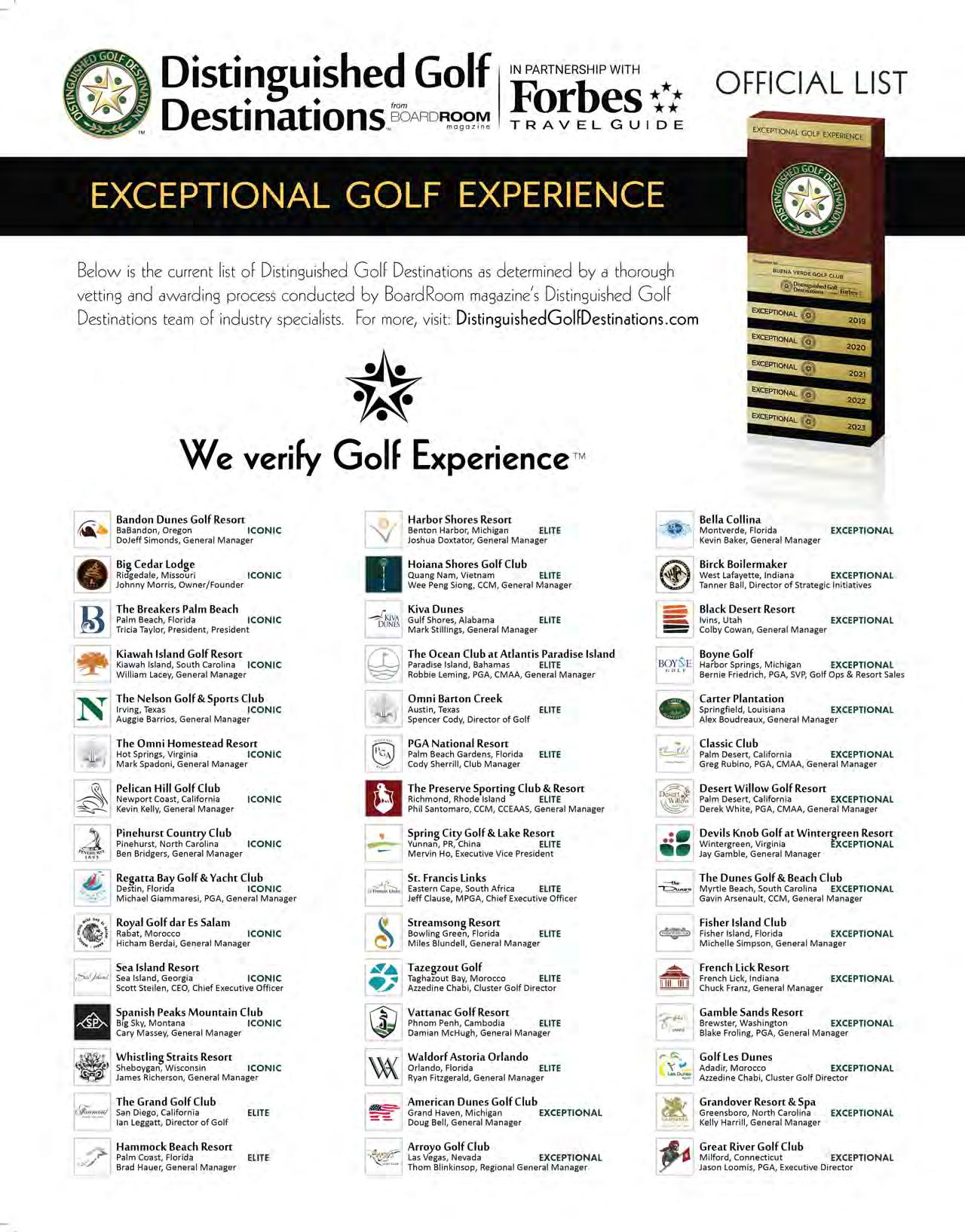



RONALD BANASZAK
Ronald Banaszak, CCM, CCE, BoardRoom’sDistinguished Golf Destinations president. He can be contacted at (415) 420-5183 or ron@boardroommag.com.
Developed by industry leaders, BoardRoom magazine, Distinguished Golf Destinations in partnership with Forbes Travel Guide, is the Hallmark of Excellence a golf resort, semiprivate, daily fee or public golf course can achieve. Distinguished Golf Destinations’ merit-based validation recognizes properties through a process where every aspect of a facility’s golf course and operation is evaluated against the most important metric: The Golf Experience.
As part of the process to earn the prestigious Distinguished Golf Destination designation a property must undergo a comprehensive property tour, including the front of the house and back of the house areas. During the tour, interviews occur with each manager to review their answers to the comprehensive questionnaire submitted beforehand.
If a property earns their designation, they are truly representing the best of the best. There are three levels of the designation:
• ICONIC: top 1% of properties worldwide
• ELITE: top 3% of properties worldwide
• EXCEPTIONAL: top 4% of properties worldwide
It is during these site visits that the tenured and credentialed site surveyor can see, firsthand, many Distinguished Ideas. As Distinguished Golf Destinations continues to add international properties and grow as a global company, we have the chance to see very creative and inspiring ideas. In this article we will explore three amazing properties, all of which I’ve toured and evaluated, that not only have outstanding golf courses, but truly distinguished service.
• Hoiana Shores Golf Club
Distinguished Golf Destination with ELITE status, Vietnam
• Spring City Golf Resort
Distinguished Golf Destination with ELITE status, China
• Vattanac
Distinguished Golf Destination with ELITE status, Cambodia
With new technology, management practices and philosophies, there are ideas that private clubs and golf resorts, semi private, daily fee and public courses can learn and benefit from. These ideas are exciting and thought-provoking with the intent to open the lines of dialog between management teams and each of the GMs of these properties. Let’s look at each Distinguished Golf Destination, in alphabetical order:
As dawn breaks over the South China Sea, pale gold sweeps across the windswept dunes of Hoiana Shores Golf Club, a BoardRoom magazine Distinguished Golf Destination with ELITE status, nestled along Vietnam’s central coast. More than a picturesque backdrop, this links-style masterpiece—born of collaboration between Robert Trent Jones II and Wimberly, Allison, Tong & Goo (WATG)—offers a transformative encounter.
A “Member for a Day” Philosophy
Managing world-class golf destinations throughout Asia for over three decades, Mr. Weng Peng Siong, is humbled to serve as the general manager. Mr. Siong states, “I’ve seen— and honored—the exclusive feel cultivated at Hoi An and beyond. Yet what distinguishes
Hoiana Shores is its deliberate embrace of every guest as an honorary member. From check-in to the final putt, the club unfolds a meticulously curated immersion.”
Empowerment lies in nuanced touches: bespoke caddie assignments, individualized attention, congenial intervals between tee times, and seamless navigation of each hole’s contour—each element mirroring the standard of a private club. This ethos saturates the experience, and it starts with the human element: caddies.
A remarkable 160-strong team of female caddies graces this course—each a local ambassador armed with regional knowledge, English fluency, and tireless professionalism. Trained by experts and mentored in traditional etiquette, they embody the club’s ideals at every interaction.
Caddies are assigned at check-in and rotate through 12-minute tee intervals. This cadence ensures that each golfer enjoys uninterrupted moments of strategy discussion and environmental commentary—be it wind readings or green slopes. They don’t just ferry your bag; they enrich the round with stories of sitio dunes, local ecology, and RTJ II’s vision. The result? Thoughtful, strategic play and emotional resonance, anchored by personal connection.
Hoiana Shores’ allure lies equally in its environmental commitment. It earned the prestigious GEO Certified Development status in December 2020—the first in Asia Pacific and among just half a dozen globally— after demonstrating sustainable design, construction, and operations.
The site had been a flat, denuded fish-farm. Over 23 hectares, the course team, led by golf superintendent Rob Weiks and RTJ II’s Bruce Charlton and Mike Gorman, sculpted dunes, restored native scrub, and planted more than 1,500 local trees—all using onsite sand and materials.

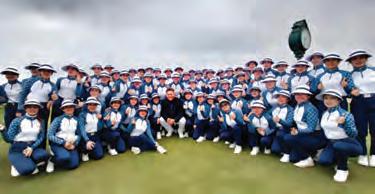

Rainwater harvesting lakes collect surface runoff via rain inspired irrigation ponds. Energy-efficient Rain Bird systems, tied to smart pump control and Cirrus software, slash copper use by 90 percent and precisely meter water through Zeon Zoysia fairways and humidity-resistant Tif Eagle greens.
Beyond stewardship, the club created a vocational training college in the neighboring commune. It offers accredited hospitality and turf maintenance programs staffed predominantly by Vietnamese women, many becoming caddies and course stewards— securing 350-plus permanent roles.
Elevating the Private Club Standard Managers at private clubs and resort complexes will find in Hoiana Shores:
1. A refined service architecture: structured interactions, tight tee intervals, experiential caddying.
2. A sustainability framework: GEO certified standards informing turf, water, energy, ecological, and community design.
3. A holistic strategy: from membership psychology to infrastructure and corporate social responsibility, creating a layered asset, not simply a golf course. The reward? A property celebrated globally—ranked #1 new course in Vietnam by Golf Digest (2020), Asia’s first GEO-certified course, and now placed #16 in “Asia Top 100.” This recognition arrives with surprising value: green fees more accessible than other top 100 peers.
GOLFING EXCELLENCE
Perched on the tranquil shores of Yangzong Lake in Kunming—China’s famed “Spring City,” Spring City Golf & Lake Resort, a BoardRoom magazine Distinguished Golf Destination with ELITE status is more than a golf destination. Since its inception in 1998, this integrated sanctuary has evolved into a blueprint for holistic health, sustainable stewardship, and world-class golf.
After a round on championship-level bent grass greens, guests can soothe sore muscles with targeted spa therapies. The Heng SPA offers signature deep tissue treatments tailored to golfers, alongside traditional Chinese recovery modalities like cupping and moxibustion.
Programs in mindfulness, meditation, and nature immersion—through guided lake front strolls and forest hikes—help guests recalibrate and reduce cortisol levels. Yoga sessions amid lakeside breezes further anchor emotional harmony.
its organic farm. These interactions forge connection and emulate camaraderie.
The Mountain Course (Golf Digest Top 100, #34), designed by Jack Nicklaus, stretches 7,453 yards across undulating terrain. Visitors confront elevated tee shots, sidehill lies, and strategically placed bunkers.
The Lake Course (Golf Digest #5 in China), created by Robert Trent Jones Jr., weaves across Yangzong Lake’s edges. Its hallmark features include steep elevation changes, narrow fairways, tiered greens, and prevailing winds—a test of precision players worldwide celebrate.
Nestled within the resort sits an expansive organic agricultural zone. The Spring City Organic Farm spans roughly 1.5 mi², planting seasonal produce, aromatic herbs, and indigenous flowers using sustainable soil management and irrigation practices. They also care for chickens and ducks at the farm, utilized for fresh eggs.
Guests participate in “Fun Farm” workshops—harvesting, planting, hands-on learning with certifications (children included)—reinforcing farm-to-table principles and ecological literacy. This farm feeds the resort’s kitchens, promotes biodiversity, supports pollinators, and helps manage water runoff—all woven into the guest journey, from course to cuisine.
Spring City’s credentials are robust and verifiable:
• Since 2010, Audubon International Certified Classic Sanctuary, one of the first to earn this certification
• Since 2023, GSTC Sustainable Hotel Certification (Bureau Veritas), first hotel in China to accomplish this criteria
• 2022 Voyage New Travel Sustainability Award
The resort also holds ISO 14001 and BCA Green Mark certifications, reflecting advanced environmental management systems and robust green building practices.
• Integrate wellness holistically across physical, mental, social domains.
Wellness isn’t complete without community. The resort runs outdoor team events such as Nordic camping, Tough Mudder trails, and chef-led farm to table meals at ➤
• Embed organic farming not as an add-on but a substantial core brand pillar.


“We are helping our clients improve their human performance through our comprehensive longevity plan allowing them to play their favorite sports for as long as possible.”
Mr. Mervin Ho, CEO

• Pursue internationally recognized sustainability certifications.
• Invest in spa and fitness amenities structured around golfers.
When played, explored, farmed, and felt, Spring City becomes more than a round—it becomes a restorative journey.
Spring City Golf & Lake Resort reveals a compelling narrative: one where anti aging, wellness, architectural excellence, and sustainability converge in purposeful harmony. It serves both elite golfers and lifelong wellness seekers—delivering mindful play, organic nourishment, environmental leadership, and more.
For private club and golf resort executives, Spring City is not just aspiration—it’s a working case study: supporting longevity through spiritual rejuvenation, healthy food, ecological responsibility, and award-winning infrastructure.
This is the evolution of luxury—where vitality and value coalesce. Whether you’re seeking to elevate your property’s health offering, secure green credentials, or redefine guest experience, Spring City offers both inspiration and proof.
In the heart of Southeast Asia, just 35 minutes from Phnom Penh’s vibrant city center, lies a world-class sanctuary where cultural grandeur meets championship-level golf: Vattanac Golf Resort, a BoardRoom magazine Distinguished Golf Destination with ELITE status. Managed by global hospitality leader Troon® and designed by six-time Major Champion Sir Nick Faldo, the 36-hole luxury golf destination sets a compelling benchmark for excellence—one that seamlessly fuses prestige, precision, and Cambodian heritage into every guest experience.
Vattanac Golf Resort is not just Cambodia’s best—it is fast becoming one of Asia’s most sophisticated luxury golf offerings.
At the heart of Vattanac’s excellence are its East and West Courses, distinct in both challenge and visual identity:
• The East Course, crowned “Cambodia’s Best Golf Course” in both 2021 and 2024, is strategic and visually captivating. Dramatic water hazards, undulating terrain, and six sets of tees create a layout that welcomes both single-digit players and resort guests alike.
• The West Course, awarded Cambodia’s Best Course in 2022 and 2023, offers a more exacting test of golf. Tighter fairways, stronger contouring, and finely-tuned Paspalum greens reward accuracy and finesse. Where the East may impress with breadth, the West delivers intrigue in nuance. Both layouts are framed by sculpted landscapes that combine lush aesthetics with heritage storytelling—echoing Faldo’s philosophy that a course must both challenge and inspire.
What elevates Vattanac from excellent to elite is not only the design—but the experience. The resort upholds a five-star service ethos:
• Concierge-Level Arrival: From the moment guests arrive, personalized service begins. Valet teams greet players by name, caddies are preassigned based on player profiles, and tee times are spaced to ensure intimacy and unhurried play.
• Caddie Excellence: Trained to international standards, Vattanac’s caddies offer more than club selection—they serve as course guides, storytellers, and ambassadors of Cambodian warmth. Their knowledge of the land and culture, combined with technical acumen, deepens the playing experience.
• Exclusive Lounges and Dining: Premium VVIP and VIP lounges, complete with private TrackMan simulators and curated Cambodian cuisine, offer executive-level comfort between rounds.
• Fully Integrated Academy: The Vattanac Golf Academy offers a full
suite of training technologies: TrackMan, Eagle Try analysis, custom fitting, and PGA instruction—ideal for private coaching retreats and member skill development.
With the current trend of players wanting faster golf and golf on demand, creating a nighttime experience is important to the lifestyles of many. Luxury doesn’t sleep—and neither does golf at Vattanac. The Dragon Turn, a floodlit 9-hole layout, is centered around a serpent-shaped lake and was voted “World’s Best 9-Hole Golf Course” in 2021. This is not a novelty track—it’s a premium design that maintains Faldo’s strategic elegance under lights, ideal for twilight play, corporate events, or après-dusk exclusivity.
Sustainability as Signature, Not Slogan
Behind Vattanac’s philosophy is an authentic, forward-thinking sustainability program that rivals any in Asia:
• Biodiversity in Action: Bird boxes, butterfly habitats, and native plant regeneration are strategically integrated throughout the course. Guests may pause at teahouses to witness hornbills and butterflies, reconnecting with nature while indulging in refreshment.
• Plastic-Free Commitment: All staff have been issued reusable tumblers, eliminating single-use plastic bottles. The initiative exemplifies how luxury operations can lead in environmental responsibility.
• Water Management: The resort’s extensive water features aren’t just design elements—they’re also functional systems engineered for water retention, reuse, and sustainability across dry and wet seasons.
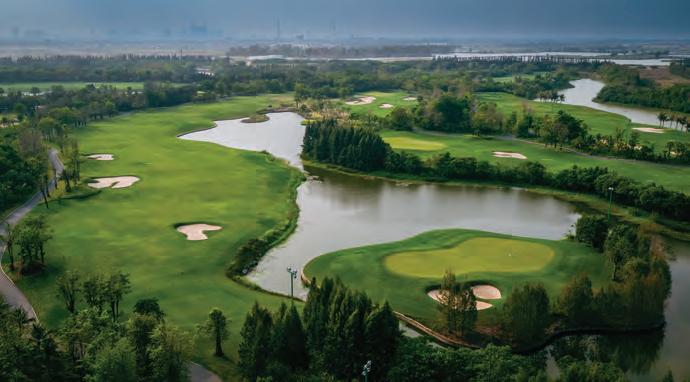

Sustainability is no longer optional, Vattanac makes it visible, measurable, and meaningful.
Cultural Integration, Elevated Experience
Vattanac isn’t just situated in Cambodia—it is infused with it. Golfers don’t simply play near Angkor-inspired temples—they play through them. The presence of Khmer architecture isn’t ornamental—it’s experiential, and it lends every round a depth and reverence rarely seen outside the world’s greatest heritage courses.
Adding to this, both the East and West Courses feature spectacular settings with scale models of famous Khmer historical architectural sites like UNESCO Heritage Site Angkor Wat, Preah Vihear, Terrace of the Elephants, and Bayon. This blend of world-class golf with rich cultural immersion makes for a genuinely impressive and unforgettable experience.
Vattanac Golf Resort presents an aspirational case study for private club leaders globally:
1. Marry Architecture with Heritage: Incorporating cultural elements into course design enhances sense of place and emotional connection.
2. Service Beyond Expectation: Use hospitality touchpoints to deliver clublike exclusivity, even in daily-fee or resort environments.
3. Elevate Night Golf: Dragon Turn proves that premium, after-dark golf can expand tee-time inventory and guest engagement.
4. Live Your Sustainability Ethos: Build environmental efforts into every layer— from agronomy to amenities.
5. Create Cultural Legacy: Thoughtful integration of national identity turns a resort into a destination of pride.
Vattanac Golf Resort is not merely Cambodia’s first and only distinguished golf destination—it is a beacon of what luxury golf in Asia can and should be. With its championship pedigree, visionary design, sustainability leadership, and white-glove service, Vattanac sets a gold standard in every category that matters.
The general managers of each property showcased in this article are available to give additional insight or answer questions:
Mr. Weng Peng Soing, GM, Hoiana Shores Golf Club wee.peng@hoiana.com
Mr. Mervin Ho, CEO, Spring City Golf Resort mervin.ho@springcityresort.com
Mr. Damien McHugh, GM, Vattanac damian.mchugh@vattanacgolfresort.com

Dave White is editor emeritus. He can be reached at dave@boardroommag.com.
Serving others in a private club isn’t just a function of the job; it’s the heart of who we are and what we do. For me, it means putting our members first, always. It’s about being fully present, anticipating needs before they’re ever voiced, and leading with intention.
And that’s how Jenice Jacinto, the clubhouse manager at the Visalia Country Club, describes what it means to be on the frontlines with her staff ‘serving’ the club’s members.
“In this environment, service isn’t conditional; it’s a daily commitment to excellence, especially when things get tough. Our members deserve nothing less than the best hospitality experience, and that’s the standard I uphold for myself and inspire in my team every single day.
Jacinto reiterated her points in a recent note posted on LinkedIn, sent to her staff members and other interested parties.
“I’ve been quite amazed by the interest and comments I’ve received from people. Many in the industry can relate to my comments,” she said.
“At a private club, there is no such thing as ‘just the basics.’ We are in the business of creating moments that are memorable, meaningful, and personal. Whether it’s remembering a member’s lunch order or making sure their favorite seat is ready before they arrive, the magic is in the details.
“I’ve worked hard to build a culture where going the extra mile isn’t rare; it’s expected. Our team understands that every interaction is a chance to make someone’s day. That shared mindset is what truly elevates our service,” she added.
Why does Jacinto’s country club staff love ‘serving others?’
“Because they see the difference it makes. Whether it’s a heartfelt thank you, a smile of relief, or the joy on a member’s face when we pull off something extraordinary. Those are the moments that remind us why we do what we do. I’m fortunate to lead a team that isn’t just talented, but they’re genuinely passionate about people. Through challenges and change, they’ve remained grounded in our mission: to create a space where members feel valued, cared for, and right at home,” Jacinto explained.
How do private club employees balance serving individual member preferences while maintaining the club’s overall standards and traditions?
“It’s a balancing act, and one I embrace with intention. Honoring our club’s traditions is important. It’s part of our identity. But we also recognize that our members’ expectations are evolving. The key is adaptability, with purpose.
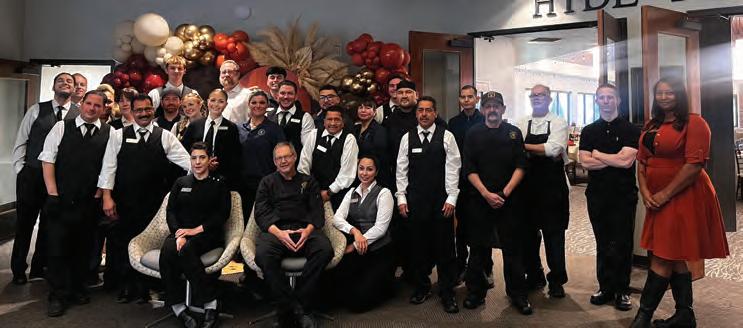
“Sometimes that means making tough decisions to move the club forward, but always through the lens of delivering what’s best for our members. Great hospitality lives at the intersection of consistency and personalization. We can celebrate our history while also shaping a future that feels fresh, relevant and meaningful,” she added.
What does it mean to go the extra mile for a member or guest?
“Recently, we hosted a celebration of life for a former member who had relocated a few years back to be closer to family. The event had been in the works since April, with most of the planning done remotely. Once I heard his story and learned about the impact he had made on our community, I knew this needed to be more than just another event.
Two days before, I met his wife in person for the first time. I gently asked if there was anything… that might make the day feel more personal for her husband. I promised we’d do our best to make it happen.
We arranged custom flowers, designed and printed the memorial program and made sure every detail honored his legacy. During the event, I noticed two flags: one beautifully displayed and the other still in its plastic wrapping. I realized immediately that the second flag was meant for the family. When I asked if they had a display case for it, they said ‘no.’
“I quickly ordered a triangular glass flag case and had it delivered within 30 minutes, just in time for a proper military presentation. It was a small gesture, but one that truly mattered. Going the extra mile isn’t always about doing more, it’s about recognizing the moments that matter most and being ready to rise to them with heart and grace,” Jacinto related.
“There’s a deep pride our team takes in knowing that what we do each day directly contributes to the club’s legacy. We’re not just filling shifts or checking boxes, we’re building something that will outlast us. We don’t aim to be the best just for the title; we do it to set the bar and lead by example. When someone leaves our club thinking, “Now that’s what great service feels like,” we know we’ve made a lasting impact.
For club staff, balancing their work and personal lives is always a challenge.
“But maintaining a healthy work-life balance isn’t just encouraged, it’s part of our culture. Our team works hard, but we also recognize that personal well-being fuels professional excellence.
“When our staff feels supported, rested and seen, they show up as their best selves and our members feel that difference. It’s not just about hours and schedules, it’s about creating an environment of respect, where everyone knows they matter and where mutual support leads to shared success.
“At the end of the day, we’re not just here to serve, we’re here to set a standard. We take pride in being more than just a private club. We’re a symbol of excellence in the Central Valley and beyond. That reputation fuels everything we do.
“It’s a responsibility we carry with honor, because when you’re part of a club like this, when you serve with passion, when you value every member, and when you honor every tradition, you become part of something much bigger than a team.
“You become part of a legacy. And that’s something I never take for granted,” Jacinto concluded. BR
How do private club staff members go beyond basic service to create personalized, memorable experiences for members? Here are some suggestions from Jenice Jacinto, clubhouse manager of Visalia Country Club.
• Learning names and preferences: Greet members by name and remember their favorite drink, table, or activity.
• Anticipatory service: Understand habits and anticipate needs, like setting out a member’s favorite wine or snack before they ask.
• Personal celebrations: Recognize birthdays, anniversaries, or milestones with a special note, treat, or gesture.
• Tailored recommendations: Suggest activities, menu specials, or events based on a member’s interests.
• Discreet problem-solving: Address issues quickly and quietly, making sure members feel valued and cared for.
• Going the extra mile: Assist with special requests or help coordinate arrangements beyond the club, making members’ lives more convenient.
• Consistent, genuine connections: Build trust through warm, sincere interactions that evolve into long-term relationships. These efforts transform routine service into a one-of-a-kind experience for members.
A Short Training Piece for Staff
As staff in a private club, you’re more than servers or hosts—you’re ambassadors of belonging. Our members notice the little things you do every day. Learn their names. Remember their favorite drinks. Ask about their families. Anticipate their needs before they ask. Each interaction is a chance to make a member feel valued and at home. It can be as simple as bringing their favorite snack when they arrive or ensuring their special evening includes a personalized touch. By going beyond basic service, you help create moments that turn a routine visit into a cherished memory. Together, we build a culture of belonging—one member, one interaction at a time. BR







By Chryssoula Filippakopoulos
Now in its 17th year, BoardRoom magazine recognizes the world’s top private club presidents, captains and chairs as Private Club Presidents of the Year for their exceptional work, deep industry understanding and clear grasp of board responsibilities. In this continuing series, BoardRoom introduces seven of its top 20 presidents for 2024. The Distinguished Club President of the Year was featured in the January/February 2025 issue.
Private club board presidents play a vital role in their clubs’ professional operations. They volunteer their time, working diligently with boards of directors and general managers to ensure decisions are well-informed and fact-driven rather than emotional. This recognition by BoardRoom magazine continues to attract nominations from clubs worldwide.
These outstanding presidents exemplify strong leadership, accountability and effective board management, demonstrating respect for their clubs’ overall governance. They understand the importance of efficiently collaborating with volunteer board members and appreciate the dedication required by everyone involved. Key elements of successful boards include commitment, competence, diversity, collective decision-making, transparency, effective communication with management and membership, fiscal responsibility and strategic planning aligned with the club’s mission, vision and policy direction.
Successful board presidents leverage board expertise, institutional knowledge and responsible resource stewardship. They also provide new board members and future presidents the information and guidance needed to perform effectively.
Congratulations to these outstanding private club board presidents.
Nominations are now open for the 2025 awards. All nominations must be based solely on the president’s actions, leadership and contributions made during the 2025 calendar year.
Finalists will be selected by a panel of industry experts and sponsors who understand the unique structure, responsibilities and governance of private club boards.
All results will be audited by a third-party accounting firm to ensure integrity and transparency.
A special section in BoardRoom will be dedicated to announcing the 2025 Top Private Club Presidents of the Year
Submit your nomination today and help us recognize those leading with purpose, passion, and vision.
For more information, contact John Fornaro at (949) 376-8889 ext. 1 or johnf@apcd.com.
Scan the QR code to apply.

Private Club Presidents of the Year Major Sponsors

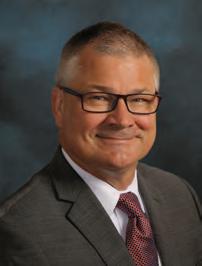
“Cynthia Gilchrest is an exceptional club president, focused on both the short- and long-term health, growth and financial stability of the club.”
So says Peter Cizdziel, general manager and chief operating officer at Venice Golf and Country Club.
“Her collaborative leadership with the board, committees and senior management has ensured strong governance and sustainability,” Cizdziel noted.
“It’s been a true pleasure working with her in my first year as GM/COO.”
With Gilchrest at the helm, Venice Golf and Country Club has advanced a new era of transparent and strategic governance, with board training,


Ask Robert Warren how he got buy-in from the Mission Viejo Country Club board, committees and membership to get two significant, long overdue projects to the finish line, and he will say, “It’s about working within a framework of mutual trust and respect.”
Warren, who served as club president in 2019-2020 and 2023-2024, clearly values and seeks out different viewpoints.
“He does not try to sway others based on his own bias or personal agenda,” said Steve Vlahos, general

goal setting and committee orientation further strengthening governance. Gilchrest, who is in her third year as president of Venice Golf and Country Club, led the development of the updated mission, vision and core values, now central to every board decision.
“The mission, vision and core values play an integral role in every decision we make as a board,” she explained.
Under Gilchrest’s leadership, the member experience at Venice Golf and Country Club has improved through greater inclusion, communication and engagement. She champions stronger member engagement through monthly coffees with the general manager, open board meetings and all-member town halls.
As a result, members feel more informed and valued. This is reflected in annual survey results. Member participation in events, activities and committees is at an alltime high, supported by the board’s conscious effort to involve a diverse cross-section of the membership in all areas.
At Venice Golf and Country Club, the board sets policy and strategic direction; the general manager manages operations, ensuring effective and non-intrusive governance.
The club is aligning a new campus plan with its long-range plan to evaluate amenity use and future needs. Gilchrest plays a key role as a member of both the campus planning and long-range planning committees, engaging members throughout the planning process.
In addition to serving on the board of Venice Golf and Country Club, Gilchrest has served on several national and nonprofit boards. As for her professional life, Gilchrest spent her career in education. She was a school administrator and special education educator for the State of Connecticut. BR

manager at Mission Viejo Country Club. “Rob is very thoughtful in his approach and very patient in his decision making. He always puts the interests of the club first and far ahead of anyone’s personal agendas. Once he has listened to everyone’s opinions, he then works to reach a common goal with all board members.

“That was evident in the remodeling of the pool and the main dining room and bar in his second term, collectively building upon the work of prior presidents and board members and working with the house and finance committees and the membership to see the completion of these projects.”
The club’s reserve funds paid for the remodeling projects, which cost over $1 million and have enhanced the overall club experience.
Warren explained that at Mission Viejo Country Club, the board and management team communicate clearly and effectively. The club integrates the strengths of the board and the management team within and upon that prized framework of mutual trust and respect.
The board trusts the management team to implement strategies and work toward the board’s goals; management leverages the insights and leadership experiences of individual board members and member subcommittees, which, in turn, facilitates more strategic dialogue and more effective management practices.
Warren, who wrestled with and managed through pandemic-related issues in his first term as club president, has a master’s degree in business administration. He is part owner and principal operator of Investors’ Property Services, a national property management firm based in Southern California. BR

BONNIE J. KNUTSON
Bonnie J. Knutson, PhD, is a people watcher. A professor in The School of Hospitality Business, Broad College of Business, Michigan State University, Dr. Knutson is a member of the Country Club of Lansing and the Michigan Athletic Club. She can be reached via email: drbonnie@msu.edu
The next generation of club leaders will transform the club industry. There is no doubt about it. As stewards of an industry rooted in tradition, club leaders (managers and board members) have long walked the line between honoring legacy and adapting to change. But today, that balancing act is more complex. Evolving member expectations, generational transitions, digital disruption and shifting workplace dynamics are redefining what effective club leadership will look like in the future.
Tomorrow’s club leaders will need a skill set and mindset distinct from those of the past. It will no longer be enough to just run a great dining program or maintain pristine fairways or even transform rarely used tennis facilities into pickleball courts. It will be about leaders who are equipped to navigate a new era of club operations—i.e., leaders who are agile, ethical, tech-savvy and able to lead in fundamentally different ways. Five traits will define these leaders:
The art of “managing by gut” is giving way to managing by data. Clubs that embrace this shift will be better positioned for longterm success. Tomorrow’s club managers will leverage real-time analysis and artificial intelligence to better understand member behavior, forecast trends and optimize operations.
Whether predicting dining preferences, customizing memorable event experiences or managing staffing models based on usage patterns, future-ready leaders will use data as a strategic asset. For boards, this means supporting investments in systems that enable data-driven decision-making and hiring managers who know how to interpret the numbers. “Let machines do analysis and humans make decisions” is becoming a common principle in modern AI and technology.
While clubs remain inherently in-person spaces, the operational landscape is slowly and surely shifting. Remote administrative roles, hybrid work models, opportunities for multi-club virtual experiences and the digital expectations of members are becoming standard. The next generation of managers will be equally comfortable leading remote groups and enhancing digital member experiences.
This requires, of course, managers mastering cloud-based tools, implementing mobile-first platforms for reservations and communications, and fostering a strong club culture that transcends the physical club. Their ability to connect with staff and members—virtually and in person—will be critical to driving engagement and loyalty.
Environmental responsibility and social consciousness are no longer optional; they are expected. Tomorrow’s club managers will
lead with a clear commitment to sustainability, ethics and community impact. From energy-efficient facilities and zero-waste initiatives to equitable employment strategies and practices, the club’s values must be reflected in its operations.
Members—especially younger generations—are increasingly choosing clubs that align with their personal beliefs. Boards must therefore empower managers to integrate purpose into practice and support them in becoming ethical leaders of sustainable clubs.
If the past few years have taught us anything, it is that stability is fleeting. Clubs are operating in what the business world calls a VUCA environment—volatile, uncertain, complex and ambiguous. Tomorrow’s club managers must be comfortable navigating ambiguity, adjusting strategies on the fly and making decisions with incomplete information.
Whether responding to economic shifts, unexpected labor challenges or rapidly evolving member needs, future club leaders will need agility, resilience and a forward-thinking mindset. Boards will have to prioritize leadership development that emphasizes adaptability, scenario planning and strategic foresight.
Perhaps more than anything, the club manager of tomorrow will not simply be a hospitality expert. The club manager will also be part technologist, part strategist, part community builder and always a student of the industry.
With change accelerating, the best managers will commit to continuous learning, constantly acquiring new skills across operations, finance, marketing, HR and beyond. For boards, this means recruiting not just for experience but also for intellectual curiosity, learning agility and cross-functional leadership potential. It also means supporting ongoing professional development through certifications and peer networks like CMAA and GGA Partners.
And, of course, board leadership plays a pivotal role in shaping the future of club success. As governance bodies, boards must ask and answer this question: Are we cultivating the kind of leadership that tomorrow’s club will require?
The future of any club depends not only on physical amenities or programming innovations but on the people entrusted to lead. It is time to look beyond the résumé and into the future to seek out and support managers who are not only capable stewards of today’s operations but visionary architects of tomorrow’s club.
Perhaps the contemporary futurist Gerd Leonhard says it best: What is human will be valued: creativity, imagination, intuition, emotion and ethics. Technology is the how. Humanity is the why. Your bottom line will thank you. BR
“We believe this master plan will improve the member experience and drive deeper engagement by elevating the entire Pinehurst membership experience by improving aesthetics and playability on the courses.”
And that’s the belief of Christina Wynn, director of communications for Denver, Colorado’s Pinehurst Country Club.
“With a new pool and restored golf course, we can ensure these important amenities have longevity and the quality aesthetics our members and community are looking for,” Wynn added. The $21.5 million master plan includes golf course repairs, new pool facilities, tennis lighting and upgraded dining options. It’s scheduled for completion by spring 2030.
To ensure unanimous support from the board of directors, Pinehurst’s leadership group adopted an educational approach that highlighted the long-term benefits of the plan. Key strategies included data-driven insights, collaborative focus groups, stakeholder involvement, and regular updates to keep board members informed.
“By integrating these strategies, Pinehurst’s leadership effectively communicated the master capital plan’s value, securing the consensus needed from the board to present it to the membership for a vote,” Wynn said.
The new pool will be more sanitary and hygienic, thanks to its new filters. All aspects of the pool will meet ADA standards. Installing lights on our outdoor courts will drive more engagement by allowing the club to have more playable hours throughout the seasons. Pool construction will begin after the club’s 2026 season and scheduled to be completed by Memorial Day 2027.
The golf course repair will occur nine holes at a time. Since the club has 27 holes, there will always be 18 holes available for play! During June and July of 2027, 2028, and 2029, all 27 holes will be open for play to enhance our members’ experience during the busiest months of the year.
“Pinehurst’s amenities and members drive our culture. With improved amenities, we see members enjoying the club more fully. Our pool brings families and friends together during summer, and with our pool being original from 1968, we were at risk of losing it because of its age,” Wynn stated.
“The club is our members’ home away from home. By keeping our amenities up to date, we maintain their long-loved club as a welcoming and beautiful place to enjoy with friends and family. The master capital plan ties into our mission, vision and value statements. These statements were voted on and approved by our membership and we use them as the foundation of our decisions. Our mission is to ensure ‘families of all ages and backgrounds feel at home and enjoy exceptional service and facilities.’
Given the significant investment, the club has worked to maintain financial transparency and accountability, ensuring members remain confident in the board’s stewardship. This has included:
• Open board meetings
• Open committee meetings
• All minutes are posted on the member website
• Financial packet posted on the member website
• CEO/GM open door policy
The capital planning management committee, composed of industry experts, ensures that quotes and bids are assessed in the best financial interests of our club and its members. The club has also fostered member engagement throughout the process by communicating and demonstrating the value of these improvements to members, ensuring transparency and alignment with their expectations, as well as fostering collaborative governance with the board and the incoming board president.


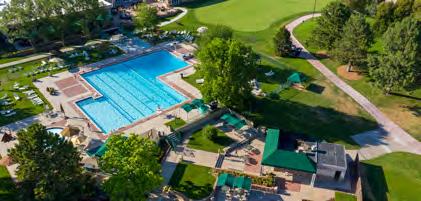
This process included:
• All member meetings/open forum. “Clubhouse Conversations”
> VP presented prices, timelines, an indepth explanation of each project with everyone involved and all questions answered.
> Meetings were well attended online and in person
> Sent Zoom recordings, slide deck, updated FAQs
• Collaborative
> Cross-committee collaboration involved the
• Capital project management committee, finance committee, long-range planning committee, governance committee, green committee and the board of directors.
Wynn added that, “Our board and management team hosted multiple member meetings, called Clubhouse Conversations. These open forums have been a great way to ensure transparency for a few years, but we recently tailored them to educate members on the master plan.”
“Our vision states that we are ‘to provide a safe and enjoyable country club experience.’ By investing in our future as a community, we can provide exceptional service and facilities for years to come.” Wynn concluded. BR

Private club governance is not as threatening as the multiheaded Hydra, a serpentine monster in Greek and Roman mythology; however, it can be complicated by today’s challenges to board effectiveness and trustworthiness. While the Hydra was thought to guard the entrance to the underworld by the ancients, club governance is a sometimes frightening three-headed beast in itself.
Standards of best practice have become widely known and referenced when discussing how to optimize performance in the boardroom. Three key practices that head this list for sound governance are shown below:
Boards speak with one voice and in writing. This principle has long been a foundational element of sound nonprofit governance. In today’s boardrooms with differing opinions and viewpoints, this principle is sorely tested by many board members who feel the need to explain board decisions outside of the boardroom.
Differences within the boardroom are beneficial when properly utilized. There should be differences of opinion when boards are working diligently and when board members express their personal views on a matter before the board. After suitable discussion and decision by the board, any given matter should be closed while not having after-action explanations outside the boardroom.
The appropriate answer to a fellow member questioning a board decision is, “You know that boardroom discussions are confidential, so what I can tell you is that this is the board’s decision, and I stand with the board.”
Boards use a consent agenda for committee reports. Board members are servant leaders giving their own time to serve fellow club members. All parties are obligated to use their time well and wisely. One of the best time-efficiency solutions for boards is to implement a consent agenda for committee reports. This method calls for committee reports to be submitted in writing in advance of the board meeting to enable board members to take adequate time to review,
from Global Perspectives | 16
independent and objective third-party communications expert should execute an analysis of the club’s communications practices and methods.
5. Action plan: Putting the strategy to work is the final step in the finished strategic plan. The strategic action plan establishes the sequence of activities supported by the timeline/deadline for action, who is responsible and the intended outcome.
Inclusiveness: Club members want to be involved in the strategic planning process and distrust a strategy that seems
research and question the report. At the time, in the agenda for committee reports, a board member may move to approve all reports as submitted. A vote of the board is taken to approve for the record.
If any board member has questions or concerns that need to be expressed, the specific committee report in question is removed from the consent agenda and discussed further by the board, which may take actions subsequently to approve the report, reject it or request additional information.
This approach saves the board considerable time for other deliberations and enables all board members to arrive at the meeting fully prepared.
Boards conduct an annual self-evaluation. Recognizing that boards are accountable to fellow members, boards and board members seek to do their best. A part of that commitment is to conduct an annual self-evaluation.
Evaluation questions often address board members’ fidelity to fiduciary duties, calling for them to attend the meeting well-prepared and informed of agenda matters, for example. Evaluations also enable board members to address fellow members’ devotion to confidentiality, congeniality and behaviors of mutual respect.
After several preliminary board evaluations, which can be conducted after each board meeting, most boards are prepared to share an annual self-evaluation with fellow members. This openness fosters trust and greater understanding among ordinary members of the club.
This is transparency in governance.
Following these three principles empowers boards for great governance success. Few boards are perfect, and all boards – no matter how effective they may be – are imperfect, so continuous improvement is a worthy goal. BR
to have been developed by a select few. Using members for qualitative analysis (focus groups), reporting member-sourced findings and keeping the planning process apparent for club members ensures that all members can be a part of the club’s strategy.
Three steps that include club members in the club strategy are:
1. Regular and consistent communications: The strategic planning committee should establish a cadence that fits and supports the club lifestyle. Reporting to and interacting with members verifies their engagement and guidance.


HENRY DELOZIER
Henry DeLozier is a partner at GGA Partners. He can be reached via email: henry.delozier@ggapartners.com
One of the primary steps in sound club governance is chartering a strategic planning committee (SPC). Most planning groups are effective when they begin with a sound charter that anticipates the club’s needs.
Most clubs have groups of members with corporate backgrounds who understand and have experience in strategic planning. The key to mobilizing and empowering the club’s strategic planners can be reduced to the following three attributes:
Understanding: The club’s strategic planners must have experience in creating—thinking and writing and not simply supervising—a strategic plan that can be agile, focused and time-guided.
Experienced strategic planners understand the big picture premise of thinking with mindfulness to the needs for successful strategic planning, which relies upon five characteristics of the top planners, who are:
1. Open to perspectives from multiple sources. Thorough research and consideration are essential to a dependable strategy.
2. Adept at incorporating both logic and emotion. Private clubs are emotional by nature and require this combination of right brain and left brain.
3. Comfortable thinking beyond today’s reality. Understanding time and how moods evolve makes for better plans.
4. Comfortable with being a little uncomfortable. Strategic planners often gather enough information and data that they can see and avoid potential threats to develop a sound strategy.
5. Question yesterday, today, tomorrow. Openmindedness and understanding are mission-critical attributes of effective planners.
2. Open strategy sessions: Conducting open meetings that enable members to participate in strategy-making can be an effective method of engagement when thoughtfully implemented. The keys to thoughtful implementation are to decide how members can contribute, how and when member input is to be offered and how the committee confirms that it “heard” member input.
3. Accountability to members: Consistent and regular reporting of strategic development and thinking demonstrates that the board’s strategic planning committee understands its responsibility to members. This act of servant leadership underscores the work being done for and with members.
Cooperation: Can the planners work effectively together? There is no room for the lone wolf who is unwilling to listen to other viewpoints or who wishes to soldier forward in the absence of research and data. Mutual respect, collaboration and timeliness build trust within the strategic planning committee. Clubs should consider this matter when choosing planners.
Servant leadership: Strategic planning committees populated by members known to have a personal agenda are rendered ineffective from the outset. Fellow members rely upon strategic leaders who can be objective, thorough and accurate while doing the work of the club for others. Faithfully working for others is at the heart of servant leadership.
Data-driven research requires three important attributes:
• Thoroughness in data-seeking: Ample data resources are available. Key for strategic planners is relying on proven and trustworthy sources that provide adequate data.
• Insistence on accuracy: Clubs today are awash in data. Some data is good and reliable, while some is not. The strategic planning committee must seek out and rely on research sources that have been proven to be trustworthy, mainstream data providers.
• Cross-referencing data: It is advisable to rely upon more than one point of reference. There is a generous supply of publicly available data, such as Claritas, John Burns Research and Consulting, the National Golf Foundation and the U.S. Census Bureau. There is no substitute for validating data by cross-referencing data points.
Effective strategic planning begins with a sound charter and clearly stated core values and purpose. Boards that charter an SPC do well to provide the tools and guidance to enable effective and purposeful planning. BR
Responsiveness: Clubs rely on servant leaders who are willing to be accountable to fellow members. Effective process planning for private club strategic plans integrates accountability into the process using redundant reporting results and findings while collecting additional member input. The best strategic plans have broad-based support within their clubs.
Running a multimillion-dollar business is challenging enough; one does well to plan strategy with a systematic approach for private club strategy-making. BR

Colin Cowie is Chairman & CEO for Colin Cowie Lifestyle and Chief Experiential Officer for Thrive Hospitality. Author of 11 books and contributor to the TodayShow, Cowie continually sets the standard for luxury experiences worldwide. He can be reached at distinguished@colincowie.com
Perfection at a Distinguished Club is not happenstance. It’s the quiet hum of harmony among staff, the choreography behind every detail and the smile that arrives before a member even asks. What makes it all feel so effortless? The invisible engine behind the scenes: a vibrant, intentional staff culture.
Culture is a feeling that you get—it’s emotional gas in the tank. It’s sensed in the air, in the energy of the team, in the seamless way everything just works. When employees feel valued, aligned with purpose and empowered to act, they don’t just fulfill roles—they exceed expectations and deliver magic.
LEADERSHIP SETS THE TONE
Culture isn’t a slogan on a breakroom poster. It’s modeled by leadership— consistently, visibly and authentically. I believe excellence is intentional. It doesn’t happen by chance. When managers embody the grace, elegance, attentiveness and respect they want members to receive, a lived standard

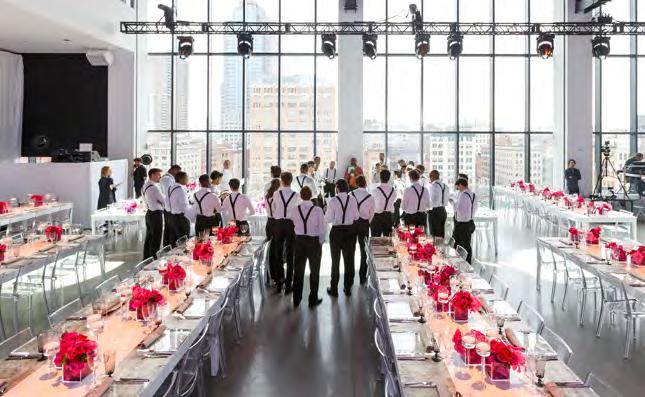
emerges—not one that’s imposed. A general manager who knows staff names, asks questions and shows up with care says, without words: You matter. That presence cascades into performance.
EMPOWERMENT
Empowered employees don’t just complete tasks—they own them and anticipate needs. It’s the difference between good service and an unforgettable experience. Think of the doorman who appears with an umbrella before the rain falls or the server who remembers the way a member likes her salad. These moments aren’t luck; they result from trust and education. It’s not service. It’s theater. And like any stellar production, success relies on internal harmony. Trust your cast. Rehearse the cues. Then let them shine.
RITUALS BUILD
Rules set expectations. Rituals create identity. Daily huddles, legacy storytelling during onboarding and moments of peer recognition are the cultural anchors that give staff rhythm and belonging. Your emotional connection to your team is just as important as your emotional connection with your members. When leaders nurture those internal bonds with intention, the ripple effect reaches every member interaction. What members feel reflects how staff feel. A gracious, seamless, joyful club environment isn’t built on scripts—it’s sustained by culture. Behind every polished glass or freshly fluffed towel is a team driven by meaning, bonded by trust and united by rituals that matter. Teamwork, mindfulness and communication with and among your team are the brothers and sisters of success. They turn routine into rhythm and effort into elegance.
So yes, invest in marble and menus—but also invest in mindset and meaning. Your company culture is the fuel for your business engine—and like any high-performance machine, it only runs at its best when the tank is full. Keep it fueled. Keep it flowing. That’s where the magic lives. BR

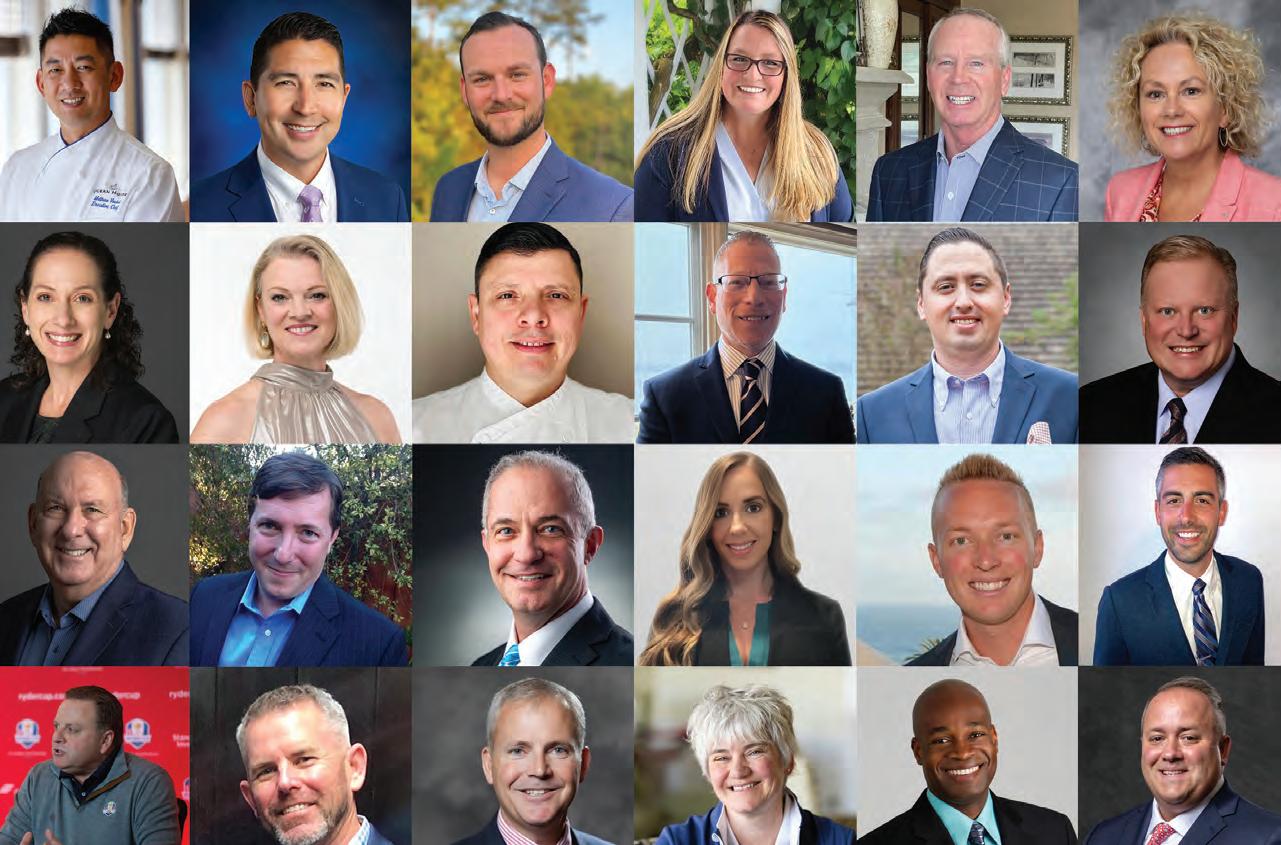
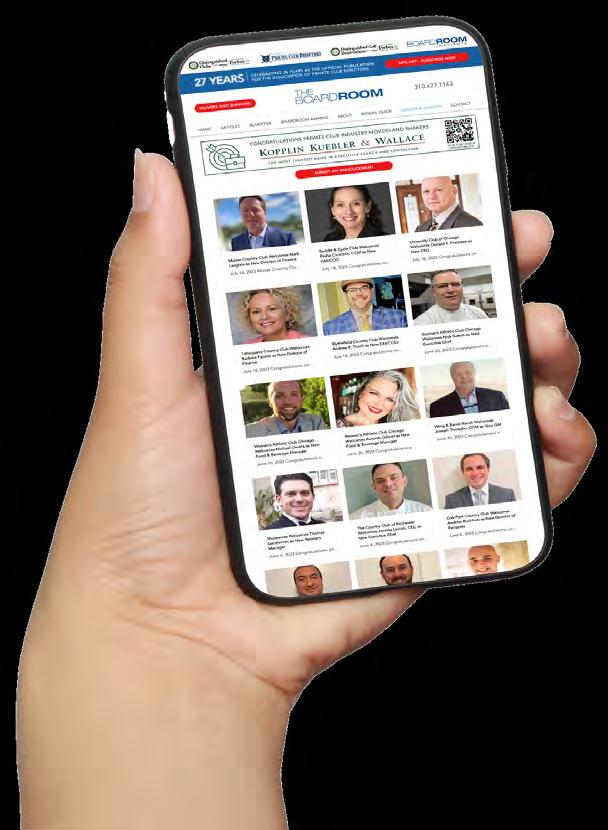

BOARDROOM magazine is promoting advancement in the club industry via its Movers and Shakers section on the website.
This section pays tribute to new placements and advancement for club executives and staff.
In addition to announcements on social media and on the website, these posts are shared through bi-weekly and monthly emails. Scan

to view or submit a placement.





Our clubs are renowned for their exclusive atmosphere, high standards and sense of community. The culture within our clubs is a vital aspect that attracts and retains both members and employees. As clubs maintain their capacity, extend waitlists and bring in fewer new members, the responsibility of preserving and enhancing this culture increasingly falls on employees.
One of my go-to sayings is that the membership professional is the keeper of the culture. Membership professionals are the first point of contact for potential members and play a crucial role in setting the tone for the club’s environment, including:
• Welcoming new members
• They are the ones to ensure that new members feel integrated and valued
• Maintaining standards
• They are the first line of defense in representing the club’s traditions and high standards
• Fostering community and relationship extension
• They are the first to encourage interactions and establish rapport among other members.
Fewer new members equate to fewer extensive interactions with the membership professional. This means that employees are now pivotal in maintaining the club’s culture. They (hopefully) bring fresh perspectives and energy, which can be harnessed to polish standards and focus on consistency.
KRIS
Kris Butterfield Cance is the director of people and culture at La Cumbre Country Club in Santa Barbara, CA. She can be reached at (805) 563-1622 or via email: kris@lacumbrecc.org
While human resource professionals play a vital role in our clubs, the role of a “culture ambassador” requires a deep, personal connection with our members and an intimate understanding of our club’s traditions and values. This guarantees that the essence of our culture is preserved and nurtured.
Looking at your club, who would be best suited to maintain the club culture? Would you consider blending the role of the membership professional into more of a culture ambassador? Post-COVID, we have seen and heard the creative, unique and catchy title changes across the industry. As the dynamics within private clubs evolve, the roles of culture and membership professionals are likely to blend, and responsibilities could look like this:
• Championing our club’s values
• We need someone to ensure that our traditions and legacy are upheld and celebrated.
• Member connection
• The club is the community, and relationship extension boosts satisfaction and retention through personalized interactions
• Consistency
• Someone needs to be responsible for making sure every part of the club’s operations aligns with our mission and values.
While human resource professionals play a vital role in our clubs, the role of a “culture ambassador” requires a deep, personal connection with our members and an intimate understanding of our club’s traditions and values. Looking at your club, who would be best suited to maintain the club culture? Would you consider blending the role of the membership professional into more of a culture ambassador?
The key areas where employees contribute include:
• Adherence to traditions
• Through orientations and team meetings, they learn, maintain and respect the club’s established legacy and norms
• Consistency in service
• By delivering a uniform experience that meets the club’s high standards, they maintain the traditional and expected cadence of service
• Innovation
• Typically, employees introduce some pretty instrumental ideas that the management team hasn’t thought of that align with the club’s values and avoid the “we’ve always done it this way” mentality.
The culture at our clubs is a delicate balance of tradition and innovation. By recognizing the important cultural contributions of both membership professionals and employees, clubs can continue to thrive and offer a consistent, high-quality experience to their members.
As these roles blend, the focus on cultural stewardship and membership engagement will become even more critical, ensuring that the club’s values are upheld and celebrated. When intention meets passion, culture doesn’t just survive, it thrives. It’s time to be intentional. BR
Passion Graham, CCM, is the CEO of Passionate Productions—a coachsultant and educator with nearly 30 years of experience in hospitality. She has held leadership roles at Charlotte Country Club, Desert Mountain and Governors Club. Passion teaches in BMI’s F&B and Club Management programs and serves as an adjunct instructor at Central Piedmont Community College. She now helps others lead with purpose, culture and service at the core. She can be reached at (910) 988-4080 or passionateproductionsllc@gmail.com

I once walked into a club that had cycled through three directors of catering in under two years. The general manager and I discussed whether it was the labor market and the club’s remote location. We ultimately agreed that the real issue was leadership.
It’s not that people don’t want to work—it’s that they don’t want to work for us. When I say “us,” I mean leadership cloaked in tradition, hierarchy and busyness. It’s archaic and unattractive, and it’s time to rethink our approach. The so-called “labor shortage” is often a convenient scapegoat for outdated leadership practices. Retention isn’t just about paying people more money, but paying more attention. They need to feel seen, supported and part of something that matters. Culture keeps people. Leadership grows them.
The narrative that “no one wants to work anymore” is false. What’s true is that the way we used to work is no longer ac-
The lesson? Get to know your team. Discover what lights them up—and empower them to bring it into your operation. It will look different at every club and for every person. But when done right, the return is exponential.
Teammates don’t quit jobs—they quit bosses and bad environments. Your culture is your competitive advantage, not just for retaining talent, but for attracting it. You’re not just interviewing them—they’re interviewing you. Culture is the unseen current that carries your team toward—or away from—excellence. It’s the heartbeat of your organization, shaped by the values you live by, the energy you bring and the standards you uphold when no one is watching. It’s not written on the wall. It’s felt in the hall.
At Passionate Productions, we believe culture isn’t an initiative—it’s a commitment. It determines how you show up, how you serve and how you grow. Culture must be cultivated, stew-
While human resource professionals play a vital role in our clubs, the role of a “culture ambassador” requires a deep, personal connection with our members and an intimate understanding of our club’s traditions and values. Looking at your club, who would be best suited to maintain the club culture? Would you consider blending the role of the membership professional into more of a culture ambassador?
ceptable. Gen Zers, Millennials and the post-pandemic workforce are prioritizing their mental health. They’re rejecting a culture that glorifies burnout, long hours and the selfless grind.
The boom in the gig economy proves this, even in our industry. Many clubs now rely on temp agencies, with teammates who fulfill full-time roles yet refuse to sign on permanently. Why? Flexibility, better pay control and time off. These trends reveal an opportunity, not a threat. It’s time to evolve—not just our hiring practices, but our leadership models.
At the 2023 World Conference, I was introduced to the term “employeepreneur,” coined by Dethra Giles. These individuals treat their careers like a business—they are self-motivated, innovative and productive. I once hired someone just like this. He hit the ground running, but over time, his energy faded.
After that conference, I approached him with an idea: What if we tapped into his passion for coffee? He and an assistant manager collaborated on a bespoke Sunday brunch barista experience. His spark returned—and so did our members’ enthusiasm. The shift that no one wanted suddenly became a highlight.
arded by leadership and reflected in every member experience. And a member is a member is a member—whether internal or external—and each interaction should reflect excellence.
Genuine care is the seed that, when sown and nurtured, yields the greatest harvest. The best leaders know how to earn their team’s discretionary effort, and that rarely comes from raises—it comes from a relationship. One simple moment of humanity can do more than a bonus: “Hey, you seemed off today. Let’s take a ride in the golf cart.”
The best clubs are intentional about culture and leadership. They lead with empathy, clarity, accountability and high standards—not just SOPs. Best principles are the foundation of best practices. They’re not hiring unicorns. They’re developing loyal, engaged people.
If we truly want to solve the labor crisis, we need to stop looking out and start looking within. Audit our culture. Examine our communication. Lead with care. The best place to start is with one brave question: “What is it like to work for me?” Then, really listen to the answer. BR

When I was 5 years old, I would sit and watch my mom set the table for dinner guests who were coming over. She would spend hours meticulously choosing chargers, flatware, napkins, florals, and candles with great care. It was evident she put her whole heart into this preparation. I adored the way it made people feel! Watching our guests enter our home and see the beautiful tablescape my mom had worked so hard to prepare, they instantly knew they were loved and thought of long before they arrived. I cherished that feeling. Even at such a young age, I knew I wanted to spend the rest of my life making people feel that way.
Fast forward to a role I had as Director of Food and Beverage, where I was interviewing hostesses. I had the fantastic opportunity to sit down with Cathy Kish. She presented her resume, which lacked traditional “hostess experience.” However, our 45-minute conversation was more than an interview—Cathy shared her heart with me. She spoke about her love for people, her positivity, her joy in taking care of others, and her infectious zest for life. She may not have had extensive experience, but she had the heart. I hired her on the spot.
LORI LEBARD
Lori LeBard, CCM, is the assistant general manager at the Atlantic Fields Club in Hobe Sound, FL. She can be reached at (714) 369-3543 or llebard@atlanticfieldsclub.com
required. On one occasion, when I suggested she didn’t need to stay so late, her response perfectly captured her devotion: “If the team’s here, so am I.” Her words exemplify the spirit of a true teammate. She makes our entire team feel valued and appreciated.
Individuals like Cathy and Gina are the exemplars of the hospitality heart—going above and beyond what is expected, seeking to enhance the collective spirit of those around them.
Their actions demonstrate that leadership in hospitality involves surpassing ordinary care. It’s about exceeding everyone’s expectations, and that can be both a challenge and the most rewarding aspect of our profession.
When considering candidates for a role, look beyond the resume and assess the heart of the person before you. Had I not done so with Cathy, I would have missed out on someone who has made my life incomparably richer. Always hire for heart!
Cathy joined me at the club for about two years before following me to my next club, where she excels as the front desk concierge. She greets everyone with the same heart and love that she showed me that day 6 years ago. You can teach a lot of things, but you can’t teach heart. Cathy represents the essence of hospitality. She loves people and exhibits a level of care that surpasses most individuals I’ve encountered. Her resume may have been brief, but her personal qualities were abundant.
More recently, I’ve had the chance to work with Gina Calla, our Director of HR at Atlantic Fields Club. In my short time here, Gina’s unwavering commitment has solidified my belief that she embodies the true heart of hospitality. Far from the stereotype of an HR role confined to paperwork, Gina is hands-on, ensuring team members have what they need always but especially during large events. Her dedication is evident as she works alongside the team—setting up, breaking down, and doing whatever else is
So, here’s my advice: when considering candidates for a role, look beyond the resume and assess the heart of the person before you. Had I not done so with Cathy, I would have missed out on someone who has made my life incomparably richer. Always hire for heart!
As for myself, I am still that 5-year-old girl who has made a fantastic career out of making people feel! BR
JOANNA BARCLAY
Joanna Barclay can be reached at Joanna.Barclay@clg-ap.com, (613) 327-1801 or visit www.JoannaBarclay.com

Within any club, cultural divides can exist beneath the surface of workplace dynamics. These cultural undercurrents can either foster high performance or severely hinder collaboration, trust and innovation.
The “cultural divide” is the gap between different groups, perspectives or ways of working within an organization. These divides may be generational, departmental, geographical or ideological. They often lead to misunderstandings, resistance to change and misalignment with strategic goals. Such divides are natural and inevitable because people bring different values, assumptions and expectations to the table. However, what determines whether those differences become sources of strength or dysfunction lies in how leaders manage them. Leaders who ignore or dismiss cultural tensions risk deepening divisions and losing employee engagement.
Cultural tensions are “natural” because they stem from differing human needs and organizational pressures. For example, there can be tension between innovation and stability or between member service and operational efficiency. These are not necessarily negative, but if left unmanaged, they can escalate into damaging conflict. Values play a central role in these tensions. When employees feel their core values are not being respected or acknowledged—such as trust, integrity or fairness—emotional friction arises. This can lead to passive resistance, disengagement or even active sabotage of organizational goals.
Change initiatives often fail not because of poor strategy, but because they overlook the cultural implications of those changes. When people are asked to behave differently without aligning those new behaviors with shared values, resistance follows.
Bridging the cultural divide requires empathy, awareness and a deliberate focus on values alignment. Ken Wilber’s model of four-way alignment to bridge cultural divide demonstrates that organizations function on both internal and external, individual and collective dimensions. Successful change, therefore, must address not only systems and behaviors but also beliefs and emotions. Respectful communication, active listening and relationship-building reduce tensions and foster mutual understanding. These practices encourage dialogue rather than defensiveness and promote a sense of psychological safety where people feel heard and respected.
Leadership plays a pivotal role here. Facilitative leaders—those who guide through inclusion and collaboration rather than control—are particularly effective in bridging divides. By recognizing differences, encouraging open dialogue and modeling respectful behavior, leaders can build bridges between conflicting values and perspectives.
Practical steps clubs can take to help bridge cultural divides include conducting cultural assessments to understand the current state, creating forums for open dialogue, training leaders in facilitative leadership and aligning policies and practices with core values.
Club leaders are encouraged to treat culture as a strategic asset. Just like financial or intellectual capital, cultural capital can be developed and managed. Clubs that invest in understanding and shaping their culture will find themselves more able to attract top talent, retain employees and implement strategic initiatives successfully. Culture is not a soft, secondary concern—it is the foundation of performance, engagement and resilience. Leaders who understand the dynamics of cultural tension and actively work to bridge divides through empathy, alignment and values-based leadership will create environments where people thrive and organizations succeed.
By recognizing culture as a living, evolving force and by becoming conscious of the ways it shapes behavior and decision-making, clubs can move from fragmented, reactive systems to unified, high-performing teams. BR
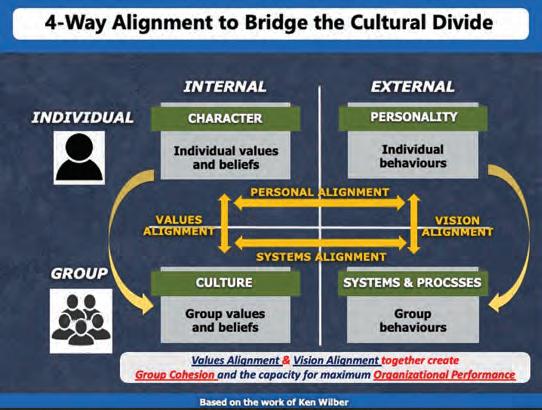

Melissa Low, CAE, is the vice president, communications & advocacy, for the Club Management Association of America (CMAA). For the latest information on these and other issues affecting the club industry, please visit CMAA’s Legislative Report blog at www.cmaa.org.
During the frenzied first five months of the year, the new Trump administration worked to rescind many regulations impacting the club industry.
In March, the Environmental Protection Agency announced its intent to revise the “Waters of the United States” (WOTUS) definition. This definition is key to the implementation of the Clean Water Act, delineating under what conditions property owners must obtain a federal permit from the Army Corps of Engineers before embarking on a project.
In a written statement, the EPA explained its goal to “move quickly to ensure that a revised definition follows the law, reduces red tape, cuts overall permitting costs, and lowers the cost of doing business in communities across the country while protecting the nation’s navigable waters from pollution.”
The EPA seeks to create a rule that fully conforms with the 2023 Supreme Court’s decision in Sackett v. EPA. The previous administration had updated the WOTUS rule following the decision but failed to address and define what it means for a water to be a “relatively permanent, standing or continuously flowing body of water,” or what it means for a “wetland to have a continuous surface connection.” Given this omission, considerable ambiguity remains for property owners who seek to understand where the water on their property is federally regulated.
The EPA outlined its revision plan, beginning with engaging key stakeholders, state partners and local officials, and focusing on clarity and creating an enduring and sustainable rule. It seeks feedback specifically on the definitions of “continuous surface connection,” “relatively permanent” and jurisdictional versus non-jurisdictional ditches. The EPA solicited public comments on the existing rule for 30 days through April 23 and held six listening sessions.
It is expected that a new rule will be released and take effect within a year.
In early May, the Department of Labor issued updated guidance on how to determine whether an individual is an employee or independent contractor to its field staff, signaling that it will not be enforcing the 2024 independent contractor rule. The DOL
plans to reconsider the 2024 final rule and is expected to make substantial changes.
The guidance directs field agents not to apply the 2024 rule and to instead focus on the DOL’s Fact Sheet 13 (version 2008) and Opinion Letter FLSA 2019-6. These documents focus on the “economic reality” as the distinguishing factor in examining the relationship. An employee “is dependent on the business which he or she serves,” and an independent contractor is a “person who is engaged in a business of his or her own.” Additionally, both documents highlight other factors that have been considered significant by the Supreme Court in litigation including:
• The extent to which the services rendered are an integral part of the employer’s business
• The permanence of the relationship
• The amount of the individual’s investment in facilities and equipment
• The nature and degree of control by the employer
• The individual’s opportunities for profit and loss
• The amount of initiative, judgment or foresight in open market competition with others required for the success of the individual.
During this transition period, clubs are advised to review the changes and be mindful of any existing state or local laws before determining employee/independent contractor classification.
In April, the Trump administration halted its appeal of the 2024 overtime rule. A federal judge vacated the rule in November 2024, invalidating the increased salary thresholds and triennial automatic updates. In December 2024, the Biden administration announced that it would appeal the ruling.
This nationwide decision restored the previously established standards of $35,568 annually (or $684 weekly) for exempt employees and $107,432 annually for highly compensated employees and suspended any further implementation of the 2024 rule.
With the suspension of the appeal, it is unlikely that additional overtime changes will occur as the Trump administration sets the previously established thresholds. BR


Every club has its bad apples, and lately, it seems more are falling from the membership tree than ever before. From verbal volleys on the pickleball courts to poor etiquette spats in the clubhouse, member misconduct is cropping up more frequently than it used to.
Exclusivity, tradition, community and respect are paramount to club culture, and maintaining a harmonious environment is essential to preserving a club’s community and reputation. While many clubs foster collegiality and mutual respect among their members, occasional breaches of their rules and regulations are inevitable in a close-knit community. When these breaches arise, a club’s grievance committee plays a crucial role in preserving the whole bunch.
In an ideal world, there would be no need for grievance committees. The reality is that grievance committees are almost universally necessary and serve a vital role in protecting their clubs.
Grievance committees allow clubs to address member complaints while safeguarding the broader interests of the club and its community. In today’s environment, where litigious members are more abundant than ever, a fair, objective and consistent grievance process is a hallmark of responsible club leadership. Clubs that prioritize this function are better equipped to preserve harmony, navigate conflicts, avoid litigation and sustain the distinctive character that defines their communities.
The importance of a grievance committee lies in its ability to manage member misconduct discreetly and impartially. In club environments, where personal relationships and long-standing social ties are often inseparable from governance, having an objective, well-defined grievance process is critical. The grievance committee should ensure that each complaint is addressed, investigated and handled objectively following established club policies, thus strengthening members’ confidence in the club’s leadership and reducing the likelihood of perceived favoritism or bias.
The importance of having an objective, consistent grievance process cannot be understated, as the absence of this increases the risk of litigation significantly. In one ongoing lawsuit, a member alleged that the club suspended his membership privileges for the same conduct as two other members who were not punished. He also alleged that his suspension was extended unilaterally by the grievance committee without a hearing or input from the board. If the club violated its written policies or did not apply a consistent, fair disciplinary process equitably, the club could be held liable for monetary damages.
In many clubs, the grievance committee serves as the first step in the disciplinary process after the club receives a complaint. Regardless of when the grievance committee is engaged, it must comprise impartial members who are not involved in the matter and conduct an unbiased and thorough review of a complaint. They generally gather statements from relevant parties, assess the applicable bylaws, rules and policies, review the evidence and present their findings and disciplinary recommendations to the board. When appropriate, they may also facilitate informal resolutions among the parties.
This process weeds out complaints that don’t require the board’s attention, saving valuable time and allowing the board to make informed decisions regarding the appropriate discipline. It also improves the level of fairness by increasing the degree of separation between the accused member and the board.
Additionally, except when provided otherwise in a club’s governing document, the grievance committee should function strictly in an advisory capacity to the board rather than as a final decision-making authority. In this structure, the ultimate authority to impose disciplinary actions, whether it be a formal warning, suspension or even expulsion from the club, would rest with the board. This serves to ensure that the grievance-handling process remains balanced, with the grievance committee providing impartial, fact-based guidance and the board retaining oversight and final authority for maintaining the club’s standards and integrity. In any event, all clubs benefit from having a well-organized, consistent and fair grievance committee process to help preserve the standards, civility and camaraderie that define clubs. Then, when the inevitable bad apple falls, it won’t spoil the rest. BR
Michelle Tanzer, Esq., is chair of the Global Club and Branded Residences group at the law firm of Nelson Mullins. She can be reached at (561) 866-5700 or Michelle.Tanzer@NelsonMullins.com
Ben Marton, Esq., is an associate in the Global Club and Branded Residences group at Nelson Mullins. He can be reached at (561) 343-6869 or Ben.Marton@NelsonMullins.com


John Corley is president of the Club Division at Jonas Software, a leading provider of enterprise management solutions for the private club industry. For more information, please visit www.jonasclub.com.
The club industry stands at a pivotal crossroads. As technology becomes the backbone of operations, shaping member experiences and streamlining staff workflows, clubs must reassess their infrastructure. The 2024 GGA Partners Club Leader’s Perspective report highlights this urgency, with 27 percent of club leaders identifying technology as a major challenge—a notable 9 percent increase from the previous year.
Your club’s technology infrastructure is only as robust as its foundation. Traditionally, on-premises servers have been the norm, but the shift toward cloud hosting offers a more scalable, secure and resilient solution. Cloud hosting not only reduces costs but also enhances security, simplifies maintenance and provides the flexibility needed in today’s dynamic club environment.
Why? Because cloud hosting isn’t just about saving money— though that helps. It also brings benefits beyond cost savings: high-level security, easy maintenance, flexible scalability and remote access. These are no longer “nice-to-haves”; they’re essential in a modern club environment.
As the demographic landscape evolves, clubs are welcoming a younger, tech-savvy generation of members and staff. These individuals expect seamless digital interactions and rapid access to services and platforms that function flawlessly, regardless of location. Cloud hosting meets these expectations by ensuring systems are accessible anytime, anywhere, on any device with a stable internet connection—something that on-premises solutions struggle to offer without significant cost and complexity.
An efficient staff translates to enhanced member satisfaction. Empowering your team with reliable, user-friendly tools not only boosts their productivity but also elevates the overall member experience. Cloud solutions alleviate the daily burdens of IT maintenance, allowing staff to focus on delivering exceptional service.
Clubs are now realizing that tech infrastructure isn’t just about member-facing features. It’s about empowering staff with tools that enhance speed, reliability and usability. Better staff experience leads directly to better service—and that’s what members ultimately notice.
An often overlooked piece of this puzzle is the IT administrator. These hardworking employees keep your tech running, and
for them, local servers mean daily upkeep, updates and stress. Cloud solutions typically come with managed services, shifting that maintenance burden away from in-house teams—and making the system easier to use across the board.
While transitioning to new technology can seem daunting, especially concerning costs and complexity, it’s crucial to view it as a strategic investment. Cloud hosting enhances the member experience through smoother booking processes, faster communications and robust data security. Moreover, studies indicate that clubs adopting cloud solutions can realize up to 70 percent savings over five years compared to traditional on-premises systems. Clubs often implement “behind the scenes” solutions that elevate the member experience without requiring them to adapt directly. Think about smoother booking processes, faster communications and more secure data— all powered by invisible, efficient infrastructure.
And then there’s the bottom line. Aging infrastructure and rising labor costs are two of the biggest financial risks facing clubs today. Jonas Club Software studies show that clubs switching to cloud hosting can save up to 70 percent over five years compared to traditional on-premises solutions. That’s not just a tech decision—that’s a strategic financial one.
Innovation is on the rise, with nearly 40 percent of clubs planning to implement new technology within the next one to three years. However, outdated infrastructure can hinder this progress. Embracing cloud hosting ensures your club is poised for growth, offering scalability, adaptability and minimal disruption—all at a significantly lower cost.
Upgrading on-prem systems year after year isn’t sustainable— either financially or logistically. Cloud hosting offers a way forward. It grows with your club, adapts to your needs and evolves with minimal disruption—and at a significantly lower cost.
The club industry is undergoing significant transformation. As member expectations evolve and staff dynamics shift, establishing a solid technological foundation is paramount. Embracing cloud hosting is not merely about modernization; it’s about building resilience, enhancing service quality and securing your club’s future in an increasingly digital world. BR
COREY SABAN
Corey Saban is an EMMY-nominated, AP award-winning journalist and speaker who has interviewed global leaders, covered landmark events and helped clients craft powerful stories that boost engagement and revenue. He is an expert in crisis communication. For more information please visit www.csmediaworks.com.

How often do we stop, as leaders, to say thank you? Not just to those who inspire or mentor us, but to those who challenge us and even those who don’t have our best interests at heart. I have learned that every encounter, even the hard ones, teaches us something.
There’s a saying: The best time to plant a tree was 20 years ago. The second-best time is today. A few years ago, I started tending to my own garden, not literally, but internally. I took the time to understand myself, recognize the gifts I have to offer and embrace the imperfections I used to hide.
It’s not about the New Year’s goals we set and forget every February. It’s about showing up consistently, learning from failure and staying rooted in ourselves. For years, I wore a mask. I showed up, helped out and made sure I was liked. Behind the agreeable smile was a tug-of-war between approval and authenticity. I became a people pleaser because I knew what it felt like to be left out, a forgotten face that struggled to fit in during the impressionable high school years.
Self-improvement is not a straight line. It’s letting go of who you thought you needed to be to become who you really are. It takes humility, patience and unlearning behaviors that you believed defined you. But here’s the thing: It’s worth it!
Then came a turning point in my growth. My friend, Joe, asked me if I would share this at the World Conference. I was hesitant. After all, this was not one of my usual topics, such as public speaking or crisis communication strategies. I was going to share my story of vulnerability and its role in leadership. The thought terrified me. However, like Brené Brown says, vulnerability is not a weakness. It’s the birthplace of courage. When we stop trying to appear perfect and lead with heart, we don’t just grow. We create the space for others to grow, too. For weeks, I obsessed over the content. Not because I wanted to be impressive, but because I wanted
it to matter. I wanted people to walk away feeling a little more seen. A little more hopeful. A little more ready to lead with heart.
Then came the moment I stepped on stage. The mask was off. I had pulled back the curtain on my inner world. Yes, I provided tangible takeaways to improve team dynamics, overcome communication challenges and ways to cultivate a culture of trust. Instead of my go-to self-deprecating humor (my armor), I leaned into the failures and flaws many of us often don’t articulate.
My inner critic challenged me as I looked at the many familiar faces of friends who came to support me. “Is this falling flat?” But then something unexpected happened. I realized their stillness wasn’t disinterest. It was presence. As my friend, Ed, later said, “People weren’t bored. They were leaning in, rooting for you, and remembering their own challenges. You weren’t just speaking. You were inspiring.” That hit me hard.
And here’s the part I’ll never forget. Afterward, people came up to me saying things like “That’s exactly what I needed to hear today” or “Thank you for saying what most of us are afraid to admit.” Someone even said, “You gave me permission to stop pretending.”
It turns out that when you stop trying to impress and start telling the truth, something beautiful happens: connection. Not everyone will clap, but the ones who need it will hear you. And that is what matters most.
Here’s how I get started, and you can, too.
Know Yourself
• Reflect on your values, beliefs, and leadership style.
• Understand your emotional triggers and how they influence your behavior.
• Regularly seek feedback to uncover blind spots. Communicate Transparently
• Be honest, even when the truth is uncomfortable.
• Share your thought process, not just the final decision.
• Admit mistakes and explain how you’re learning from them. Listen Deeply
• Make others feel heard by giving them your full attention.
• Ask open-ended questions, and don’t rush to fix or respond.
• Encourage dissenting opinions to build trust and better solutions. Align Actions with Values
• Walk your talk—consistency builds credibility.
• Make tough decisions based on principles, not popularity.
• Show others what integrity looks like in real-time.
Lead with Purpose
• Inspire your team by connecting daily work to a larger mission.
• Help others discover their own purpose within the organization.
• Lead with empathy, not ego.
• Know your team as people, not just employees.
• Celebrate their successes and stand by them in their failures. BR
Compensation for directors of racquets varies widely and is influenced by several key factors: club and staff size, geographic location, amenities, level of exclusivity, tenure, benefits and club comparative compensation. Clubs located in high-cost-of-living regions may need to offer significantly higher compensation to attract and retain top talent. Those undergoing capital initiatives or rapid racquet sports expansion may also budget more aggressively to bring in a proven leader.
Since the pandemic, compensation for directors of racquets has increased by an average of 35 percent, a well-deserved rise that reflects the complexity, popularity and expectation of racquet sports departments today. In fact, many experts now rank racquets as the second or third most important department in the private club sector, trailing only golf or food and beverage. And with some clubs reporting that up to 40 percent of new members cite racquets as their primary reason for joining, it’s no surprise that compensation is finally catching up to reality.
Let’s not sugarcoat it: Staffing remains the industry’s biggest challenge. Racquet sports may be booming, but the pipeline of qualified professionals is thinning. Up to 30 percent of today’s pros are expected to leave the industry within five years due to burnout, lack of advancement or unsustainable schedules.
from Racquets Reimagined - USTA | 31
tennis courts and facilities nationwide. It recently announced an additional $10 million in grants to help build, refurbish and extend playable hours on courts across the United States.
Perhaps the most important—and certainly most ground-breaking—of the three strategic pillars upon which the USTA is building its growth goals is an innovative approach to coaching. USTA Coaching, slated to officially launch in August, is designed to bring more coaches—and more diverse coaches— into tennis, while ensuring that those coaches are better educated, better compensated and Safe Play compliant.
“Coaches are integral to the health of our sport,” said Craig Morris, chief executive officer of USTA Coaching. “They are the ones most responsible for ensuring that players enjoy a great experience, regardless of age or ability level. A great coach is an invaluable asset—and a proven factor in keeping people in the sport.
“That’s why we’re making a commitment to supporting coaching by increasing the number of coaches and improving
The best clubs are responding. They’re creating salaried positions for assistant professionals, offering more predictable hours and carving out leadership roles like head pickleball professional or junior tennis coordinator to retain top talent. They’re building internal pathways for growth, ensuring every professional has a chance to lead.
Every year, the director of racquets should review and adjust the departmental org chart based on the club’s evolving needs and the team’s strengths. Promoting from within, assigning professionals to oversee different areas (e.g., junior tennis, adult pickleball, social events) and offering formal leadership titles are essential steps in showing that this is a career path, not just a job. Staff should be challenged to take on more responsibility and rewarded when they do. The message must be clear: We invest in people, not just programs.
We’ve seen clubs pour millions into new racquets facilities— beautiful pickleball or padel courts, heated platform courts, shaded pavilions, lighting and state-of-the-art technology. But as any GM will tell you, amenities don’t drive culture. People do. And it’s time to match our investment in talent with the same intensity we’ve given to physical space.
The clubs that do will be the ones that sustain this boom, not just for a season but for a generation. BR
the overall quality and expertise of this country’s coaching corps. We want more high school and college players to view coaching as a real and tangible career choice, encouraging them to create a successful career doing something they love.”
Another key focus is expanding the idea of what it means to be a tennis coach, as the USTA believes that coaching shouldn’t be limited to professionals. In so many other sports, including soccer, lacrosse and baseball, parents are often their child’s first coaches. So why should tennis be any different?
“Parents can play a big role in introducing their kids to tennis,” Morris said. “And we’re committed to providing them with the proper tools to make it easy—and fun—for them to do that. Including parents in a mix that also encompasses full-time and part-time coaches will allow us to get more young people in the sport and help set the stage for a lifetime of participation.”
And secure another important step forward toward 35 million players by 2035. BR

loved nicknames) features an open kitchen concept, built-in chef’s table counter, seafood/sushi/crudo station, Argentinian wood-fired grill, wraparound covered terraces, commanding views of the course and the Fort Worth skyline and 180 private temperature-controlled wine lockers. The chef’s table and featured stations are designed to fully maximize opportunities for experiential dining, a prevalent and highly sought-after offering not often found in clubs. The second-story concept, Leonard’s, is an homage to Leonard. The casual grill and bistro features an exhibition kitchen, wood-fired pizza oven, exhibition pizza station, charcuterie station, indoor-outdoor bar concept, patio dining, outdoor fire tables and commanding golf course and city views.
The first floor features the pro shop retail space, an indoor simulator room, a 19th-hole sports bar and a game lounge. This concept includes leather ceilings, a recessed bar, a video wall for state-of-the-art sports viewing, private humidors and an outdoor lounge patio and viewing deck.
In addition to the new three-story building, the adjacent and historic 65,000-square-foot clubhouse will be reprogrammed and renovated. The amenities include a 500-seat ballroom, private dining and meeting rooms, a spa, a barbershop, a remote work café and juice bar, private breakout rooms for video calls, casual work and networking spaces and outdoor terraces and patios with course views. The kitchen will be remodeled, and the
bakery will be relocated to serve the café better. To celebrate our rich history, a history hallway will connect the original clubhouse to the new three-story building. This hallway will feature a Hogan Memorabilia Room, with a custom-crafted trophy case and an impressive and extensive collection of golf memorabilia.
Future projects under design include Camp Colonial. This project will be home to family activities and events, Kids’ Care and the teen center—a playground for families to explore and enjoy aquatics, a cinema room, a gaming room and a casual-themed restaurant. Also under design is an indoor racquets facility for tennis, pickleball and padel.
Colonial is synonymous with championship golf and is home to Hogan’s Alley. The master plan appropriately celebrates our golf roots with an intentional nod to families and the future. The addition of modern amenities is tailored to meet the needs of today’s and tomorrow’s lifestyles. It isn’t meant to replace our rich golf history—it is intended to be accretive and to help sustain that legacy for generations to come.
Again, in honor of our founder, “Excellence and innovation know no completion.” BR
Frank Cordeiro is COO at Colonial Country Club, Fort Worth, TX. He can be reached via email fcordeiro@colonialfw.com. Henry DeLozier is a partner at GGA Partners. He can be reached via email henry.delozier@ggapartners.com

GCSAA Video Training Series as a tool for our members to use in teaching their teams golf course management basics.”
A more educated and trained staff is crucial for the success of golf clubs, and the videos are a free, key way to invest in people at your club and see long-term success.
Increasingly, members live hybrid lives: part office, part family hub, part retreat. They crave spaces that mirror this complexity. Smart clubs are designing “third spaces”—neither formal nor entirely casual—where members can plug in, read quietly or strike up a serendipitous conversation. These zones are less about design aesthetic and more about emotional intelligence. They say, “You belong here, in whatever mode you show up.”
GCSAA members can access the courses anytime, anywhere with a computer, tablet or smartphone. Videos, quizzes and interactive content are designed for a proven learning experience. Superintendents will have unlimited access to show the videos on their crews’ time and at their own pace. Make sure your superintendent is a GCSAA member so they can access these valuable training videos. BR
Design isn’t about erasing the past. It’s about carrying it forward, with intention. Heritage clubs shouldn’t fear evolution—they should fear irrelevance. When we pair architectural sensitivity with brand storytelling, we build not just beautiful spaces but meaningful ones. At its core, club design is an act of hospitality. It invites. It listens. It offers a frame, but leaves room for members to co-create the picture. In the next chapter of private clubs, it won’t be just the newest features or grandest renovations that matter. It will be how thoughtfully space allows people to feel part of something larger than themselves. Because in the end, it’s not the walls that define a club. It’s the life that flows between them. And that life begins with belonging. BR
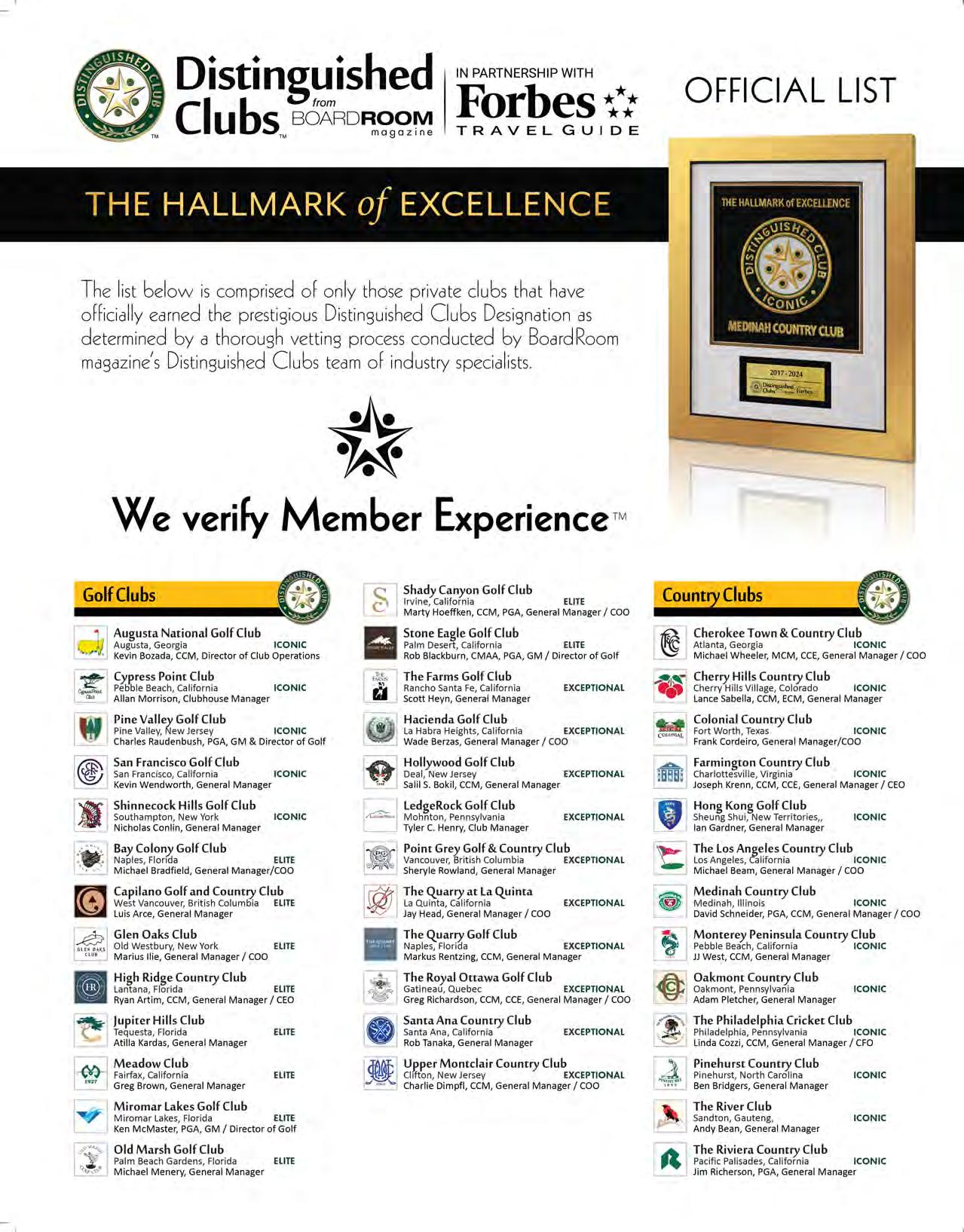
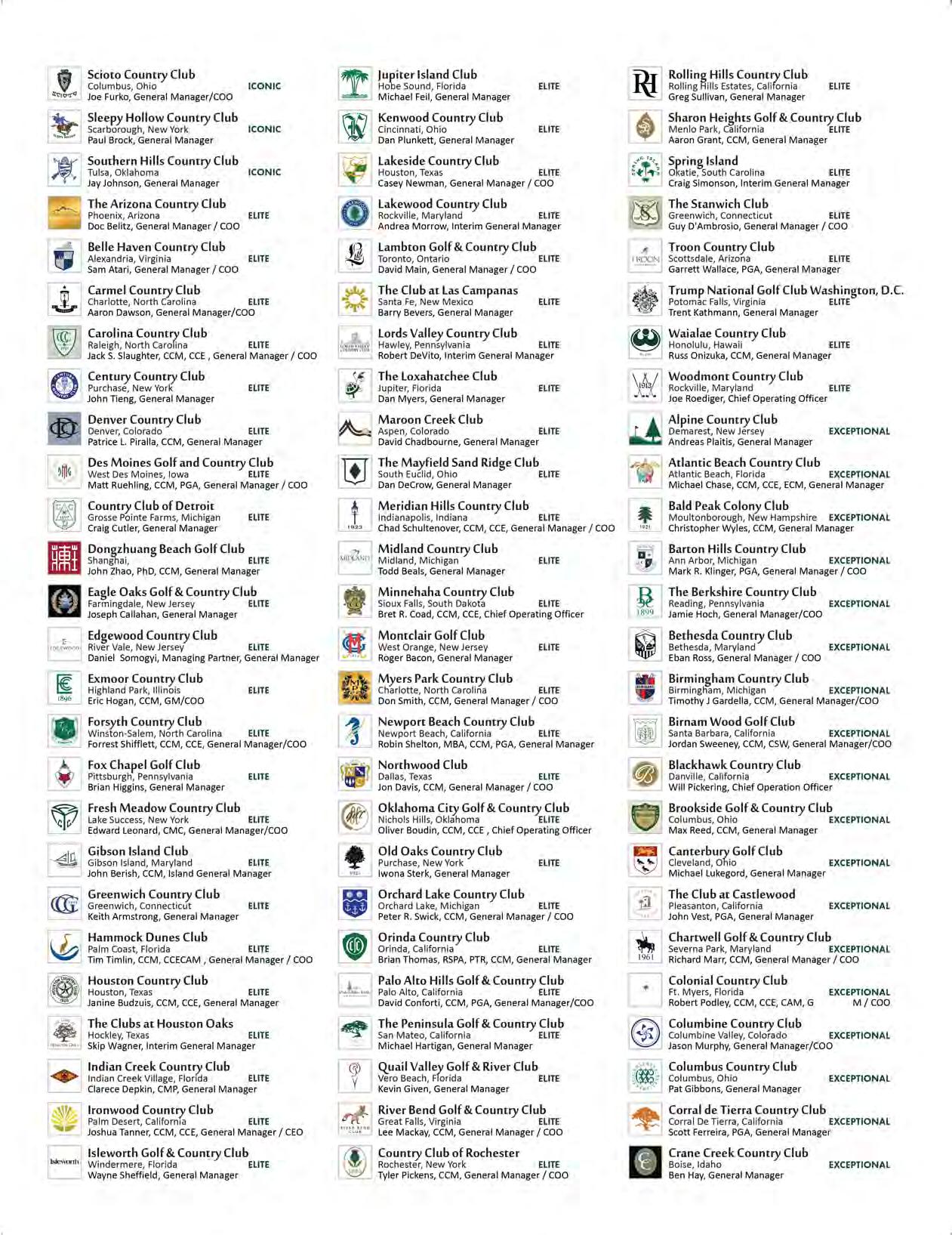
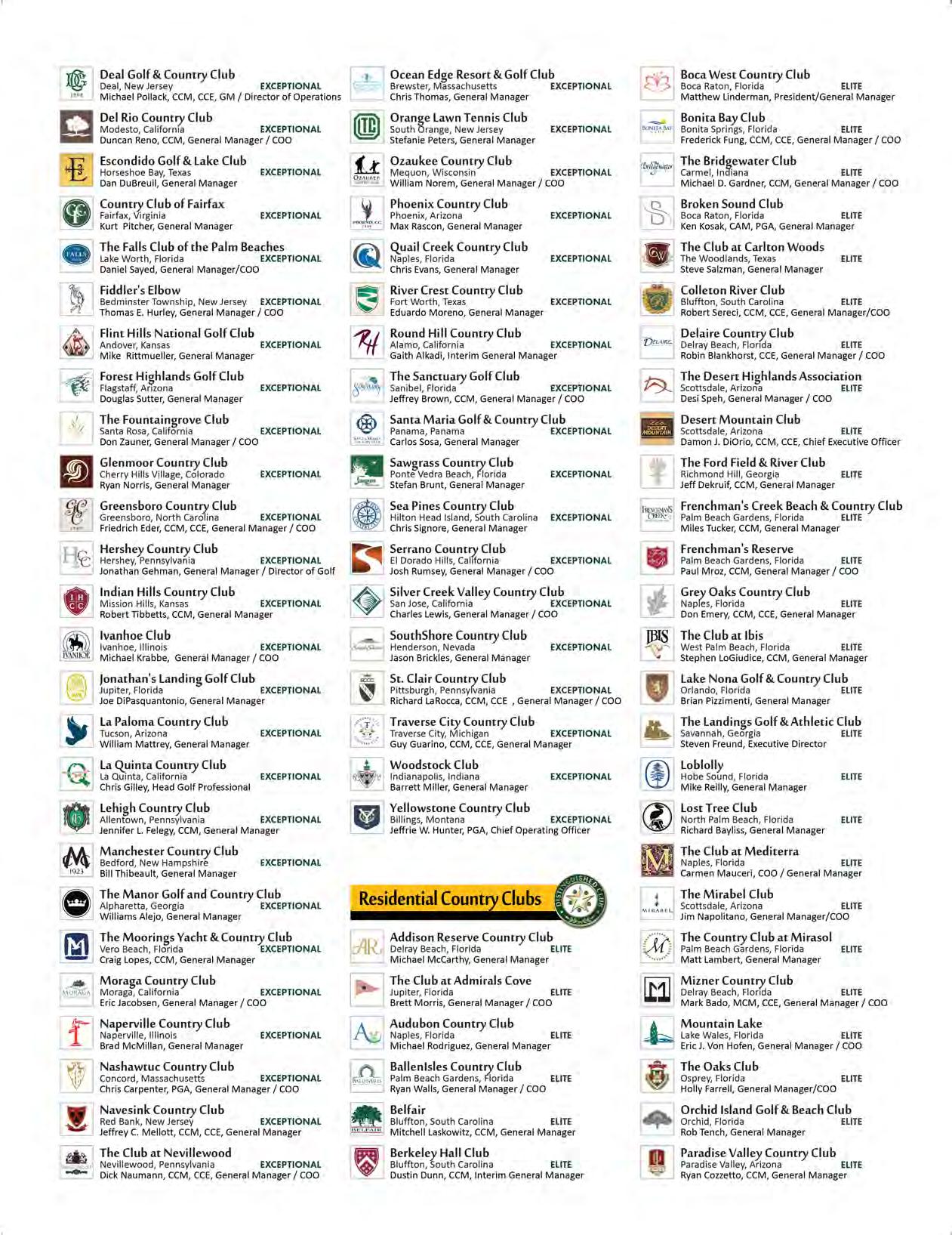


Yes! It says you’ve done the hard work. You’ve delivered an extraordinary Member Experience—and you’ve earned the recognition to prove it.
The top industry leaders noted below recognize and endorse Distinguished Clubs as the Hallmark of Excellence in the private club industry.
It is the only verified, merit-based designation that evaluates the Member Experience across all aspects of club operations.
Achieving Distinguished Club status isn’t given—it’s earned through the leadership, dedication and performance of you and your entire team.
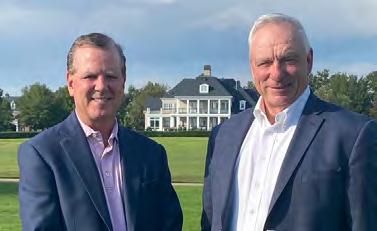
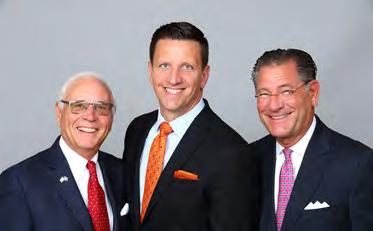




Distinguished Clubs is the only merit-based designation program that recognizes private clubs and their management for the outstanding delivery of an extraordinary Member Experience. www.distinguishedclubs.com. For more information contact Ron Banaszak, ron@boardroommag.com

GREGG PATTERSON
Gregg Patterson is founder and president of Tribal Magic. He can be reached via email: GJPAir@aol.com
The Beach Club has had a tough time lately. Fires in the Palisades destroyed 85 member homes, the clubhouse was closed for remediation, a great manager resigned to focus on family and a longtime, much-beloved employee died unexpectedly—way too early, way too young. Sad times. But strangely and magically, these tough times became a great time to affirm relationships and experience community. A great time to feel the love. A great time to experience club. Let me explain.
Our beloved Felicito—head bartender for 33 years—died unexpectedly and tragically. Knowing that members cared deeply and needed to gather and remember, the board booked a celebration of life for early January. But the Palisades fire hit, members lost their homes, the Pacific Coast Highway was closed, the clubhouse was shuttered and the Beach Club community descended into a period of sadness and introspection.
And the celebration of life was postponed. Tough times. Togetherness was needed. Relationships were needed. Community was needed. Club was needed.
Many thought the celebration of life would be cancelled and forgotten amidst the overwhelming tragedy of the Palisades fire. But the board knew that closure was needed and decided to reschedule the memorial—hopeful that the highway would reopen, the clubhouse made safe, the staff would return and the members would attend.
To everyone’s surprise, over 500 members and more than 60 staff showed up to remember the man and his values. The details of the memorial were straightforward and uncomplicated. A quick welcome was given, a few scheduled speakers spoke, then members and staff in the audience—past presidents, past members, current members, past staff and current staff—were singled out and asked to speak and to reminisce.
After an hour and a half of sharing, the memorial ended with a collective cheer for the man—after which everyone retreated to the patio for refreshments and to share more memories.
But the facts of the memorial paled beside the emotions we experienced and the spirit of community we witnessed. What Felicito did in those 33 years was to remind us about the power of personality and the magic of club.
How did this love happen? What did Felicito do to generate such deep affection? How did he go from employee to honored member of the Beach Club family?
Those who spoke captured the why of his magic, the why he was beloved and the why he was remembered.
“I have no idea why I hired him 33 years ago, but I suspect his smile had something to do with it.” And everyone cheered.
“Felicito had people love—he loved meeting people, he loved good conversation, loved talking to everyone, loved telling stories, always laughing, always positive, always engaging and always interesting.”
“Felicito had club love—he loved the Beach Club, loved the members, the staff, the clubhouse and the history. You could see it, feel it, hear it and experience it whenever you met the man.”
“He had ‘loyalty genes’, a staffer for 33 years, and because of those years, he knew everyone and everyone knew him.”
“Felicito did bartender really, really well. He mixed a good drink, got it to me quickly, knew what I wanted when I wanted it and could talk about the what, where and when of the dark rum I was drinking. Loved the guy.”
“He was always positive and upbeat and oozed enthusiasm for the club, the membership, the staff and the job. Loved the guy.”
“Felicito enjoyed doing things for people and making them feel good, and when they felt good, he felt good, and he always showed his joy in ‘doing good’ with a smile, a comment and a chuckle.”
“Whenever I visited the bar, Felicito was always visible, focused on me, in the moment, delivering the big welcome with enthusiasm.”
“Felicito was a world-class listener, interested and attentive regardless of what I was talking about or how long I did the talking.”
“When I became a member, I was a stranger to everyone. But I quickly got to know Felicito, and he became my connector. He introduced me to members and staff, gave me a bit of background about everyone I met and gave them a bit
of background about me. And he told me, a newbie, I’d never be alone again.”
“He made me feel like I was his very best friend, but I discovered today that everyone who knew him felt they were Felicito’s very best friend.” And everyone cheered.
“He was a caring person, a shoulder to lean on, always understanding, ready to give comfort. Felicito cared that you arrived, cared that you were happy, cared when your kids graduated, your relatives visited, cared when you experienced a failure or a loved one died.”
“He was a reader and super interesting because he read lots and wanted to talk lots about the books he’d read.”
“Felicito was the ultimate ‘insider’ and could give you the inside scoop on everyone and everything. He knew lots about the building, the services, the staff and the members, and he enjoyed letting you know ‘what is’ and ‘why.’ ”
“He enjoyed working at my house and making hospitality happen during the holidays.”
“He gave the love and because he gave the love, he got the love.” And everyone cheered—and cried.
Lots of memories, lots of stories from lots of people.
Felicito wove his way into the hearts of the Beach Club family. The life he lived as a staffer and a friend and the joy he gave every day made him special, beloved and one of the fam-

ily. This celebration to honor his life was an example of and a testament to that beautiful, elusive, precious thing called club.
Felicito’s memorial dramatized the emotional bonds that can exist between members and members, members and staff, and staff and staff when there’s club in the clubhouse.
These bonds are the powerful engines of community, retention and usage. Bonds such as these transcend the cost of membership, the services provided, the facilities delivered and the activities that are organized—and are, ultimately, the drivers of financial KPIs.
Moments of shared tragedy can bring people together or fling them apart. What we witnessed that day, amidst the tragedy of the fire and Felicito’s passing, was a type of emotional bonding no marketing campaign could create, no outside consulting professional could generate.
What we felt and what we learned that day are lessons for ours and every club community searching for this elusive, powerfully emotional bonding experience called club.
We often talk about the virtues of club, but a moment like this dramatizes those mystic bonds of clubdom, the emotional cement that welds a community together and affirms through example what a great club family is and does.
Find staff who generate the love.
Find members who appreciate being loved and giving the love. Build a community of caring.
And enjoy the journey. BR
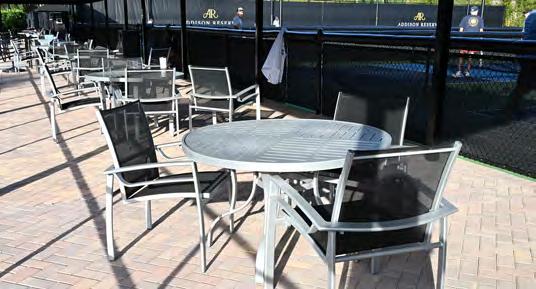
Xhibtz Contract Furnishings is elevating outdoor spaces at The Country Club at Mirasol and Addison Reserve
At Mirasol, the tennis area features sleek, hidden inground umbrella mounts paired with USA-made Fiberlite umbrellas for seamless shade and sophistication. At Addison Reserve, the pickleball courts are surrounded by durable, stylish, and comfortable outdoor furnishings, perfect for relaxing between matches or enjoying the game from the sidelines.
Let Xhibtz elevate your club’s outdoor spaces with premium, American-made solutions.



“It is through committee service that board members get their understanding of club governance. When a member gets to the board, they already have experience in the club’s governance; they already understand how everything works together (GM/board relationship, committee/board structure, etc.). Then they receive specific board orientation.
“We also recommend including governance education as part of new member orientation so new members get some insight into how the club operates. This develops the ownership mindset (rather than the customer mindset). This way, they can begin to think like owners from day one, where volunteerism isn’t optional, it’s expected,” the trio added.
“Without a good orientation, you have disorientation. With an untrained board of directors, you have a lack of understanding of roles and responsibilities. You also have significant legal consequences. If something happened and you have an insurance challenge, without appropriate board education, your claim could be denied. This is a tremendous liability.
“If there’s no board orientation, you likely just repeat whatever you did last year. It’s especially important for GMs to use board orientation and board policy manuals to get people up to speed quickly and consistently. This also helps avoid repeating everything (all the fundamentals) year after year.
“The lack of alignment from just one board member can take an entire board off course. It can lead to frustration for the GM and staff. It can dramatically slow down the club’s progress. If boards aren’t aligned, it’s easy to stop the club’s momentum,” the KK&W partners maintained.
“It’s important that the process be intentional and take place before a board member’s term begins and their first board meeting. Training cannot, and should not, be rushed, even if it means training needs to be accomplished over several sessions,” intoned Medinah’s GM Schneider.
“Training should include a full review of:
• Roles and responsibilities of board members and staff
• Status of the current strategic plan
• Board goals and objectives from the previous and current year
• Committee charters
• Goals and initiatives of the general manager and their team
• A complete financial overview, including operational and capital budgets, as well as a five-year proforma on membership levels by category.
“The more time that is spent focused on preparing a board member during the front end of their term, the more effective and productive their service will be for the club,” he added.
“Board member training should be done as new board orientation over a day or more at the club or as a retreat,” stated Scott McNett, managing principal, Midwest Office of GSI Executive Search, based in St. Louis, MO.
“The orientation should include a complete tour of the club, review of all board minutes, financials, capital planning, longrange strategic plan, organization chart and review of staff/ department head roles and responsibilities. Ideally, this would
also include a board policy manual. The orientation can also include a section on club best practices, which highlights the proper roles of both staff and the board.
“If this practice does not happen, the club has the risk of the board taking extended time to get up to speed and understand their roles. Micromanaging would be a likely outcome without board training.
“The club board members should still go through this orientation even if they have served on other boards because a private club board is a unique and different business that they will not be familiar with,” McNett added.
“It takes a confident general manager who understands their role to set the tone for effective governance. Forward-thinking leaders know that board member training isn’t optional—it’s essential,” emphasized APCD’s Welch. “A GM/COO should sit down with each incoming board and explain why this training matters, making it clear that participation is expected from everyone.
“Board training should cover governance fundamentals and help members understand how operations run within the club. It’s the GM’s job to ensure that operational matters flow through management, not the board. The board’s role is to govern, plan for the future and provide the GM with the tools and resources needed to manage the club, staff, facilities and daily operations.
“Just as importantly, the board should support the GM in front of the membership and have their back when challenges arise. Trust, clear communication and mutual understanding are critical to this relationship,” Welch added.
“Training shouldn’t be a one-time event at an annual retreat and then forgotten. It should continue throughout the year, integrated into monthly meetings with short video updates, department head presentations, or white papers. Learning what it takes to be an effective 501(c)(7) board member is not a box to check; it’s an ongoing process that keeps the board focused on what matters most: leading the club forward,” Welch stressed.
But why should a successful club member who has sat on many boards, including those of for-profit companies, still go through training for a 501(c)(7) board?
“First, it’s important to note that the mission of a 501(c)(7) club is very different than that of a for-profit company. The mission of a member-owned, tax-exempt club is to create experiences for pleasure, recreation and other similar nonprofit purposes for its members, operating with a break-even financial model. The purpose of a for-profit entity is to make money,” exclaimed Medinah’s GM Schneider.
“Serving successfully on a for-profit board does not necessarily mean a member will be equally successful on a member-owned, not-for-profit club board. For example, they might approach it with the mindset of ‘With my experience, I can make food and beverage more profitable’, while losing sight of the fact that the true goal isn’t to make or lose money in a certain area of the club, but to create experiences so valuable that members are happy to pay their monthly dues to enjoy them.
“Our 501(c)(7) board members must approach any kind of decision making with a mindset that begins with ‘How does this decision impact the overall membership experience in both the short- and long-term?’” Schneider commented.
And as Gordon Welch explained, “If you want to sit on a club board, you need to do your homework.
“Start with the basics: know the difference between a 501(c)(7) and a 501(c)(3). It matters. The rules are different, the way decisions are made is different and what success looks like is different.
“Governance doesn’t look the same in every business, and clubs are no exception. If you’re going to devote your time to serving, then really serve. Read the bylaws. Learn the pro cedures. Understand what your role is—and what it isn’t,” he emphasized.
“Here’s where many boards get into trouble…” Welch explained, “crossing the line into micromanagement. When board members start getting involved in daily operations, they shift from leading to interfering. It may feel like you’re helping, but in reality, you’re slowing down the team you’ve hired to do the job.

“A board’s job isn’t to run the club day-to-day. It’s to look ahead, plan for the future and keep the club moving forward. It’s about governance, not operations. The best boards focus on strategy, embrace necessary change and protect the long-term health of the club for current and future members,” Welch injected.
The KK&W partners suggest, “There are several reasons every board member should still go through education regardless of how many for-profit or non-profit company boards they’ve been a part of:
1. Club boards are different.
2. Every club business model is slightly different.
3. Every club’s committee and board structure is slightly different.
4. Every club has its own financial situation, is at a different place with its capital reserve study, etc.
5. In clubs, the GM actually reports to the board of directors.
“One of the biggest mistakes we see happen is when a person thinks that because they sat on the board with the Boys and Girls Club of America, they’ve sat on the board at XYZ Country Club. They are very different.
“For example, in what business is your board your boss? When you’re on the board at Apple, you don’t show up and tell Tim Cook how to build iPhones, but that happens in private clubs. At private clubs, you have to fully understand how to play well with the group, what your specific roles are, and communicate well.
“And no, it’s not enough for the GM to do all the governance education,” they accentuated.
“Using tools like Boardroom Institute is great. The current president or the immediate past president needs to be part of the board development.
Often, one reason annual board orientation doesn’t happen is because younger/inexperienced managers don’t have the gravitas to stand up in front of nine to 12 successful businesspeople and say, “I’m going to teach you how to…”
“So, board development just doesn’t happen. As the GM gets more comfortable and gains more experience, they can begin to conduct more of the board educa-
Specializing in GM/COO, CEO, AGM, Clubhouse Management, F&B, Financial, Golf, Culinary, Agronomy, Racquets, HR, Fitness & Wellness, Membership, Marketing, Recreation & Activities Director searches.
Engaging an Interim Executive Leader ensures operational stability, empowers the board, and strengthens the executive search process, turning a challenging transition into a strategic opportunity for long-term success.
Our Board Dynamics/Model has been presented to over 1000 private clubs and communities. Our best practices are respected and regularly highlighted by the leading industry publications and associations.
tion. As part of the development, the GM and club president can cover the cultural specifics. Still, it makes sense to use tools like Boardroom Institute, which has club-specific videos and resources,” The KK&W partners added.
“Absolutely not,” is the response from GM Schneider. “This type of training is a team effort that involves several other constituencies for the best chance of having a cohesive and effective board.
“High-functioning boards include the president and fellow officers being involved throughout a majority of the onboarding process. One example of the importance of this is in explaining the roles and responsibilities of the staff and board. (Staff is responsible for the day-to-day operations and the board is responsible for mission and vision.),” Schneider added.
“If this message came solely from the general manager, new board members might feel I intend to tell them, ‘To stay out of my business and do not micromanage me and my staff.’
“If that message comes from the club’s officers and president—explaining that experts have been hired to manage day - to - day operations, and that the board’s role is to think strategically five to 10 years ahead about who the club and its membership aspire to be—then the club wins,” he emphasized.
DeLozier agrees that the training shouldn’t come solely from the general manager.
“No, definitely not. Most general managers are well-versed in club governance; however, they are of service to the board members, who sometimes view the manager as a subordinate.
“The most advisable approach is to call on proven and experienced third parties that can provide independent guidance and objectivity to the training process,” he said.
“Board members can’t lead well if they aren’t trained well. It takes a mix of outside experts, industry professionals and the general manager—along with senior staff—to make that happen,” Welch stressed.
“Board members need to know who the senior staff are and what they do. They should be asking, ‘Do you have what you need to do your job well?’ Too often, board members never take the time to sit down with the people who keep the club running every day.
“Great leaders understand they don’t have all the answers. They bring in respected voices from the industry to help train the board, share best practices, and drive home key points. It’s about giving your board the knowledge they need to serve effectively—and the confidence to stay in their lane while supporting those who keep the club strong,” Welch added.
“We are very supportive of clubs using board portals. We’ve seen them work really well for some clubs. Again, these are especially helpful for younger managers who don’t have a lot of experience,” explained the KK&W partners.
“Using Boardroom Institute can be a great support mechanism to help make the point of why you need a foundation of
best practices and what the board needs to understand before operating.”
BoardRoom Institute offers specialized training and resources tailored to the needs of private club board members, focusing on governance, leadership and operational excellence, including:
• Online Learning: Comprehensive courses on governance, fiduciary duties and strategic planning.
• Workshops: Interactive sessions on best practices and current trends in club management.
• Resource Library: Articles, guides, and templates to support board members in their roles.
• Consulting: Tailored advice and training for specific club needs.
“Numerous kinds of board portals are available and have other tools embedded, so incoming board members can watch the videos and test for their understanding on their own schedules. Board portals are also beneficial because they keep a digital trail, so you have documentation of engagement for insurance purposes,” they stressed.
“At Medinah, our new board member orientation is a culmination of 25-plus years of evolution. This program will remain flexible, adapting to align with our industry and the club’s needs,” explained Schneider.
“I’ve taken bits and pieces from a wide variety of sources, but not limited to; other general manager’s programs, the various clubs I have had the pleasure to work at, more than 25 different club presidents, and countless education sessions and articles written by the likes of BoardRoom magazine, Club Managers Association of America, the PGA of America, Kopplin, Kuebler & Wallace, Global Golf Advisors, the McMahon Group and others.
“I am always willing to share best practices and examples of how we’re applying this approach and mindset within Medinah’s current program, which is my way of thanking all those who assisted me over the years. Please don’t hesitate to email me at dschneider@medinahcc.org, as I would be honored to pay it forward,” he concluded.
One factor that remains constant is the club’s need for strong governance—the requirement to have effective committees and a well-functioning volunteer board of directors working in collaboration with the paid management. Educating committee and board members is crucial for effective governance and leadership.
Because club governance is unique, board education without industry-specific knowledge can often result in ineffective governance and poor decision-making. Clubs encounter challenges when committee and board members lack proper training.
Boards often become window dressing, which can lead to situations where board members start micromanaging man-
agement, there are conflicting agendas and board dysfunction that impede daily operations.
Undoubtedly, one of the most valuable investments a club can make isn’t the golf course or the clubhouse. Instead, it’s investing in the development and education of your club’s committee members and future board members. Investing in governance training and industry knowledge, especially for committee members who may become board members or the president, as well as implementing an effective orientation strategy, strategic planning and conducting a governance audit, is necessary.
This is truly important because the committees are primarily advisory to the board, and the effective use and nurturing of the committee structure fosters a necessary “sense of community” that gives members a way to participate in their club’s governance.
All too often, upcoming committee members need additional supervision, training, or development to prepare them for future roles as board members, including executive positions.
Additionally, educating and training nonprofit board members is essential because their performance directly affects member satisfaction, employee morale and the club’s overall success.
Training on the club’s governance principles, board best practices and effective communication fosters a more cohesive and high-performing board that can navigate complex issues and provide strong leadership.
Here’s why board education is so important:
• Fulfilling fiduciary responsibilities: Board members have legal and ethical obligations (duty of care, duty of loyalty, and duty of obedience) to act in the organization’s best interest, manage assets prudently and ensure compliance with all applicable laws and regulations. Training helps them understand these duties and avoid potential liabilities.
• Enhanced decision-making: Welltrained boards are equipped to make informed and strategic decisions, crucial for guiding the organization effectively and adapting to changes in the operating environment.
• Maintaining members’ trust and reputation: Nonprofits rely heavily on the trust and support of their members. Proper board training reinforces accountability and ethical conduct, reassuring stakeholders and strengthening the club’s reputation.
• Enhanced organizational performance: Training committee and board members with essential skills and knowledge, especially in areas such as financial management and strategic planning, directly boosts overall organizational performance and success.
• Navigating a changing environment: The nonprofit sector faces changes in regulations, fundraising strategies, and technology. Continuous training helps board members to stay informed about these changes and adapt to new challenges and opportunities as they arise.
• Increased board engagement and retention: Well-structured orientation and ongoing training can improve board members’ understanding of their roles, promote a sense of belonging and confidence, and ultimately result in greater engagement and dedication to the organization’s mission.
• Successful succession planning: Board development initiatives, including committee training and mentorship, help identify and prepare future board leaders. This also ensures a smooth transition during leadership changes.
Investing in the education and training of nonprofit board members is a strategic investment in the organization’s future. Practical board training clarifies the roles and responsibilities of committee and board members, improves decision-making, fosters member trust, and ultimately leads to a more effective organization dedicated to its mission of member satisfaction.
At least, that’s the way I see it. BR
John G. Fornaro, publisher


Followers come in second.
Change waits for no one. Don’t sit back. Work with future-focused private club advisors who embrace technology-driven strategies, so you can take charge of change. rsmus.com/privateclubtrends
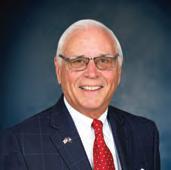
DICK KOPPLIN
Richard (Dick) M. Kopplin, CMAA Fellow, is a partner with Kopplin, Kuebler and Wallace, a private club industry executive search and consulting firm. You can reach Dick via email: dickopplin@aol.com
It’s No Accident: Model Clubs Are Serious About Their Mission Statement; You Can Bet on It!
In my “Board Dynamics/Model Clubs” seminar, I ask for a volunteer board member with a golf handicap of 20 or higher to raise their hand. I then select this volunteer as my “golf student,” and I make the following wager to the rest of the board members.
“I will bet anyone in this room one hundred dollars (and I toss my money clip with at least that amount to another board member to verify and hold) that I can have Joe, my golf student volunteer, my 20 handicapper, hitting to the pin on the 18th hole from 75 yards, with more accuracy than Rory Mcllroy. Any of you in this room can take Rory by wagering your hundred dollars against my golfer, Joe, and we will take Rory and Joe out to the 18th hole at the same time.”
Typically, I will have at least one board member who will gladly take the opportunity to bet on the legendary Rory against my high handicapper, Joe.
After I have secured the board member who accepts the wager, I tell him the “rest of the story.” I am going to take Joe, my high handicapper, along with a bucket of range balls, out to the 18th hole to make sure that he can physically hit the golf ball onto the green from 75 yards. Then I am going to take your guy, Rory McIlroy, and I am going to blindfold him and spin him around a few dozen times. Then I ask, “Do you still want the bet?”
“Of course not,” will be the typical response. And I agree with you withdrawing from such an unreasonable bet. After all, how do you expect someone to hit a target they can’t see?
But I have an even better question for you. How do you expect your club general manager to hit targets they don’t even have? How do you expect your club department managers to achieve goals they don’t know about? And most importantly, how do you expect to lead this club as board members if you don’t know what direction your club is taking?
If you don’t have a mission statement and clearly defined supporting goals for your club board, you will be like a blindfolded, dizzy Rory McIlroy, popping off balls in any direction and hoping that some of them might come close to the target. “Model clubs” have taken the time to develop a meaningful mission statement that continues to be a guiding light for successive boards.
Let me share with you a couple of club experiences that underline my premise that mission statements and supporting goals form the foundation for true success in model clubs.
While meeting with a recent search committee, a committee member who had also served as a past club president was adamant about the importance of the club’s mission statement. He was emphatic that prospective club general manager candidates should understand how important the club directors viewed the mission statement and supporting goals.
This club has enjoyed great success in a competitive environment in its Southern California market. The club president would credit the mission statement and supporting goals for the club’s ongoing success.
The second story I want to tell you is about a small club that had financial problems and was ready to sell the course to a home developer. Then the club discovered the power of the mission statement and supporting goals.
After the club formed an ad hoc committee to craft a mission statement, it proclaimed the new statement to the entire membership and published a list of supporting goals. Each club committee developed its own set of supporting goals, which fed into the club’s mission statement.
The net result of this goal-oriented planning was a complete financial turnaround. Within one year, the crisis was over, and within two years, the club was on solid footing, with nearly full membership. Today, the club enjoys a waiting list for new members and a new clubhouse that is the envy of every club in the city.
The model clubs that set themselves apart in the private club world are the clubs that have clearly defined their mission statement and supporting goals. For the board, committees and the management team. They will thrive regardless of the challenges the economy or competition may present, and they will achieve the goals they have defined in a carefully crafted plan.
If your club develops an appropriate mission statement and supporting goals, you will also enjoy the success of the model clubs. This much I know for sure. BR
Creating your club’s road map to best-in-class facilities while ensuring transformative change to the overall member experience and clubhouse operations.




Club Data Services is revolutionizing how private club leaders use data to increase revenue, cut expenses, and make strategic decisions around sales, marketing, and member experience.
“Every club wants to be the best, and Club Data Services can help make that happen!
If your club’s mission statement mentions being the best or delivering an outstanding member experience, then Club Data Services is exactly what you need. Their dashboards empower clubs and the teams that run them.”


A crisp uniform speaks volumes about your organization. From elegant – to timeless classic – to crafted excellence. If Quality, Presentation, and Customer Centric Service are important to you, we’ve got you covered.



Running a board election, bylaw vote, membership survey, or capital expenditure approval? SBS makes it easy. Our secure, professional voting solutions help clubs meet governance needs with confidence – without the extra workload or second-guessing.



Range & Bearing’s specializes in designing custom apparel and accessories that embody the outdoor lifestyle. Each distinctive piece reflects your identity on the water, the course, or wherever your passions take you.







Xhibtz products are made in the USA. We offer a wide range of outdoor dining and patio furniture umbrellas, custom outdoor cushions, and pool furniture to meet all your needs.






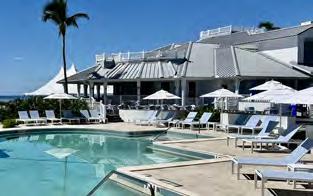











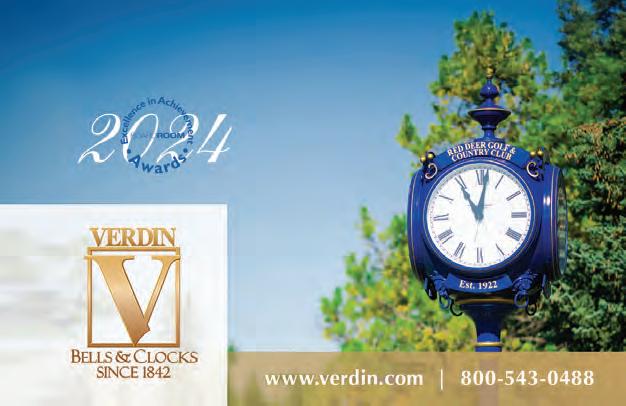




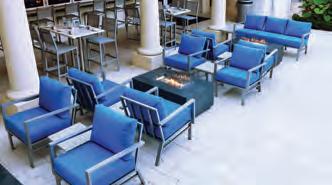
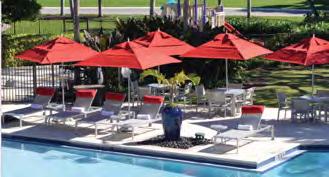



BOARDROOM MAGAZINE ADVERTISING INDEX
CLUBS AND PEOPLE MENTIONED
Alex Caldwell, CRSE, head racquets professional, Philadelphia Cricket Club
Kris Butterfield Cance, director of people and culture, La Cumbre Country Club
Jarrett Chirico, DCA, director of racquets, Royal Oaks Country Club and president of The Directors Club
Peter Cizdziel, GM/COO, Venice Golf and Country Club
Frank Cordeiro, GM/COO, Colonial Country Club
Cynthia Gilcrest, President, Venice Golf and Country Club
Ray Halbritter, PGA, Nation Representative Turning Stone Resort
Brad Hauer, GM, Hammock Beach Resort
Mervin Ho, CEO, Spring City Golf Resort
Jenice Jacinto, clubhouse manager, Visalia Country Club
Bonnie J. Knutson, member, Country Club of Lansing and Michigan Athletic Club
Lori LeBard, assistant general manager, Atlantic Fields Club
Nancy Levenburg, member, Spring Lake Country Club
Matthew Linderman, GM/COO Boca West Country Club
Damien McHugh, GM, Vattanac
Executive Chef Nu Morakotjantachote, Union League Club of Chicago
Brock Orlowski, MBA, CDORS, RSPA, PPR, RPO, Padel MBA, LSA, SETS, DCA, director of racquet sports, Fort Wayne Country Club
Kainoa Rosa, DORS, MBA, Director of Racquets, Palm Beach Country Club
Dave Schneider, GM/COO, Medinah Country Club
Craig Sloane, GM, Altadena Town & Country Club
Weng Peng Soing, GM, Hoiana Shores Golf Club
Steve Vlahos, general manager, Mission Viejo Country Club
Richard Wade, director of squash & padel, Philadelphia Cricket Club.
Rob Warren, President, Mission Viejo Country Club
Christina Wynn, director of communications, Pinehurst Country Club, Denver, CO
American Yacht Club
Annandale Country Club
Athenaeum at Caltech
Bonnie Briar Country Club
Carriage Club
Country Club of Spartanburg
East Bank Club
Florida Yacht Club
Granite Club
Greenbrier Sporting Club
Hunters Run Country Club
Johnathan Club
Missouri Athletic Club West
North Palm Beach Country Club
Oakmont Country Club
Panther National
Quail Ridge Country Club
Saddle & Cycle Club
San Gabriel Country Club
Sebonack Golf Club
Shadow Wood Country Club
Stanwich Club
The Beach Club
The Beach Point Club
The Briar Club
The Country Club of New Canaan
The Denver Athletic Club
The Preserve Sporting Club & Resort
The Racquet Club
The Toronto Cricket Skating and Curling Club
The Toronto Lawn Tennis Club
The Badminton and Racquet Club
Turks and Caicos Sporting Club
University Club
Valley Hunt Club
Woodfield Country Club

